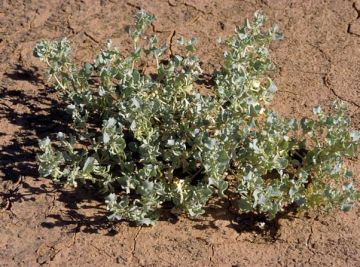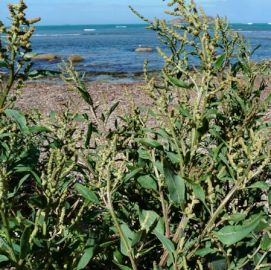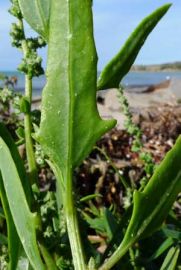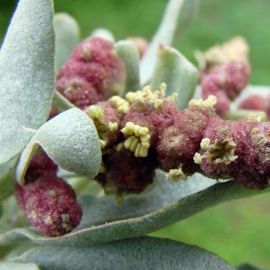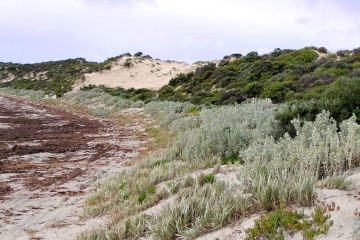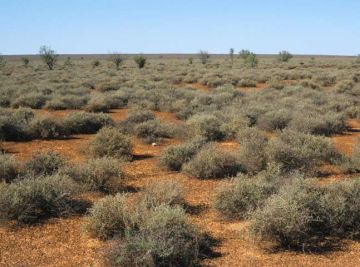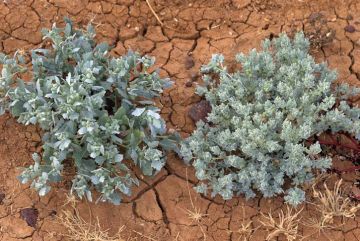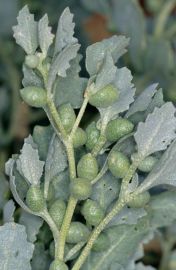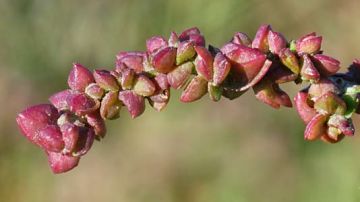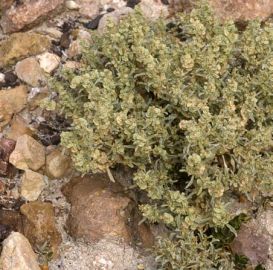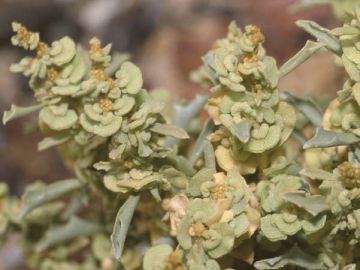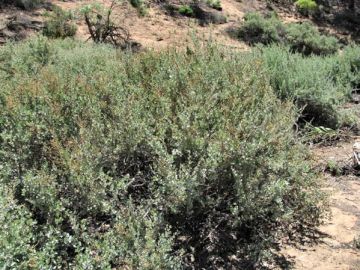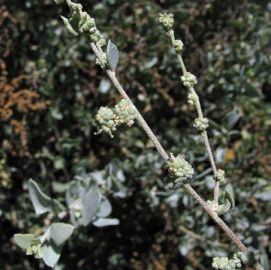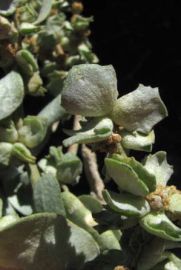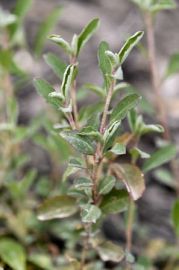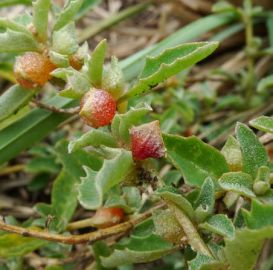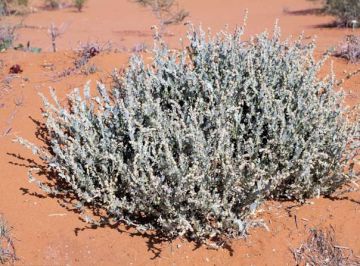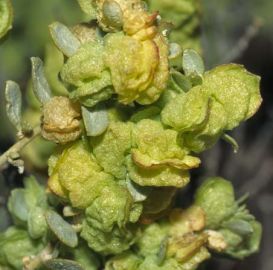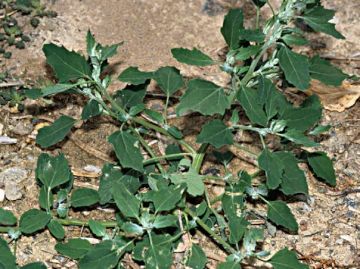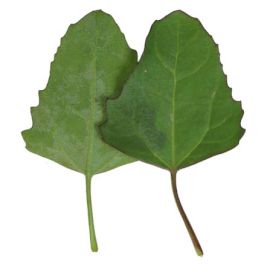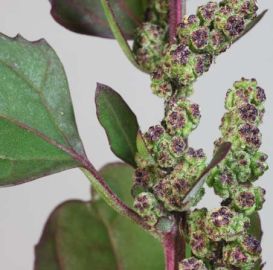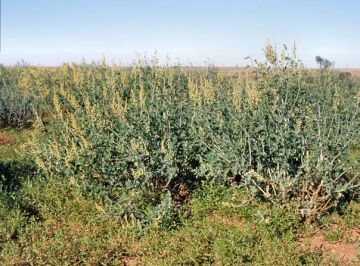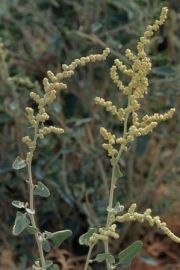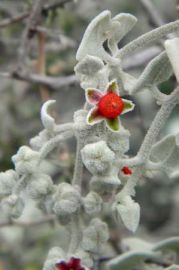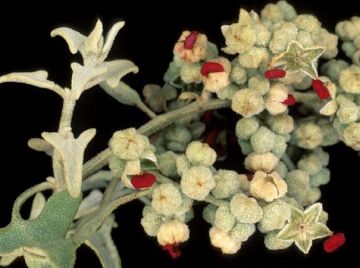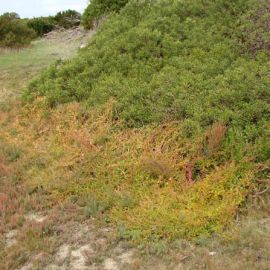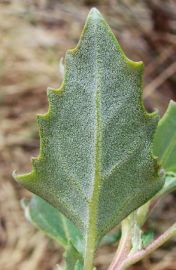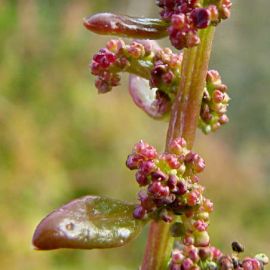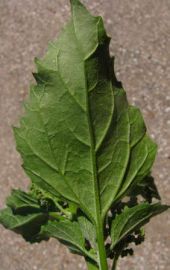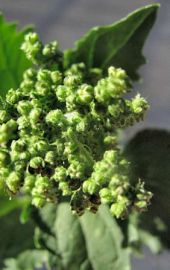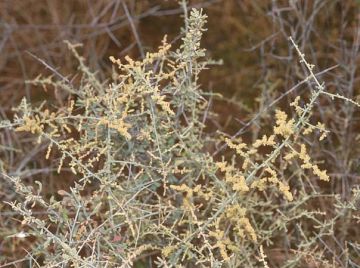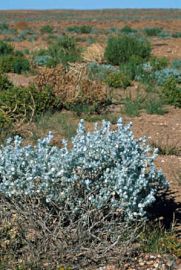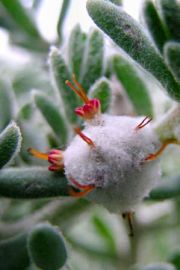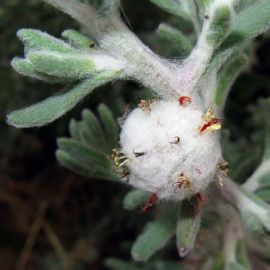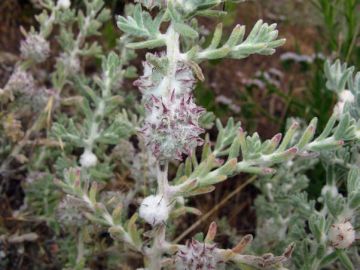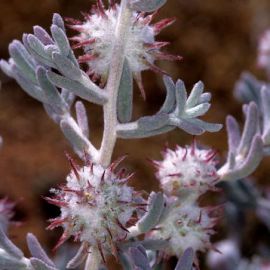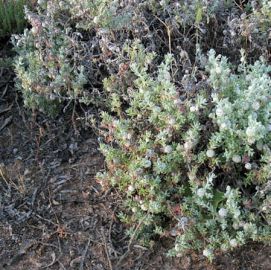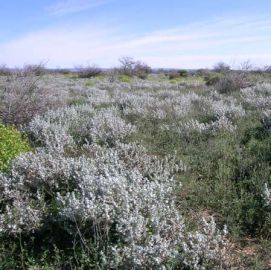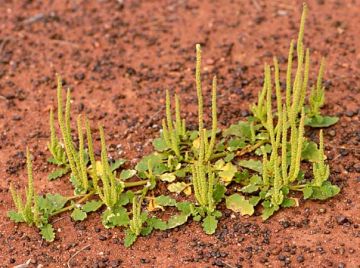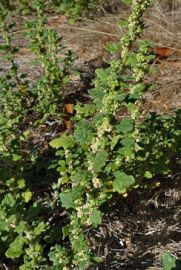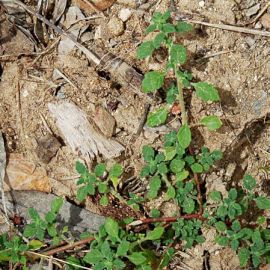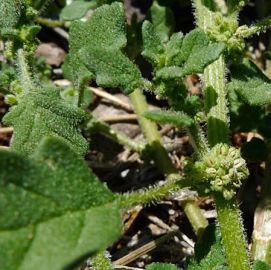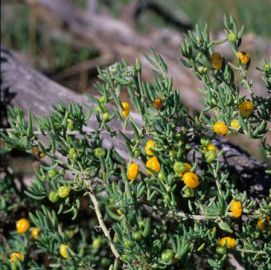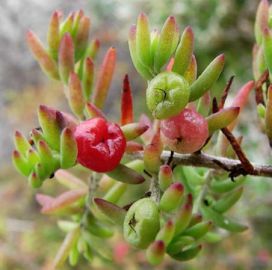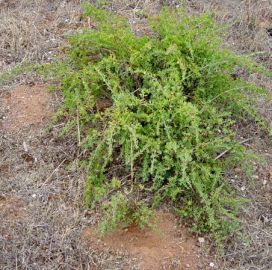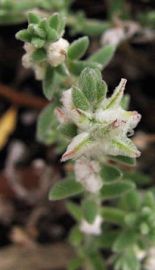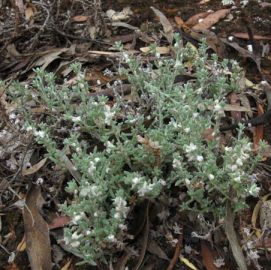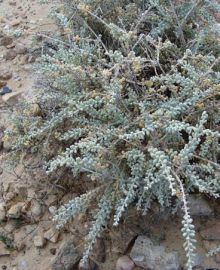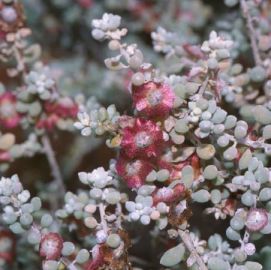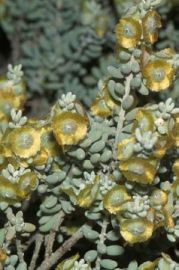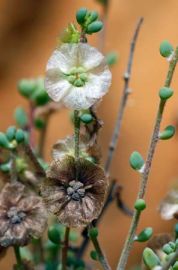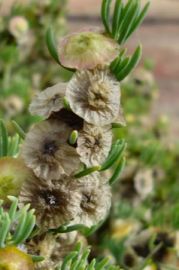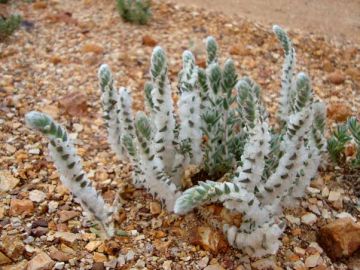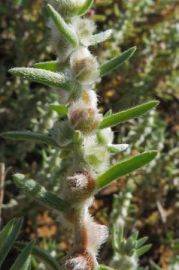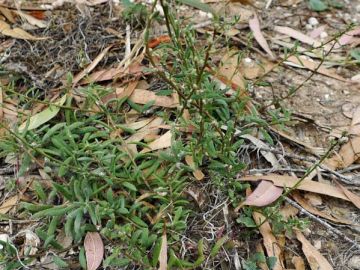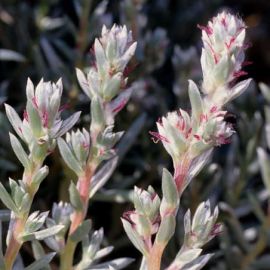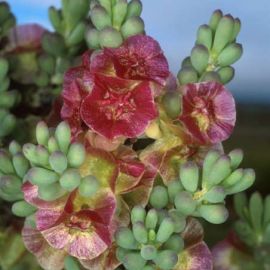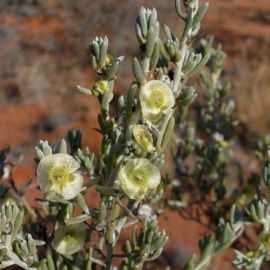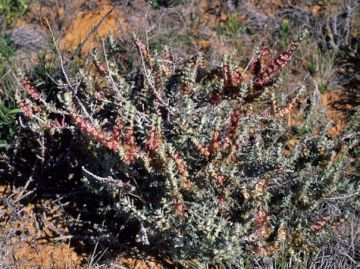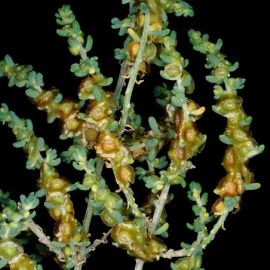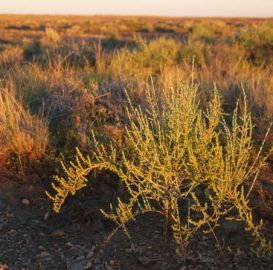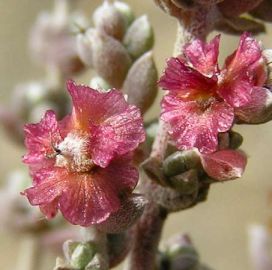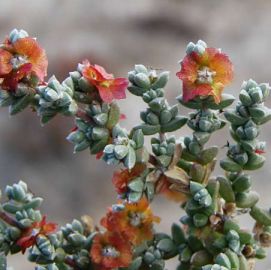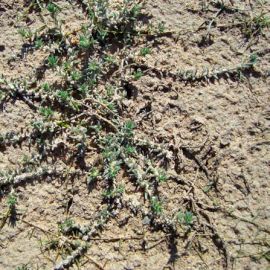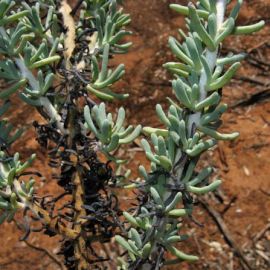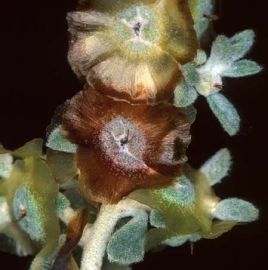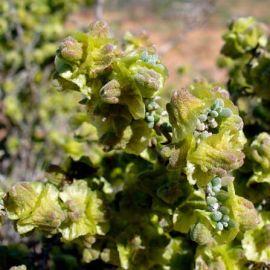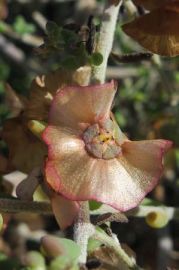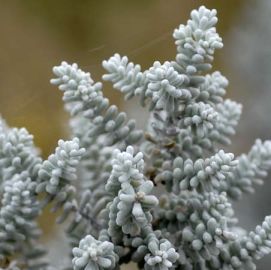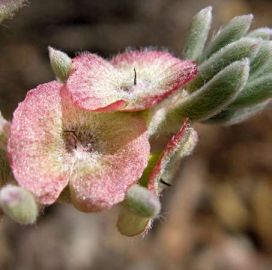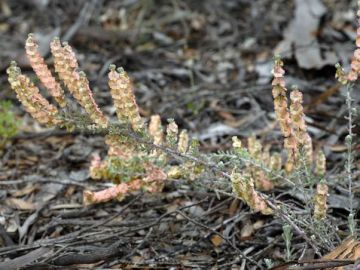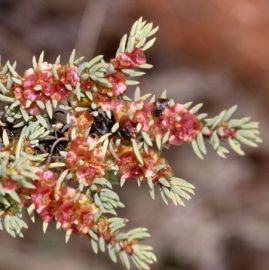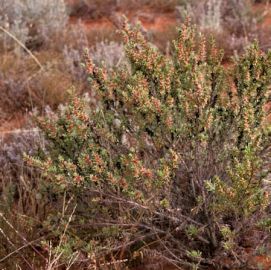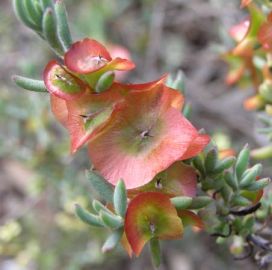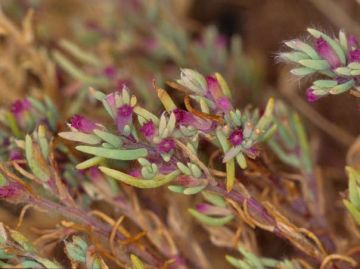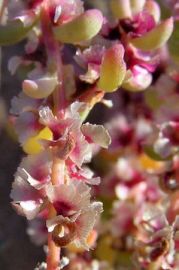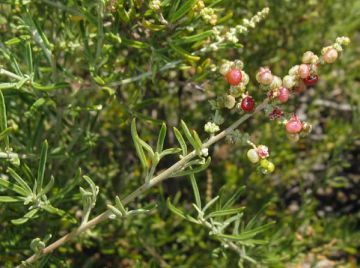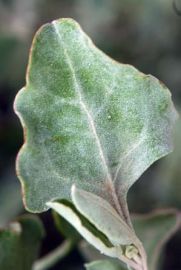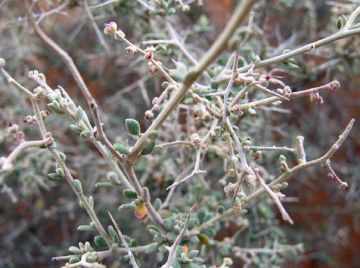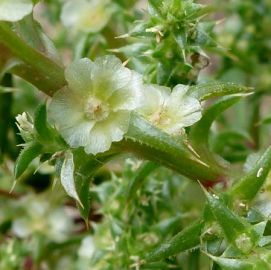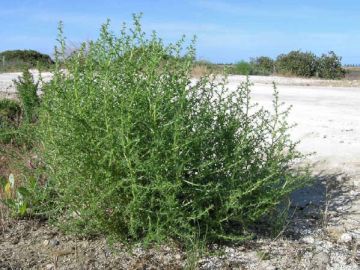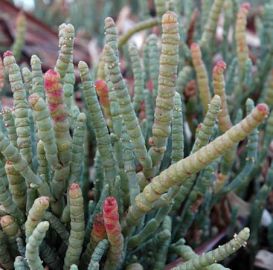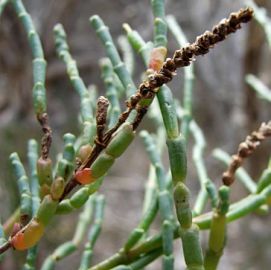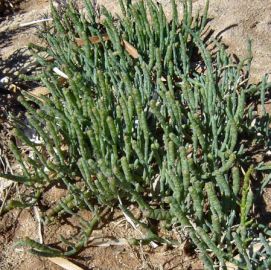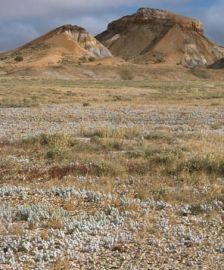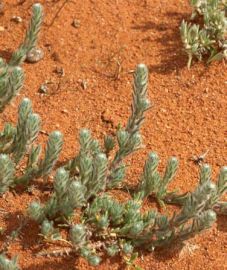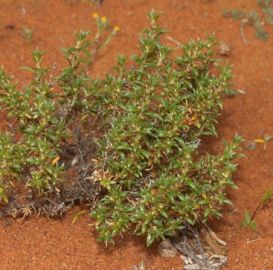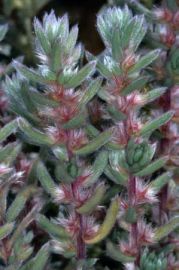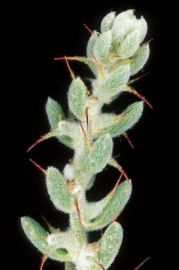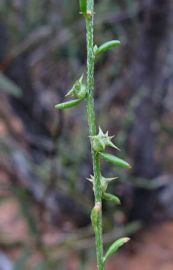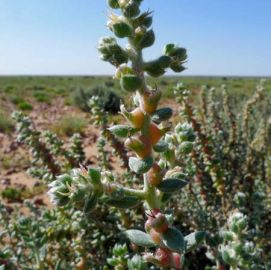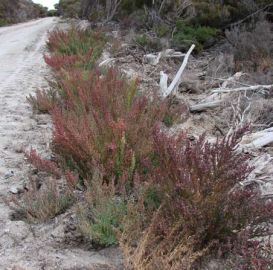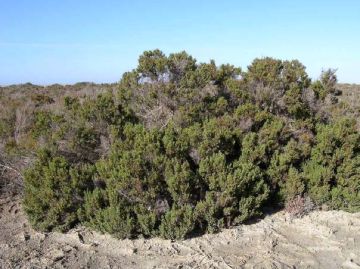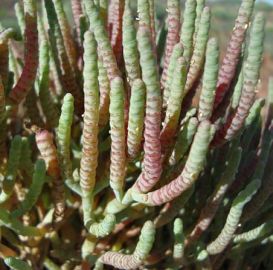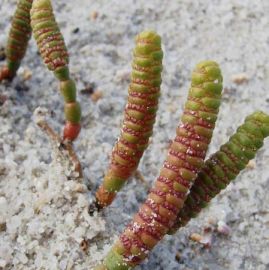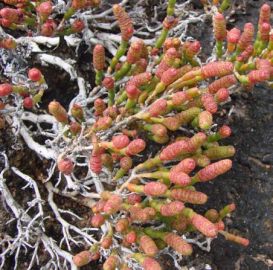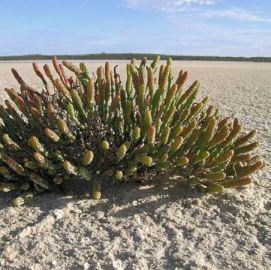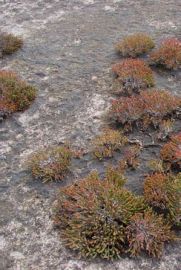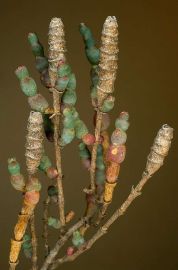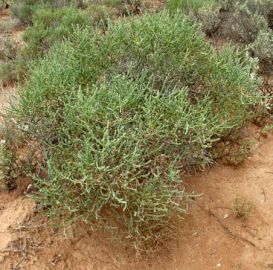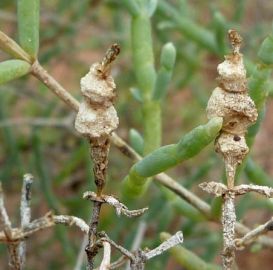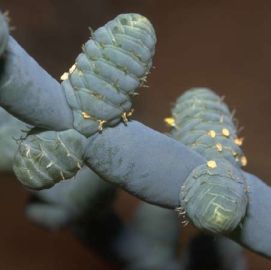P.G.Wilson (up-dated by R.J.Chinnock)
Herbs or shrubs, glabrous or pubescent, sometimes glandular; leaves usually alternate, simple, often succulent, exstipulate, in the Salicornieae (samphires) opposite and reduced to small lobes at the apex of jointed internodes. Inflorescence of compact or open cymes or panicles, or reduced to solitary axillary flowers; flowers small, bisexual or unisexual; perianth of 1 whorl, 5-lobed, or reduced to 4–1 lobes; in fruit sometimes succulent or woody, often enlarged and developing wings, spines or tubercles; stamens opposite and equal in number to the perianth lobes or fewer, hypogynous or attached to the wall of the perianth; anthers bilocular, dehiscing by longitudinal slits; ovary superior (semi-inferior in Beta), unilocular; stigmas usually 2 or 3; ovule solitary, basal, campylotropous to amphitropous. Fruit with a membranous crustaceous or succulent pericarp; seed often lenticular; testa membranous to crustaceous; embryo straight, curved, horseshoe-shaped, annular or spiral; albumen (perisperm) absent to abundant. Chenopods.
Cosmopolitan with over 100 genera and 1,500 species; frequently found in saline environments.
Mabberley (2008) placed Chenopodiaceae in synonomy under Amaranthaceae. He stated that he broadly followed The families and genera of vascular plants published from 1991 onwards by Kubitzki et.al., but modified this classification by taking into account more recent findings resulting from molecular systematics published by the Angiosperm Phylogeny Group (1998, 2003) and P.F. Stevens’ Angiosperm Phylogeny Website (2001–).Shepherd (2008) has drawn attention to the fact that the Angiosperm Phylogeny Group did not include all the data from relevant studies at the time and that the findings were in most cases based on relatively small numbers of genera and species using few gene regions, predominantly cpDNA. Furthermore she pointed out that various recent molecular phylogenetic studies in both groups since 2003 have not accepted this change.In view of the uncertainty of the monophyly of the groups Chenopodiaceae is retained here as a distinct family in view of conflicting evidence. There appears to be a need for further, more detailed, molecular phylogenetic studies to be undertaken before this is resolved. This classification has also been adopted by the Australian Plant Census (www.anbg.gov.au/chah/apc)..
Cultivars derived from Beta vulgaris L. provide beetroot, sugarbeet, etc., while Spinacia oleracea L. produces spinach.
Reference: Wilson (1984).
1. Plant with obvious leaves; branches not articulate
2. Leaves flat, often broad, if terete then with mealy hairs when young
3. Plant
glabrous; fruiting
perianths hard, united in clusters;
ovary semi-
inferior
3: Plant glabrous, mealy, pilose, or glandular; ovary superior
4. Plant
mealy when young; flowers
unisexual; male flowers with a 5-
lobed perianth and 5 stamens; female flowers lacking a
perianth but surrounded by a pair of
bracteoles that may be
free of fused, often
inflated or spongy
4: Plant variously pubescent or glabrous; all flowers with a perianth, not surrounded by bracteoles
5. Plants shrubby, predominantly
dioecious;
pericarp succulent
5: Plants herbaceous or weakly woody; flowers polygamous or bisexual; pericarp very rarely succulent
6. Herb with a basal rosette of leaves;
perianth-
segments 4,
cartilaginous in
fruit
6: Plants without a basal rosette
7. Plants (at least some parts) with glandular or glandular-
vesicular hairs
7: Plants glabrous, pubescent or mealy
8. Perianth-
segments 5; stamens 1–3;
seed horizontal;
perennial herbs with
mealy indumentum
8: Perianth-segments 1–5; stamens 1–5; seed horizontal or vertical; mostly annual herbs (rarely perennials), glabrous or with mealy indumentum
9. Perianth-
segments (in lateral flowers) 1; stamen 1; sparsely
mealy herb
9: Perianth-
segments 3–5; stamens 1–5;
herb or rarely
perennial with
mealy indumentum, or
glabrous
2: Leaves narrow, flat or subterete; hairs (if present) simple, bifurcate or branched (neither glandular nor mealy)
10. Flowers and
fruits fused in
axillary clusters of 2 or more
10: Flowers and fruits solitary or if in pairs then not fused together
11. Fruiting perianth without obvious appendages
12. Flowers bibracteolate;
embryo spirally coiled
12: Flowers without bracteoles; embryo curved or annular
13. Fruiting
perianth succulent,
berry-like, split longitudinally to the base
13: Fruiting perianth dry or, if succulent, not berry-like and not split to the base
14. Fruiting perianth dry
15. Fruiting
perianth keeled and
gibbous on one side
15: Fruiting
perianth not
gibbous,
segments triangular from above
14: Fruiting
perianth dry or slightly succulent,
ovoid to
urceolate
11: Fruiting perianth with 1 or more wings, spines or tubercles, not succulent
16. Fruiting perianth with erect wing or wings
17. Both horizontal and vertical
wings present
17: Only vertical
wing or
wings present
16: Fruiting perianth without erect wings
18. Horizontal wing or wings present on the fruiting perianth
19. Flowers subtended by a pair of prominent
spinescent bracteoles;
embryo spirally coiled
19: Bracteoles, if present, minute; embryo annular
20. Fruiting
perianth hemispherical,
glabrous; apex
truncate extending into a hard narrow 5-angled
wing (formerly
Sclerochlamys)
20: Fruiting
perianth lenticular to
turbinate or
globose, with 5 horizontal
wings or a
simple annular horizontal
wing
18: Spines or tubercles present on the fruiting perianth
21. Plant densely stellate- or
dendritic-
tomentose; leaves flattened
21: Plant with simple or bifurcate hairs (if dendritic then leaves terete) or glabrous
22. Perianth densely
woolly; appendages in two series, 5 erect and 5 horizontal
22: Perianth appendages in one series
23. Fruiting
perianth hard, subglobular,
glabrouss, with c. 11 very short radiating
spines arising from a narrow horizontal
wing (formerly
Stelligera)
23: Fruiting perianth glabrous or hairy, with 1–6 spines, tubercles, or other processes
24. Perianth appendages 3–5, soft, subcylindrical,
woolly, arising from the base of the
perianth lobes
24: Perianth appendages of spines or tubercles
25. Fruiting
perianth cylindrical, with 5 short
spines arising from the base of the
perianth lobes; the
spines sometimes united into an apical cup-shaped structure
25: Fruiting
perianth variously shaped;
spines or
tubercles 1–6, arising from between the
perianth lobes
1: Plant apparently leafless or with opposite very reduced leaves; branchlets made up of succulent internodes
26. Spike-like
inflorescences terminal, cymules 5–13 flowered;
perianth lobes 3–4,
abaxial lobe present;
seed distinctly
papillose or with slender hairs
26: Spike-like
inflorescences terminal and lateral; cymules 3 flowered, rarely 5–7 flowered and, if so, lateral
spikes present;
perianth lobes 2–3,
abaxial lobe absent;
seed smooth or variously ornamented but never
papillose or with hairs
Haloxanthium Ulbr.; Seniella Aellen; Blackiella Aellen.
(Latin atriplexum, an orache.)
Sp. Pl. 2: 1052 (1753).
Annual or perennial herbs or shrubs, monoecious or dioecious; indumentum of bladder-like hairs which may collapse to form a mealy or scaly covering; leaves mostly alternate, flat to semiterete, entire, dentate or lobed. Flowers unisexual, small, clustered, the clusters axillary, spicate or paniculate; male flowers without bracts or bracteoles; perianth deeply 5-lobed; stamens 5, filaments linear; female flowers: perianth absent and replaced by a pair of bracteoles which enlarge and cover the fruit; bracteoles sessile or stipitate, free or fused, in fruit herbaceous or woody or spongy, sometimes with appendages which may exceed the bracteoles; stigmas 2, slender. Pericarp membranous; seed erect, lenticular; testa crustaceous, coriaceous or membranous; embryo annular; perisperm central. Saltbushes.
Cosmopolitan with over 250 species, often halophytic.
The term ‘bracteoles’ refers to the fruiting bracteoles.
Variants of the European species, A. hortensis L., are grown for food and as an ornamental. Some species like A. nummularia are cultivated for stock food
1. Annuals or short-lived
perennials,
monoecious; fruiting
bracteoles almost totally united, spongy or (in 1
species) dorsiventrally flattened and with broad vertical
wings; appendages (other than
wings) absent
1: Annuals, perennials or shrubs; fruiting bracteoles free or united, not spongy though sometimes with spongy appendages; wings absent
2. Annuals with slender ribbed stems; leaves
herbaceous, flat, venation open
2: Perennial herbs or shrubs; leaves with closed dark-green reticulate venation
3. Perennial
herbs,
monoecious;
glomerules of male flowers
axillary or
spicate
3: Perennial
herbs or shrubs, predominantly
dioecious;
glomerules of male flowers
spicate or
paniculate
1. Lower leaves
lanceolate,
entire to deeply
serrate, if
hastate then with forwardly directed basal
lobes
1: Lower leaves triangular or
hastate with
spreading or slightly backwardly directed basal
lobes
1. Bracteoles globular, ellipsoid, or obovoid; wing-like appendages absent
2. Leaves
sessile or shortly
petiolate;
bracteoles broadly ellipsoid to
globular, 4–6 (rarely to 8) mm long
2: Leaves conspicuously
petiolate;
bracteoles globular to
obovoid, 8–12 mm long
1: Bracteoles variously shaped, bearing 1 or 2 horizontal to vertical wings (sometimes very narrow)
3. Tube small, obconical, 1–3 mm high, somewhat compressed
4. Valves fan-shaped,
appressed; appendages
inflated, attached to the apex of the tube on each side
4: Valves minute or triangular and 1–2 mm long; appendages wing-like, horizontal, somewhat undulate
5. Bracteoles
scurfy-
pubescent
5: Bractcoles
glabrous, glossy
3: Tube prominent, 5–12 mm high, either
compressed and bordered by
decurrent wings or
turbinate to
globular without
decurrent wings
1. Bracteoles from half to nearly entirely united
2. Bracteoles cylindrical or with a cylindrical tube
3. Bracteoles 4–6-
lobed at the apex; the
lobes horn-like, fan-shaped, or reduced to small teeth
3: Bracteoles acute to rounded or truncate
4. Bracteoles with
free broadly fan-shaped to
reniform valves, often with
recurved lobes
4: Bracteoles fused to the apex; distal portion flattened to cylindrical, oblong or narrow-cuneate
5. Bracteole apex flattened,
rhomboid or
cuneate,
dentate, glossy when mature
5: Bracteole apex
compressed or cylindrical, insignificant,
scurfy
2: Bracteoles flattened to biconvex, without a cylindrical tube
6. Bracteoles without dorsal appendages
7. Bracteoles sessile (or appearing so)
8. Bracteoles more or less
deltoid, prominently
reticulate, often red and succulent when fresh; plant
prostrate or
decumbent
8: Bracteoles variously shaped, not succulent
9. Erect divaricately branched plant with deeply concave clasping leaves (NU region)
9: Prostrate to erect; leaves not clasping (widespread)
10. Plant
prostrate; leaves 2–6 mm long;
bracteoles 1–1.5 mm long
10: Plant decumbent to erect; leaves and bracteoles longer than above
11. Bracteoles
oblong, with a somewhat swollen tube
11: Bracteoles compressed and rhomboid to deltoid or swollen and rounded at the apex
12. Bracteoles swollen, rounded at the apex
12: Bracteoles compressed, rhomboid to deltoid
13. Leaves coarsely
serrate, sparsely
scurfy above and below;
bracteoles scurfy-
pubescent
13: Leaves
sinuate-
dentate to
entire,
scurfy below,
glabrescent above
7: Bracteoles pedicellate
14. Leaves prominently
petiolate, 20–40 mm long;
bracteoles with fan-shaped or
reniform valves
14: Leaves sessile or subsessile, 5–20 (rarely to 30) mm long
15. Bracteoles
deltoid to
rhomboid, flattened,
reticulate; leaves
glabrescent above
15: Bracteoles swollen at least in part
16: Bracteoles obtuse to truncate, entire or toothed
17. Bracteoles
turbinate or narrow-
turbinate, c. 5 mm long
17: Bracteoles rhomboid to deltoid or broad-deltoid
18. Bracteoles with a short thick
pedicel and
deltoid 3-
toothed valves, in all 2–3 mm long
18: Bracteoles shortly and narrowly
pedicellate, broad-
rhomboid to broad-
deltoid, 2–3 mm long,
denticulate or
entire
6: Bracteoles with dorsal appendages
19. Bracteole appendages numerous, verrucose or papillose
20. Leaves thick,
linear to narrow-
oblong,
acute
20: Leaves thin, broad-
obovate,
sinuate-
dentate, rounded
19: Bracteole appendages 1–4, or few and flattened or inflated
21. Appendages tuberculate, papillose, or slender
22. Bracteoles with a short thick
pedicel;
valves flattened,
deltoid, c. 2 mm long
22: Bracteoles
sessile, U-shaped, swollen, c. 1.5 mm long
21: Appendages inflated, foliaceous, or spiny
23. Bracteoles with a swollen base and narrow
beak-like
valves; appendage
inflated
23: Bracteoles without a swollen base
24. Bracteoles equal; leaves with
sinuate margins
24: Bracteoles unequal
25: Appendages
inflated, attached along each margin on one side of the tube
1: Fruiting bracteoles free to near the base
26. Bracteoles fan-shaped to
reniform, unequal
26: Bracteoles not as above
27. Bracteoles prominently lobed
28. Leaves congested,
sessile,
cordate
28: Leaves not congested, petiolate or narrowed at the base
29. Bracteoles with flat or
inflated acutely
lobed appendages
29: Bracteoles without appendages
27: Bracteoles entire or the margin sinuate or toothed
30. Bracteole appendages
inflated,
entire, more or less equal in size to the
bracteoles
30: Bracteole appendages small or absent
31. Leaves narrow-triangular,
cordate at the base
31: Leaves narrow-oblong to broad-obovate, narrowed at the base
32. Bracteoles
sessile ,
cordate, rounded, without appendages
32: Bracteoles sessile or subsessile, acute or obtuse
33. Bracteoles with I or 2 tubercular appendages on each
valve
33: Bracteoles either without appendages or with inflated appendages
34. Bracteoles prominently
dentate,
scurfy-
tomentose; appendages basal, small and
inflated
34: Bracteoles
entire or with basal teeth,
scurfy-
tomentose to subglabrous; appendages basal or absent
1. Bracteoles slender-pedicellate, reniform or semicircular, entire
2. Bracteole appendages absent; leaves
elliptic to broad-
elliptic, 0.5–1 cm long,
entire
2: Bracteole appendages
reniform,
inflated, about half the width of the
valve; leaves
oblanceolate, c. 2 cm long, distantly
toothed
1: Bracteoles with a thick pedicel or sessile to subsessile
3. Bracteoles with a bladder-like appendage
3: Bracteoles without appendages, or with 2 slender antler-like appendages
4. Leaves entire
5. Leaves
cordate to
deltoid;
bracteoles broad-
rhomboid to
orbicular, c. 3 mm wide, biconvex, hard with little or no papery margin (MU region)
5: Leaves elliptic (coastal)
6. Female flowers in terminal
inflorescences;
bracteoles cordate to
deltoid, flat, without appendages
6: Female flowers
axillary;
bracteoles ovoid to
rhomboid, swollen in the centre, smooth or with verrucose appendages
4: Leaves dentate or denticulate, deltoid to cordate, broad-elliptic or orbicular
7. Leaves
rhomboid to
orbicular,
sinuate-
dentate;
bracteoles sessile,
rhomboid to
orbicular, papery all over or with a thickened base;
valves appressed or
reflexed, with
entire or
denticulate margins; shrub 1.5–3 m high, with
ascending branches (inland)
7: Leaves cordate to deltoid, dentate; bracteoles sessile, thickened all over or only at the base; divaricately branched shrubs
8. Bracteoles suborbicular, 6–10 mm wide;
valves papery, slightly
recurved,
dentate, thickened in the centre or towards the base (LE, GT)
8: Bracteoles broad-
rhomboid to
orbicular, c. 3 mm wide, biconvex, hard with little or no papery margin (MU region)
Intricately branched rounded shrub c. 50 cm high, monoecious; leaves sessile to shortly petiolate; lamina broadly obovate to orbicular, flat or folded, 5–30 mm long, shallowly sinuate-dentate, scaly-tomentose on both surfaces or glabrescent above. Flowers in clusters, axillary or forming short interrupted spikes. Fruiting bracteoles oblong, swollen towards the base, fused except for the acute to acuminate apex, sessile or the lower third forming a slender or stout pedicel, in all 2–8 mm long; appendages conical, usually paired on one or both valves, sometimes lacking; Seed circular; radicle lateral, erect.
All intermediates between the extremes of both subspecies may be found; it is unclear how much of the variation is due to environment and how much to genetic factors.
1. Leaves more or less flat, c. 10 mm long or more; fruiting
bracteoles 4–8 mm long,
acuminate
1: Leaves folded, c.5 mm long; fruiting
bracteoles 2–4 mmlong,
acute or 3-
toothed
1.1a
Atriplex acutibractea subsp.
acutibractea Leaves usually more or less flat, 10–30 mm long. Fruiting bracteoles 4–8 mm long, with a narrow to stout pedicel, acuminate.
S.A.: NW, LE, NU, GT, FR, EA, EP, MU, YP, SL; W.A.; N.S.W.; Vic. Flowers: all months, especially Jul.–Oct.
1.1b
Atriplex acutibractea subsp.
karoniensis Leaves more or less folded, 5–10 mm long. Fruiting bracteoles subsessile, swollen, oblong to narrow-deltoid, 2–4 mm long, truncate with a short central triangular lobe or minutely 3-toothed; appendages absent or represented by a pair of small tubercles on each bracteole.
S.A.: NU, FR, EP, NL, MU, YP, SL; W.A. Flowers: as for the typical subspecies.
Short-lived perennial c. 50 cm high, monoecious; leaves thin, petiolate, scurry to scurfy-tomentose on both surfaces; lamina broadly ovate to broadly elliptic, 2–4 cm long, acute, acutely lobed, base cuneate; petiole half the length of the lamina. Flowers mixed in clusters, both axillary and forming short disjunct spikes. Fruiting bracteoles sessile or subsessile, appressed, free to the base, broadly triangular, c. 5 mm long and wide (rarely to triangular), more or less scurfy-tomentose; margins prominently dentate; appendages small, semicircular, inflated, 0.5–1 mm wide, near the base of each bracteole; seed circular; radicle erect.
S.A.: LE, GT, FR, EA, MU; N.S.W. Flowers: Aug.–Sep.
Rounded annual or shortly-lived perennial to 30 cm high, monoecious; leaves thin or leathery, scurry on both surfaces, broadly obovate to rhomboid, narrowed at the base into a petiole about half the length of the lamina, in all 2–4 cm long; apex rounded; margin entire to sinuate-dentate. Male flowers in compact glomerules forming short interrupted spikes; female flowers in axillary clusters. Fruiting bracteoles pedicellate; lower half fused, campanulate to cylindrical; sometimes thickened; upper half free, fan-shaped to reniform, herbaceous, nerved, pedicel slender or thickened and continuous with the tube, in all to 10 mm long and wide at the apex; seed circular; radicle erect, prominently projecting. Fan (or angular) saltbush.
S.A.: NW, LE, GT, FR, EA, EP, MU; N.T.; Qld; N.S.W.; Vic. Flowers: mainly Jul.–Oct.
This species varies greatly in the shape and texture of the bracteole and leaf. In some areas it evidently intergrades with any of A. pseudocampanulata, A. intermedia, A. turbinata and A. crassipes.
Plate 1D, 1E
Photos: A–C, L. Jansen; D & E, A.C. Robinson, DEWNR; F–I, D.E. Murfet; J–L, T.M. Jaques.
D Atriplex angulata, habit
E Atriplex angulata, stem with fruit
Spreading to erect annual c. 1 m high, monoecious; branches quadrangular, almost glabrous; lower leaves lanceolate, base cuneate, margin entire to deeply serrate, often hastate with forwardly directed lobes, 5–10 mm long including a petiole of c. 10 mm. Flowers mixed, spiciform, paniculate with the flowers in at first continuous and later in disjunct clusters. Fruiting bracteoles deltoid, acute, 3–4 mm long and wide, united in the lower half or free to the base, entire or with 1 or 2 teeth, smooth or with warty protuberances, becoming black and thickened with age; seeds of 2 types, brown and black, orbicular; radicle basal, horizontal. Native orache.
S.A.: MU, SL, KI, SE; N.S.W.; Vic.; Tas. Found in wet brackish situations, often coastal. Flowers: Jan.–Apr.
(Rare status in S.A.)
Plate 1F, 1G, 1H, 1I
Photos: A–C, L. Jansen; D & E, A.C. Robinson, DEWNR; F–I, D.E. Murfet; J–L, T.M. Jaques.
F Atriplex australasica, habit
G Atriplex australasica, flowers
H Atriplex australasica, fruit
I Atriplex australasica, leaves
Spreading to erect shrub to 1.5 m high, dioecious or monoecious; leaves thin, shortly petiolate, narrow-elliptic to elliptic or ovate, 2.5–4 cm long, entire, with a scurfy sheen on both surfaces. Male flowers in dense glomerules 5–7 (rarely to 10) mm diam., forming interrupted or continuous spikes or panicles; female flowers in clusters axillary to the upper foliage leaves. Fruiting bracteoles subsessile or shortly pedicellate; pedicel turbinate, hard; bracteoles ovoid (rarely) to broadly deltoid or rhomboid, 6–10 mm long and wide, united towards the base, often hard and swollen in the centre, thin and entire on the margin, smooth or with a verrucose appendage on one or both sides; seed circular; radicle lateral, erect. Grey (or coast) saltbush, barilla.
S.A.: NU, EP, NL, YP, SL, KI, SE; W.A.; N.S.W.; Vic.; Tas. Flowers: all months, especially June–Dec.
Plate 1J, 1K, 1L
Photos: A–C, L. Jansen; D & E, A.C. Robinson, DEWNR; F–I, D.E. Murfet; J–L, T.M. Jaques.
J Atriplex cinerea, male flowers
K Atriplex cinerea, habitat: band of shrubs along coastal fore-dune
L Atriplex cinerea, foliage and panicles of male flowers
Annual or short-lived perennial c. 30 cm high, branching from the base, monoecious; leaves sessile, triangular to narrow-triangular or ovate, cordate, acute, 5–20 mm long, entire to sinuate-dentate in the lower half, scaly-tomentose, or forming a grey punctate sheen with age. Flowers in axillary glomerules, the upper ones male and female, the lower female. Fruiting bracteoles minutely pedicellate, free to the base, rhomboid-triangular, 2–3 mm high and wide, 3-nerved.
S.A.: LE, GT, EA; N.S.W. Found usually in gypseous or saline soil. Flowers: all months.
Decumbent to erect rounded herb to 30 cm high, monoecious; leaves sessile or shortly petiolate, scurfy-tomentose on both surfaces, ovate to elliptic, 7–15 mm long, thin, obtuse, entire, cuneate to truncate at the base. Flowers in axillary glomerules. Fruiting bracteoles like a duck’s foot; pedicel thick, 1–1.5 mm long; tube. deltoid, flattened, united in the lower half, shortly 3-toothed at the apex, c. 2 mm long, prominently nerved and reticulate, smooth; seed circular; radicle lateral.
S.A.: , LE, GT; N.T.; Qld; N.S.W. Flowers: all months.
This species is closely related to A. pseudocampanulata with which it intergrades.
Divaricately branched shrub c. 50 cm high, monoecious; leaves sessile, erect, deeply concave and partially clasping the branch; frequently congested on the dwarf lateral shoots; lamina broadly ovate, 4–8 mm long, apex acute and often recurred, base rounded or cordate, margin entire or with 2–4 teeth, scaly or with a grey sheen, sometimes glabrous with age. Male flowers in axillary glomerules towards the apex of the branches; female flowers axillary, solitary, obscured by the subtending leaf. Fruiting bracteoles sessile, united except at the apex, oblong; apex 3-toothed; base rounded; in all c. 2.5 mm long, 1.5 mm wide.
S.A.: NU (growing in shallow depressions on the limestone plain), GT; W.A. Flowers: Jul.–Oct.
Plate 2A
Photos: A & H, P.J. Lang, DEWNR; B–D, P.D. Canty, DEWNR; E, F & I, A.C. Robinson, DEWNR; G, F. Kutsche, DEWNR; J, P.B. Copley, DEWNR.
A, Atriplex cryptocarpa low shrubland on Nularbor Plain.
Decumbent to erect perennial herb to 30 cm high, monoecious; leaves sessile, elliptic to orbicular, c. 10 mm long, entire; base cuneate and passing into a short petiole or subsessile. Male flowers in small glomerules in the distal leaf axils usually with a few female flowers; female flowers in scattered glomerules along the branches. Fruiting bracteoles with a compressed narrow-campanulate to deltoid tube c. 1–2 mm long, which expands into appressed fan-shaped to reniform reticulate sinuate valves more or less equal in length to the tube, the adaxial valve slightly shorter than the abaxial; tube with a pair of small leaf-like appendages on the adaxial surface near the base or these sometimes lacking; pedicel slender or stout, shorter than to slightly exceeding the length of the tube. Small saltbush.
S.A.: LE, NU, GT, FR, EA, EP, MU, YP; W.A.; Qld; N.S.W.; Vic. Flowers: all months.
Decumbent to erect annual or short-lived perennial to 20 cm high, monoecious; leaves elliptic to broadly elliptic, 10–15 mm long, subsessile, entire to faintly sinuate-dentate, scaly-tomentose on both surfaces. Male flowers in small glomerules in the distal leaf axils usually mixed with some female flowers; female flowers in scattered axillary glomerules. Fruiting bracteoles appressed, flat, c. 5 mm long, prominently reticulate with age, fused in the lower two-thirds into a campanulate tube, broadly triangular above; the adaxial limb considerably shorter than the abaxial; appendages paired, inflated, attached along the margins of the adaxial bracteole; pedicel 0.5–1 mm long.
S.A.: LE, GT, FR, .EA. Flowers: Aug.–Nov.
(Rare status in S.A.)
Erect perennial to 50 cm high; leaves varying from narrow-elliptic to elliptic, subsessile and 2.5–5 mm long to obovate and 10–40 mm long, entire to strongly sinuate-dentate; upper surface glabrescent, lower surface scurfy to scaly. Male flowers in small glomerules 2–3 mm diam., in terminal axils; female flowers in scattered axillary clusters. Fruiting bracteoles sessile, united into a swollen campanulate tube 1.5–2.5 mm long, or rarely the tube narrow-deltoid and passing into a short pedicel; apex truncate to rounded, entire or 3-toothed; appendages small and tooth-like, 1–4 on each face, or absent.
S.A.: NW, LE; W.A.; N.T.; Qld; N.S.W. Flowers: May–Nov. (few records).
Open annual herb 10–30 cm high, branching from the base, monoecious; leaves thin, ovate to suborbicular, obtuse, entire or sinuate, scaly-tomentose, lamina 10–20 mm long, petiole 5–10 mm long. Flowers in glomerules in the axils of leaves including the basal leaves. Fruiting bracteoles sessile, flat, broadly deltoid, c. 4 mm high and wide, glossy, prominently nerved, deeply divided into 3–5 major narrow lanceolate lobes and smaller basal teeth, appendages basally attached, either flat or somewhat inflated and similar in shape to the bracteoles but somewhat small; seed broadly elliptic, transversly positioned; radicle directed tangentially from the vertical. Gibber saltbush.
S.A.: LE, GT, FR, EP; Qld, N.S.W. Flowers: probably mainly May–Oct.
Rounded annual or short-lived perennial herb to 30 cm high, monoecious; leaves thin (rarely leathery) scurfy on both surfaces; lamina deltoid to narrow-rhomboid, 15–30 mm long, apex acute, base obtuse, margin sinuate to serrate; petiole more or less half the length of the lamina. Flowers in axillary glomerules. Fruiting bracteoles sessile, fused, globular to obovoid, 8–12 mm long, shortly apiculate, inflated; epidermal covering thin, scurfy or eventually glabrous, supported on a network of fibrous veins; utricle cavity compressed-elliptic in the centre of the bracteoles, with a thin woody wall; seed erect, broadly elliptic; radicle lateral, erect. Pop saltbush.
S.A.: NW, LE, NU, GT, FR, EA, NL, MU, SL; All mainland States. Often found on flood plains or sandy flats. Flowers: June–Oct.
Very similar to and often growing with A. spongiosa.
Plate 2B, 2C
Photos: A & H, P.J. Lang, DEWNR; B–D, P.D. Canty, DEWNR; E, F & I, A.C. Robinson, DEWNR; G, F. Kutsche, DEWNR; J, P.B. Copley, DEWNR.
B Atriplex holocarpa, habit of plant (LHS), growing beside Atriplex spongiosa (RHS)
C Atriplex holocarpa, foliage and fruit
Rounded annual or shortly-lived perennial to 30 cm high, monoecious; leaves thin, subsessile or shortly petiolate, elliptic, ovate to obovate, 8–30 mm long, apex obtuse to acute, margin entire to repand and sparsely, bluntly dentate, upper and lower surface glabrescent, or lower surface scurfy. Male flowers in small glomerules 2–3 mm diam. in distal axils or forming small spikes; female flowers in axillary clusters. Fruiting subsessile, thin, flat, deltoid to cordate, acute or obtuse, 4–6 mm long and wide, free to base, entire or sparsely denticulate, reticulate, scurfy. Seed transversely elliptic; radicle ascending.
S.A.: LE; N.T.; Qld.
The mature fruits are reported as pink to red
(Vulnerable status in S.A.)
Intricately branched shrub to 1 m high, dioecious; leaves ovate-deltoid, sinuate-dentate, truncate or slightly cuneate at the base, with a thin scaly covering on both surfaces; lamina 15–20 mm long; petiole 2–3 mm long. Male flowers in disjunct or continuous glomerules c. 5 mm wide and forming slender spikes or panicles; female flowers in dense disjunct glomerules arranged in open leafy panicles. Fruiting bracteoles subsessile, orbicular to obtusely deltoid, c. 10 mm long and wide; valves smooth, entire or bluntly denticulate, free to near the base, hard, ultimately thickened and convex except for the papery reflexed margin; seed with a lateral erect radicle.
S.A.: LE, GT. Flowers: Apr.–June.
A. incrassata is similar to A. nummularia and could well be treated as a subspecies of the latter.
Plate 2E, 2F, 2G
Photos: A & H, P.J. Lang, DEWNR; B–D, P.D. Canty, DEWNR; E, F & I, A.C. Robinson, DEWNR; G, F. Kutsche, DEWNR; J, P.B. Copley, DEWNR.
E Atriplex incrassata, foliage and fruit
F Atriplex incrassata, intricate shrub habit
G Atriplex incrassata, gibber habitat
Sprawling annual or short-lived perennial to 30 cm high, monoecious; leaves thin, sessile or shortly petiolate, elliptic to obovate, 10–20 mm long, obtuse, entire to slightly sinuate-dentate, scurfy on both surfaces. Male flowers in glomerules in the terminal axils; female flowers in axillary clusters Fruiting bracteole with a spongy cylindrical pedicel c. 3 mm long, continuous with the short thickened tube from which arise the appressed coarsely reticulate rhomboid lobes c. 3–4 mm long, with a toothed margin, the whole glossy when mature; seed circular; radicle erect, prominently projecting.
S.A.: LE, GT, .EA; N.T.; Qld; N.S.W. Flowers: Jul.–Oct.
Erect rounded annual or short-lived perennial to 40 cm high, monoecious; leaves thin, with a scaly sheen on both surfaces; lamina very broadly obovate, base cuneate; petiole slightly winged, more or less half the length of the lamina. Male flowers in glomerules forming continuous or disjunct slender spikes; female flowers in axillary clusters. Fruiting bracteoles sessile or minutely stipitate, united towards the base into a compressed broadly turbinate tube 0.5–1.5 mm high and 1.5–2.5 mm wide at the apex, expanding above into thin appressed prominently veined fan-shaped valves with sinuate margins, 5–8 mm wide and 2.5 mm high; appendages inflated, compressed, ovate to orbicular, cordate at the base, equal to or exceeding the valves, attached at the apex of the tube of each bracteole by a short stipe; seed depressed-orbicular; radicle lateral, erect.
S.A.: LE, GT, .FR. Flowers: May–Sep.
(Vulnerable status in S.A.)
Decumbent annual or short-lived perennial with slender branches, monoecious; leaves narrow-elliptic to narrow-oblanceolate or rhomboid; remotely dentate to entire, 10–30 mm long, scaly on both surfaces. Male flowers in axillary glomerules or in short terminal spikes; perianth glabrous; female flowers clustered in the leaf axils. Fruiting bracteoles fused to the apex, cylindrical to urceolate (sometimes compressed when young) flattened distally, seemingly sessile or with a short slender pedicel (this often developing a spongy cylindrical sheath with age continuous with the bracteoles), in all 4–6 mm long; basal portion often thickened and sometimes tuberculate; distal portion herbaceous and more or less flattened, strongly nerved; apex truncate to acute, often shortly 3-toothed; seed circular to ovate; radicle lateral, slightly exserted. Slender-fruited saltbush.
S.A.: LE, NL, MU; N.T., Qld; N.S.W.; Vic. Flowers: probably all months.
Although Jacobs (1983) recognised A. sturtii (= A. leptocarpa var. minor), I have found that this taxon grades with both A. leptocarpa and A. turbinata and is therefore not maintained.
Erect perennial branching near the base, c. 30 cm high, monoecious; leaves rhomboid or circular and c. 10 mm long to narrow-elliptic or narrow-obovate and c. 40 mm long, including a petiole one-third of the length of the lamina, sinuate to entire, scaly-tomentose on both surfaces.INFL: Male flowers in glomerules c. 5 mm diam., in the upper leaf axils or forming slender interrupted spikes; female flowers in axillary glomerules. Fruiting bracteoles united (except at the apex where closely appressed) to form a hard cylindrical tube 1.5–3 mm long, passing into a slender or thick pedicel from half as long to as long as the tube; apex rounded, apiculate, with a pair of lateral erect or spreading horn-like lobes or these reduced to small teeth; appendages terminal, flat, spreading, fan-shaped, 1–3 mm long, crenulate or lobed or divided into 2; seed ellipsoid, erect, with an erect radicle. Spreading saltbush.
S.A.: NW, LE, GT, FR, EA, EP, NL, MU, YP; W.A.; N.T.; Qld; N.S.W.; Vic. Flowers: probably all months.
Annual or short-lived perennial c. 30 cm high, monoecious; leaves thin, narrow-obovate to rhomboid-orbicular, acute or obtuse to rounded, cuneate at the base, in all c. 20 mm long, margin coarsely sinuate-dentate to entire. Male flowers in small glomerules towards the branch apices; female flowers in scattered axillary clusters. Fruiting bracteoles apparently sessile, united except near the apex, strongly dorsiventrally flattened to spongy-turbinate or subglobose, variously winged around the apex or with opposite erect circular wing-like appendages, in all 5–18 mm long and wide, prominently or minutely apiculate due to the free triangular bracteole apices 1–2 mm high; seed circular; radicle basal, horizontal. Baldoo, eastern flat-top saltbush (not applicable to all subspecies).
This species is extremely variable in the shape of its leaves and of its fruiting bracteoles. The type variant approaches subsp. conduplicata in having a pair of dorsal and ventral wings. At the other extreme (represented by the type of subsp. inflata) the bracteoles are subglobose and have almost no wing. Hybridisation probably occurs between the subspecies.
1. Fruiting bracteoles more or less turbinate to strongly dorsiventrally compressed; upper surface or lateral margins produced into spreading or ascending wings
2. Fruiting
bracteoles dorsiventrally flattened, broadly
elliptic to
orbicular in outline due to the
opposite wing-like appendages that unite to form a winged tube; leaves rounded
2: Fruiting bracteoles spongy; wing-like appendages not passing to the base
3. Upper surface of the
bracteoles produced into a
dorsal and a
ventral wing, leaves
acute to
obtuse
3: Upper surface of the
bracteoles produced into an erect
dorsal and
ventral wing and a pair of smaller
spreading lateral
lobes; leaves
obtuse to rounded
1: Fruiting
bracteoles subglobose, wingless or almost so; leaves narrow,
acute
1.20a
Atriplex lindleyi subsp.
conduplicata Leaves obovate to rhomboid-orbicular, in all 20–40 mm long, apex obtuse to rounded. Fruiting bracteoles slightly spongy, covered with a scaly sheen, united almost to the apex, broadly elliptic to orbicular in outline due to the opposite erect circular appendages that unite in the middle to form a winged tube and pedicel, in all 5–18 mm long and wide; upper surface of the bracteoles rounded and surmounted by the prominent free oblong-triangular apexes which do not exceed the winged appendages.
S.A.: LE, GT, FR, EA, EP; N.T.; Qld, N.S.W., Vic. Flowers: Flowering: Apr.–Oct.
1.20b
Atriplex lindleyi subsp.
inflata Leaves elliptic to narrow-elliptic, acute, remotely sinuate-dentate. Fruiting perianth spongy, subglobose, c. 8 mm long and wide; base rounded to obtuse; upper surface flat but curved laterally, with the margins sometimes produced into a narrow slightly inflated wing; free apex of bracteoles narrow-triangular, c. 1 mm high.
S.A.: NW, LE, GT, FR, EA, EP, NL, MU, YP; N.T.; N.S.W.; Vic. Flowers: Apr.–Oct.
1.20c
Atriplex lindleyi subsp.
lindleyi Leaves oblanceolate to narrow-obovate, acute, entire to dentate. Fruiting bracteoles turbinate, somewhat dorsiventrally compressed; upper surface curved; wing variable, surrounding the apex of the tube as a pair of lobes, dorsal and ventral, which are somewhat decurrent down the tube when this is compressed.
S.A.: LE, GT, FR, EA, EP, NL, MU; Qld; N.S.W.; Vic. Flowers: Flowering: Apr.–Oct.
1.20d
Atriplex lindleyi subsp.
quadripartita Leaves broadly obovate to rhomboid, coarsely dentate; apex obtuse to rounded. Fruiting bracteoles with an obconical slightly compressed spongy tube c. 5 mm long; wing deeply 4-lobed, dorsal and ventral lobes c. 5 mm long, erect and rounded, lateral lobes smaller, spreading.
S.A.: GT, FR, EA; N.S.W. Flowers: Apr.–Oct.
Prostrate herb with branches to 20 cm long, monoecious; leaves small, sessile or shortly petiolate, sparsely to moderately scurfy on both surfaces; lamina ovate to broadly elliptic or rhomboid (the broader leaves sessile), 5–10 mm long, remotely sinuate-dentate. Flowers in axillary clusters. Fruiting bracteoles scurfy, sessile or slender-pedicellate, rhomboid to fan-shaped, 2–3 mm long and wide; basal half united into a deltoid tube prominently keeled on either side; distal half free, herbaceous, deeply divided into 5 or rarely 3 narrowly triangular lobes; seed circular, prominently biconvex corresponding to the keels of the bracteoles; radicle lateral, erect.
S.A.: NW, LE, GT, EA; N.T.; Qld; N.S.W. Found in wet situations on heavy soil. Flowers: all months.
Annual herb to 30 cm high; leaves obovate to orbicular-rhomboid, c. 15–25 mm long, scaly on both surfaces, apex rounded, base cuneate and narrowed into a petiole about half the length of the lamina, margin sinuate-dentate. Male flowers in terminal glomerules or forming disjunct spikes or panicles; female flowers in scattered axillary glomerules. Fruiting bracteoles sessile, united to near the apex, glabrous; tube turbinate, with a rounded base, 2–4 mm long, spongy, passing upwards into a pair of horizontal wing-like entire slightly spongy auriculate appendages 5–8 mm wide, the margins of which are decurrent down the tube; apex of the tube rounded, its centre apiculate, with minute narrow-triangular terminal lobes; seeds with a basal horizontal radicle.
S.A.: GT, FR, EP; Qld; N.S.W. Flowers: Apr.–Nov.
Erect rounded annual or short-lived perennial to 30 cm high, monoecious; leaves broadly obovate, sinuate-dentate, scurfy or scaly on both surfaces, apex rounded, base cuneate and passing into a short petiole, in all 10–25 mm long. Flowers axillary; male flowers mixed with a few female, in glomerules in distal axils; perianth scurfy; female flowers in scattered clusters of 1–3. Fruiting bracteoles shortly pedicellate, broadly oblong, c. 5 mm long, fused to the apex and bearing on each side a rugulose spongy appendage over the lower two-thirds of the bracteole; apical portion flat, 3-toothed; seed orbicular; radicle lateral, erect.
S.A.: LE, FR; N.T.; Qld; N.S.W. Flowers: Oct.–Feb.
(Vulnerable status in S.A.)
Spreading to erect herb branching from the base, to 30 cm high; leaves thin, broadly obovoid, apex rounded, base cuneate and passing into a petiole half the length of the lamina, in all 15–30 mm long, margin undulate to sinuately lobed, upper surface glabrescent, lower surface scaly. Male flowers clustered in terminal axils; female flowers in scattered axillary clusters. Fruiting bracteoles sessile or almost so, bluntly deltoid to circular, swollen, hard, smooth, c. 3 mm long and wide at the apex, connate except at the rounded apex, valves herbaceous, forming a narrow denticulate margin around the apex of the bracteole; appendages absent; seed circular, radicle lateral, erect. Muellers (or annual) saltbush.
S.A.: LE (far north-east); N.T.; Qld; N.S.W. Flowers: not available.
Rounded annual or short-lived perennial herb to 30 cm high, monoecious; leaves thin, with a scaly sheen on each side, very narrow-oblong to oblanceolate, 1.5–5 cm long, acute to obtuse, entire or remotely dentate, narrowed at the base to an. indefinite petiole. Flowers in clusters, axillary and spicate, the glomerules well separated, terminal glomerules mixed male and female, the lower ones female. Fruiting bracteoles sessile, 5–10 mm long; upper half free, flat, 3-lobed, central lobe very narrow-oblong, acute, 3–5 mm long, lateral lobes erect, slender, acute, c. 1 mm long; basal half fused and covered on each side by a swollen inverted U-shaped appendage, spiny or entire; seed circular; radicle lateral, erect. Donald Duck saltbush.
S.A.: GT, EP; Qld; N.S.W. Found in saline areas or on surrounding dunes. Flowers: all months.
Erect shrub to 3 m high, predominantly dioecious; leaves broad-elliptic to ovate or obovate, obtuse, denticulate to coarsely dentate, smooth, grey-green; lamina 2–4 cm long, petiole 0.5–1 cm long. Male flowers in disjunct glomerules c. 6 mm diam., arranged in panicles; female flowers in compact clusters arranged in panicles c. 20 cm long. Fruiting bracteoles sessile; valves free, orbicular to rhomboid, 5–15 × 5–11 mm, entire or denticulate, rounded at the apex, cuneate to cordate at the base, papery or thickened towards the base around the seed; appendages absent. Old-man saltbush.
A. nummularia is a very polymorphic species and many specimens in the State Herbarium have not been identified to subspecies due to apparent intergrading and the difficulty in identifying them. A. incrassata and A. rhagodioides are closely related.
This species has become widely planted as a fodder plant in Australia and overseas. It is also used to rehabilitate, or stabilise, saline soils.
1. Bracteoles thickened and woody towards the base; margins
appressed or slightly
spreading
1: Bracteoles not thickened; margins prominently
reflexed
1.26a
Atriplex nummularia subsp.
nummularia Shrub 2–3 m high; lower branches decumbent; leaves broad-elliptic; lamina 3–4 cm long and wide; petiole to 1 cm long Fruiting bracteoles variable but with the valves appressed or slightly spreading.
S.A.: NW, LE, GT, FR, EA, NL, EP, MU, YP; NT; Qld; N.S.W.; Vic. Flowers: all months.
1.26b
Atriplex nummularia subsp.
spathulata Erect shrub to 1.5 m high; leaves elliptic to obovate, coarsely sinuate-dentate, 1.5–2 cm long, grading at the base into an indistinct petiole. Fruiting bracteoles orbicular, entire or denticulate, the margins prominently reflexed.
S.A.: NU; W.A. Flowers: all months.
Rounded annual or short-lived perennial c. 30 cm high, monoecious; leaves petiolate, thin, with a thin scurry indumentum (or developing a silvery sheen); lamina broadly obovate to rhomboid, 10–15 mm long, rounded at the apex, sinuate on the margin; petiole about half the length of and grading into the lamina. Flowers in mixed axillary clusters. Fruiting bracteoles fused, subcampanulate, seemingly sessile, scurfy-pubescent; tube compressed-obconical, c. 3 mm long, slightly inflated, fibrous, the upper half with a compressed spherical cavity enclosing the utricle; wing more or less horizontal to undulate, reticulate, almost circular and sinuate on the margin or divided into semicircular halves, in all 5–8 mm diam.; apex flat and continuous with the wings or produced in the center into a narrowly triangular 2-lobed tip to 2 mm long; seed circular; radicle basal, horizontal.
S.A.: NW, LE, GT, .FR. Often found along drainage channels in subsaline soils. Flowers: all months.
Decumbent or erect shrub to 1 m high, predominantly dioecious; leaves narrow-elliptic to orbicular, acute or obtuse, attentuate at the base, entire; lamina 1–4 cm × 2–15 mm; petiole 2–4 mm long. Male flowers in disjunct glomerules c. 2 mm diam., forming panicles 6–25 cm long; female flowers in congested panicles c. 15 cm long. Fruiting bracteoles sessile or with a slender or cylindrical pedicel 1–3 mm long; valves free, orbicular to triangular, obtuse to acute, attenuate to cordate at the base, 7–12 mm long and wide, entire or with a prominent antrorse tooth on either margin above the widest point, or rarely denticulate; appendages absent (rarely present in subsp. paludosa). Marsh saltbush.
1. Decumbent shrub; leaves
glabrous above
1: Erect shrub; leaves scaly all over
1.28a
Atriplex paludosa subsp.
cordata Erect shrub; leaves very narrow-elliptic, acute, entire, scaly all over; lamina 15–25 × 2–4 mm; petiole c. 2 mm long. Fruiting bracteoles sessile or occasionally with a slender pedicel to 3 mm long; valves orbicular to triangular, 7–10 × 8–12 mm, acute, truncate to cordate at the base, entire or tridentate; appendages absent.
S.A.: NU, EP, NL, MU, YP, SL, KI, SE; W.A. Often found on coastal stable dunes but also inland in the MU region. Flowers: all months.
1.28b
Atriplex paludosa subsp.
paludosa Decumbent shrub to 3 m diam.; leaves narrow-elliptic, acute, entire, glabrous above, white-scaly below; lamina 15–30 × 2–8 mm; petiole 2–3 mm long. Fruiting bracteoles sessile; valves somewhat fleshy, triangular, acute, to 1 cm long and wide, truncate or slightly cordate at the base, entire or with 2 antrorse lobes above the widest point (tridentate); appendages absent or rarely paired. Marsh saltbush.
S.A.: SL, SE; Vic.; Tas. Found on the landward edges of coastal salt marshes. Flowers: all months.
Prostrate to spreading annual or short-lived perennial herb to 20 cm high, monoecious; branches slender; leaves thick, elliptic to narrow-elliptic, sessile, 10–20 mm long, incurved, with a densely grey-scaly indumentum below, sparsely scurry above. Male flowers (with 1 or 2 female) in terminal axillary glomerules; female flowers in axillary clusters of 2–4. Fruiting bracteoles densely scurfy, sessile, broad-oblong, 1–4 mm long, fused to near the apex; lower half bearing numerous prominent soft papilliform appendages; upper half smooth and flat, shortly three-toothed; seed circular; radicle lateral, erect. Coral saltbush.
S.A.: EA, MU (extreme east near the Murray River); N.S.W.; Vic. Found in strongly saline soil. Flowers: Mar.–June.
(Endangered status in S.A.)
Prostrate to erect annual herb c. 50 cm high, monoecious; branches angular; leaves petiolate, opposite below, alternate above, scurfy to glabrous; lower leaves triangular to hastate, lamina 1.5–5 rarely to 8 cm long, basal lobes (if present) spreading or slightly backwards-pointing, margin entire or sparsely dentate, apex obtuse to acute; upper leaves triangular to narrow-ovate, decreasing in size upwards. Flowers mixed, clustered, forming paniculate inflorescences. Fruiting bracteoles sessile, ovate to more often triangular or rhombic, free to the base, 3–6 mm long, entire to dentate, not thickened, smooth or tuberculate on the back, often turning black with age; seed circular; radicle basal, horizontal. Hastate orache, mat saltbush.
S.A.: FR, EP, NL, MU, YP, SL, KI, SE; W.A.; N.S.W.; Vic.; Tas. Native to Europe. Found in wet somewhat saline situations, particularly creek margins and estuaries. Flowers: all months.
A polymorphic species not easily distinguishable from some variants of A. patula L. and A. australasica Moq.
Plate 4J
Photos: A, L.J. Paton; B, L. Jansen; C, A.L. Carle; D & E, P.J. Lang, DEWNR; F, F. Kutsche, DEWNR; G, P.J. Lang; H, A.C. Robinson, DEWNR; I, S.D. Kenny, DEWNR; J, R.K. Sandercock, DEWNR; K, T.M. Jaques.
J, Atriplex prostrata fruit.
1.31
Atriplex pseudocampanulata Spreading to rounded herb to 30 cm high, monoecious; leaves sessile, elliptic, c. 10 mm long, entire or sinuate, cuneate to rounded or truncate at the base, scurfy-tomentose on both surfaces. Flowers in axillary clusters. Fruiting bracteoles pedicellate, compressed, broadly rhomboid to broadly deltoid, united in the lower half, reticulate and herbaceous towards the apex, 2–3 × 3–4 mm, often with small inflated or foliaceous tubercles on one face near the base, valves equal or almost so, slightly dentate to entire; pedicel c. 1 mm long, often thickened at maturity; seed circular; radicle lateral. Mealy saltbush.
S.A.: LE, EA; Qld; N.S.W.; Vic. Flowers: Mar.–June.
Prostrate to decumbent perennial, monoecious; leaves very shortly petiolate, elliptic to circular, 2–6 mm long, with a scaly sheen on both surfaces. Flowers in glomerules; male glomerules terminal or in distal leaf axils on the principal branchlets; female glomerules scattered along branches or on dwarf lateral shoots, sometimes reduced to 1 flower. Fruiting bracteoles broadly oblong-elliptic, convex, obtuse or rounded at the apex, 1–1.5 mm long, sessile or minutely pedicellate, valves united except at the apex. Mat saltbush.
S.A.: NU, FR, EA, EP, NL, MU, YP; W.A.; Qld; N.S.W.; Vic. Flowers: all months.
Annual or short-lived perennial c. 20 cm high, branching from near the base, monoecious; leaves, inflorescence and young branches covered with white globular to tubular vesicular hairs; leaves broadly ovate, 5–10 mm long, entire, rounded to cordate at the base, sessile or very shortly petiolate, crowded towards the branch apices. Flowers in axillary glomerules, containing 1 male and several female. Fruiting bracteoles cordate to orbicular, c. 4 mm long and wide, spinulose on the margin, sessile or almost so; appendages attached near the base of each bracteole, similar in shape to but half as wide as the valves or absent; seed with a lateral erect radicle.
1. Fruiting
bracteoles with a flat
orbicular appendage
1: Fruiting
bracteoles without appendages
1.33a
Atriplex quadrivalvata var.
quadrivalvata Fruiting bracteoles with an appendage near the base similar in shape to but about half as wide as the valves.
S.A.: NW, LE, GT; W.A.; N.T. Flowers: May–Oct.
1.33b
Atriplex quadrivalvata var.
sessilifolia Fruiting bracteoles without appendages.
S.A.: NW, LE, .GT. Flowers: May–Oct.
This variety appears to hybridise or intergrade with the typical one.
Rounded perennial herb c. 20 cm high, monoecious; leaves thin, narrow-obovate to narrow-oblanceolate, obtuse, 20–30 mm long, entire, scalloped or coarsely toothed towards the apex, covered with a grey scaly sheen on both surfaces. Male flowers in glomerules c. 2 mm diam., forming short interrupted spikes or panicles; female flowers in axillary clusters. Fruiting bracteoles thin, reniform, c. 6 mm high, c. 10 mm wide, entire, free to the very short deltoid tube, with a swollen reniform appendage c. 5 mm wide, attached at the base of each bracteole; pedicel short, cylindrical to narrow-obconic, 2–4 mm long; seed with an erect radicle.
S.A.: NW, LE, GT; W.A.; N.T.; Qld; N.S.W. In rocky soils or slopes of hills. Flowers: all months especially Jul.–Sep.
Plate 3E, 3F
Photos: A & D, T.M. Jaques; B, C, & G–I, L. Jansen; E & F, A.C. Robinson; J, L.J. Paton; K, D.E. Murfet; L, P.J. Lang.
F Atriplex quinii, fruit and glomerules of male flowers
Rounded shrub 1.5–3 m high, dioecious; leaves shortly petiolate, thin, deltoid (or with rounded sides), sometimes very shortly hastate, entire or rarely slightly undulate, lamina 15–20 mm long, a pale bluish grey, with a scaly sheen on both surfaces. Male flowers in disjunct or continuous glomerules 2–3 mm diam., forming divaricately branched terminal panicles which usually bear a few female flowers towards their base; female flowers in clusters in the axils of the small distal leaves or paniculate. Fruiting bracteoles sessile, leathery, rhomboid to fan-shaped, c. 3 mm long and wide, united only at the thickened base, entire or crenulate, eventually hard and much thickened all over, becoming ellipsoid to broadly rhomboid, smooth; seed circular, with an erect radicle. River saltbush, silver saltbush.
S.A.: MU, SE; N.S.W.; Vic.; (along Murray River). Usually on river banks or flats. Flowers: Nov.–Mar.
This species should possibly be treated as forming part of the polymorphic species, A. nummularia.
Plate 3G, 3H, 3I
Photos: A & D, T.M. Jaques; B, C, & G–I, L. Jansen; E & F, A.C. Robinson; J, L.J. Paton; K, D.E. Murfet; L, P.J. Lang.
G Atriplex rhagodioides, habit
H Atriplex rhagodioides, panicle of mostly male flowers
I Atriplex rhagodioides, fruit
Prostrate or decumbent perennial herb with slender spreading branches arising from a woody tap root, monoecious; leaves thin, oblong-elliptic, obtuse, shortly petiolate, 1–2 cm long, almost glabrous above, scaly beneath, margin sinuate-dentate to entire. Male flowers in small glomerules in distal axils; female flowers in scattered axillary clusters. Fruiting bracteoles minutely pedicellate, rhomboid, 2–5 mm long and wide, acute, red and succulent when ripe, glabrous; margin entire or with 1–4 small teeth; appendages absent; seed with an ascending radicle. Berry saltbush, creeping saltbush.
S.A.: LE, NU, FR, EA, EP, NL, MU, YP, SL; W.A.; Qld; N.S.W.; Vic. Widespread in northern Australia. Introduced for grazing in Tas. and in many parts of the mainland; usually found in heavy soil (sometimes slightly saline). This species has become widespread and weedy in the south western states of the USA including California, New Mexico, Arizona and Texas and also in the Hawaiian islands. In America it is known as Australian saltbush. Flowers: all months.
Plate 3J, 3K, 3L
Photos: A & D, T.M. Jaques; B, C, & G–I, L. Jansen; E & F, A.C. Robinson; J, L.J. Paton; K, D.E. Murfet; L, P.J. Lang.
J Atriplex semibaccata, leaves
K Atriplex semibaccata, ripe fruit
L Atriplex semibaccata, habit
Rounded annual or short-lived perennial to 30 cm high, monoecious; leaves elliptic, broadly elliptic or ovate, 1–2 cm long, acute to obtuse, entire to sinuate-dentate (or rarely deeply serrate), narrowed at the base into a short petiole or sessile, scurfy on both surfaces. Flowers of both sexes present in axillary glomerules. Fruiting bracteoles sessile, fused, broadly ellipsoid to globular, 4–6 (rarely to 8) mm long, shortly apiculate, inflated; epidermal covering thin, loosely scurfy, supported on a network of fibrous veins; utricle in the centre of the bracteoles, cavity compressed-elliptic with a thin woody wall; seed erect, broadly elliptic; radicle lateral, erect. Pop saltbush.
S.A.: NU, ;GT FR, EA, EP; N.T.; Qld; N.S.W. Found in somewhat saline soil. Flowers: May-Sep.
Plate 2D
Photos: A & H, P.J. Lang, DEWNR; B–D, P.D. Canty, DEWNR; E, F & I, A.C. Robinson, DEWNR; G, F. Kutsche, DEWNR; J, P.B. Copley, DEWNR.
D, Atriplex spongiosa, foliage and fruit, cf. Atriplex holocarpa.
Erect shrub to 1 m high, predominantly dioecious; leaves narrow-elliptic to orbicular, entire, obtuse or rounded at the apex, sometimes conduplicate and recurved when dry with a scaly sheen on both surfaces; lamina 7–25 mm long; petiole 2–3 mm long. Male flowers in small disjunct glomerules forming spikes or panicles; female flowers in well-spaced clusters forming slender spikes. Fruiting bracteoles on a slender pedicel to 10 mm long; valves reniform, cordate, to 5 × 10 mm, thin, appressed, joined at the base to form a compressed turbinate tube, appendages absent; seed with a lateral erect radicle. Bitter saltbush, mallee (or kidney) saltbush.
S.A.: NW, LE, NU, GT, FR, EA, EP, NL, MU, YP, SL; W.A.; N.T.; Qld; N.S.W.; Vic. Flowers: all months.
Plate 4A, 4B, 4C
Photos: A, L.J. Paton; B, L. Jansen; C, A.L. Carle; D & E, P.J. Lang, DEWNR; F, F. Kutsche, DEWNR; G, P.J. Lang; H, A.C. Robinson, DEWNR; I, S.D. Kenny, DEWNR; J, R.K. Sandercock, DEWNR; K, T.M. Jaques.
A Atriplex stipitata, foliage
B Atriplex stipitata, fruiting spike
C Atriplex stipitata, habit
Prostrate, to sprawling herb branching from the base, to 60 cm high, monoecious; leaves thin, narrowly to broadly rhomboid, 15–30 mm long, coarsely serrate, shortly petiolate; upper surface glabrescent, lower surface somewhat scurry. Male flowers in subterminal clusters; female flowers in axillary clusters. Fruiting bracteoles shortly pedicellate the pedicel sometimes thickening with age; bracteoles rhomboid, acute, c. 2–5 mm long, more or less flat or convex, connate in the lower half, thin or somewhat thickened with age, scurfy-pubescent; margin entire in the lower half, 2–4-toothed in the upper half; seed circular; radicle lateral, erect. Lagoon saltbush.
S.A.: NW, LE, NU, GT, FR, EA, EP, NL, MU, YP, SL, KI, .SE; W.A.; N.S.W.; Vic.; Tas. Found around lakes or dams, also coastal. Flowers: all months.
This species is often weedy frequently occurring in open disturbed areas
Plate 4D, 4E
Photos: A, L.J. Paton; B, L. Jansen; C, A.L. Carle; D & E, P.J. Lang, DEWNR; F, F. Kutsche, DEWNR; G, P.J. Lang; H, A.C. Robinson, DEWNR; I, S.D. Kenny, DEWNR; J, R.K. Sandercock, DEWNR; K, T.M. Jaques.
D Atriplex suberecta, fruit
E Atriplex suberecta, fruiting stems and foliage
Rounded annual or short-lived perennial to 30 cm high, monoecious; leaves thin, scurfy on both surfaces, sessile, elliptic to obovate, c. 10 (rarely to 30) mm long, obtuse, entire or weakly sinuate-dentate, cuneate at the base. Male flowers in glomerules in terminal axils; female flowers in axillary clusters. Fruiting bracteoles pedicellate, turbinate to narrow-turbinate, lower two-thirds united into a flattened narrowly deltoid tube 2–3 mm long, upper third of free appressed semicircular herbaceous reticulate lobes shortly 3-toothed; pedicel slender or thickened, more or less equal in length to the tube; seed circular; radicle erect, prominently projecting.
S.A.: LE, GT, EA; N.T. Flowers: Dec.–Mar.
Erect short-lived perennial to 1 m high, monoecious; thinly lepidote to scaly-tomentose all over; leaves sessile, thin, broadly elliptic to broadly ovate, 1–3 cm long, sinuate to bluntly toothed or sinuate-lobed, acute to obtuse, base cuneate to rounded. Flowers in mixed clusters, axillary or forming interrupted spikes. Fruiting bracteoles sessile or shortly pedicellate, appressed, free except at the short broadly cuneate base, narrowly to broadly triangular, 4–8 mm long, entire or toothed at the base, almost glabrous to tomentose, smooth or with 1 or 2 tubercles on either side near the base; seed circular; radicle erect. Sandhill saltbush.
S.A.: NW, LE, GT, FR, EA, EP; N.T.; Qld; N.S.W. Found usually around dams, creeks or bores in saline soil. Flowers: all months, especially Jul.–Dec.
This species is similar to A. acutiloba and specimens intermediate between the 2 have been collected. It evidently hybridises with A. acutibractea in eastern S.A. In north-eastern S.A., where the distribution of A. velutinella coincides with that of A. cordifolia, plants intermediate in morphology between the 2 species may be found.
Plate 4F
Photos: A, L.J. Paton; B, L. Jansen; C, A.L. Carle; D & E, P.J. Lang, DEWNR; F, F. Kutsche, DEWNR; G, P.J. Lang; H, A.C. Robinson, DEWNR; I, S.D. Kenny, DEWNR; J, R.K. Sandercock, DEWNR; K, T.M. Jaques.
F, Atriplex velutinella habit.
Erect or decumbent shrub to 1 m high, predominantly dioecious; leaves elliptic to oblong or obovate, acute, obtuse or rounded, usually entire, attenuate at the base, sparsely to densely scaly; lamina 5–25 × 3–15 mm. Male flowers in disjunct or contiguous glomerules, arranged in a terminal spike or panicle 2–4 cm long; female flowers 2 to many in the upper axils. Fruiting bracteoles sessile or with a pedicel 1–3 mm long; valves free or fused to above the seed, orbicular to ovate-triangular or rhomboid, obtuse to mucronate, 4–13 mm long and wide, entire or dentate towards the apex, cuneate to cordate at the base; appendages thin-walled and bladder-like, attached to the base of the valves or fused to one another below the bracteoles or to the bracteole margin, sometimes absent. Bladder saltbush.
S.A.: NW, LE, NU, GT, FR, EA, EP, NL, MU, SL; W.A., N.T., N.S.W., Vic.
In 1984, Parr-Smith recognised eight subspecies in A. vesicaria (see: P.G.Wilson, Fl. Austral. 4: 122–126) and of these 5 were recorded for South Australia namely subsp. appendiculata, subsp.calcicola, subsp. macrocystidea, subsp. sphaerocarpa and subsp. variabilis. With perhaps the exception of subsp. appendiculata all the subspecies overlap in distribution and appear to intergrade. It is not uncommon to find considerable variation in leaves and in the fruiting bracteoles especially bladdery appendages within populations.
Plate 4G, 4H, 4I
Photos: A, L.J. Paton; B, L. Jansen; C, A.L. Carle; D & E, P.J. Lang, DEWNR; F, F. Kutsche, DEWNR; G, P.J. Lang; H, A.C. Robinson, DEWNR; I, S.D. Kenny, DEWNR; J, R.K. Sandercock, DEWNR; K, T.M. Jaques.
G Atriplex vesicaria, fruiting stems and foliage
H Atriplex vesicaria, fruit with large bladdery appendages
I Atriplex vesicaria, habit and habitat: dominant plant in low shrubland on calcareous loam
(Names after Ferdinando Bassi (1710–1774), Italian naturalist and curator of the botanical gardens at Bologna.)
Mélanges Philos. Math. Soc. Roy. Turin 3: 177, t. 4, fig. 2 (1766).
Annual or perennial herbs or shrubs; leaves alternate, simple, linear to oblong, small. Flowers bisexual, sessile, solitary or clustered in axils of leaved or bracts forming a spicate inflorescence; perianth cup-shaped, 5-lobed; stamens 5; style short with 2 stigmas. Fruiting perianth accrescent, chartaceous, smooth or with up to 5 horizontal spines or wings, developing on back of lobes; pericarp membranous, seed usually horizontal.
Bright green compact shrub to 0.6 m tall, usually turning intense red at maturity; stems straw-coloured, finely pubescent; leaves linear, flat, thin and non-fleshy, twisting when dry, entire, 20–55 × 1–1.5 mm (in S.A. material), pubescent at least on lower surface, margins with long hairs. Fruiting perianth small, c. 2 mm diam., distinctly star-shaped from above with 5 thick triangular radiating lobes (wings not observed in Australian material), seed dark blackish-brown, 1–2 mm long, wedge-shaped.
S.A.: *FR, *EP, *NL, *MU; *W.A.; ?Qld; *Tas. The species is probably native to south-eastern Russia, but naturalised throughout central, eastern and southern Europe, Asia and North America.
Broader leaf forms ranging from 3–5 mm have been noted in interstate collections from W.A. and Tas. The form widely cultivated in Australia as an ornamental is referrable to forma trichophylla (Voss) S.L.Welsh, Utah Fl. Ed. 3, 113 (2003). Although this species is reported to have membranous wings, 1–1.5 mm wide, these were not developed on fruiting material seen from Australia. It is a declared weed ion all states and territories of Australia, except Vic.
(Proclaimed S.A. plant.)
(The Latin name for the beet.)
Sp. Pl. 1: 222 (1753).
Annual, biennial or perennial herbs, glabrous; leaves flat, entire. Flowers bisexual, in small clusters forming a slender spike; clusters subtended by a bract and a pair of bracteoles; perianth 5-lobed; stamens 5; ovary semi-inferior, adnate to the perianth tube; stigmas 2 or 3, sessile, ovate, papillose on the inner surface. Fruit with a hard apex which eventually falls away as an operculum; seed horizontal; testa crustaceous; embryo almost annular; perisperm abundant, central.
About 7 species from Europe and Asia one of which is adventive in Australia.
Biennial herb with a slender tap root; stems decumbent; leaves rosetted and cauline, glossy, often tinged with red; lamina ovate, c. 5 cm long; petiole slender, half to equalling the length of the lamina. Flowers in clusters of 3 or 4, green; perianth lobes narrow-oblong. Fruiting perianths indurated, united in clusters and deciduous as a whole; pericarp hard. Beet.
S.A.: FR, YP, SL, KI; N.S.W.; Vic. Native to Europe. A coastal species. Flowers: mainly Nov.–Feb.
Cultivars derived from different subspecies of B. vulgaris are known as beetroot, sugarbeet, Swiss chard, etc.
(Greek chen, goose; podos, little foot.)
Sp. Pl. 1: 218 (1753).
Annual or perennial herbs, occasionally weak shrubs, mealy with minute sessile vesicular hairs which may form a scaly covering, or glabrous; leaves alternate, flat, entire or dissected. Flowers small, usually clustered, axillary or paniculate, bisexual or unisexual; perianth 3–5-lobed, sometimes hardened in fruit; stamens 1–5, free or united at the base into a saucer-shaped disk; stigmas 2 or 3. Pericarp membranous or rarely succulent; seed lenticular to subglobular, horizontal to vertical; testa crustaceous; embryo annular to horseshoe-shaped. Goosefoot.
A cosmopolitan genus of over 70 species; 15 are recorded from Australia of which 9 are considered endemic.
The group of species possessing glandular indumention included in Chenopodium in the 4th edition of Fl. .S Austral. (1986) are now treated under Dysphania..
1. Perennial shrubs at least woody at base
2. Fruit dry
3. Spinescent shrub; leaves leathery,
spathulate, to 3 cm long
3: Unarmed soft-wooded shrub; leaves papery,
oblong-
elliptic to
hastate, to 4 cm long
2: Fruit succulent
4. Stigmas strongly
penicillate
1: Herbs
5. Leaves variously toothed
6. Seed deeply sculptured
6: Seed smooth or minutely pitted
7. Perianth
glabrous;
seed horizontal or erect;
perianth 3–5-
lobed
7: Perianth mealy; seed horizontal; perianth 5-lobed
8. Seed sharply keeled, finely pitted, dull;
pericarp persistent
8: Seed bluntly keeled, smooth to striate or weakly furrowed; pericarp readily detached
9. Leaves considerably longer than broad, usually more than 3 cm long
9: Leaves about as long as broad, usually less than 3 cm long
5: Leaves entire or lobed
10. Plant smelling of rotting fish
11. Perianth-
segments united to near the apex
11: Perianth-
segments free except near the base
10: Plant not smelling of rotting fish
12. Erect
annual; leaves mostly over 3 cm long, with a thin
mealy indumentum;
panicle large
12: Prostrate to erect, predominantly
perennial; leaves usually under 2 cm long,
entire;
panicle to 5 cm long
Perennial herb c. 1 m high, strongly aromatic; branches glabrous or almost so; leaves elliptic to narrow-elliptic, coarsely serrate or incised, narrowed at the base into a short petiole, in all c. 10 cm long; undersurface with sessile globular oil-filled hairs. Flowers in small glomerules forming leafy or leafless particles; terminal flower of each glomerule bisexual; perianth deeply 5-lobed, glabrous; stamens 5; ovary pubescent above with shortly stipitate geniculate hairs; lateral flowers female. Fruiting perianth depressed, shortly 5-toothed; pericarp free; seed horizontal or oblique, obtusely lenticular, c. 1 mm diam., smooth, glossy; embryo horseshoe-shaped. Fat hen, white goosefoot, blue weed.
S.A.: *LE, *GT, *FR, *EP, *NL, *YP, *SL, *KI, *SE; All States (naturalised). Native of tropical America. Frequently found in disturbed situations. Flowers: mainly Jan.–Jul.
A variable species in which numerous infraspecific taxa have been described. Chenopodium probstii is recognised by some recent European authors as distinct and native to North America.
Plate 5A, 5B, 5C, 5D
Photos: A, A.C. Robinson; B–D, P.J. Lang; E, P.J. Lang, DEWNR; F, P.D. Canty, DEWNR; G, H & J, L.J. Paton; I & K, L. Jansen; L, A.L. Carle.
A Chenopodium album, habit
B Chenopodium album, flowers
C Chenopodium album, mature leaves showing lower surface (LHS) with some silvery-white mealiness due to vesicular hairs, and upper surface (RHS)
D Chenopodium album, fruiting panicles
Softwooded bluish-grey shrub to 2 m high; leaves with slender petioles c. 1 cm long; lamina oblong-elliptic to hastate, 2–4 (rarely to 6) cm long; basal lobes and apex rounded; upper surface glabrescent; lower surface with a thin mealy grey to very pale-yellow indumentum. Inflorescence a broad panicle c. 10 cm long, with ovoid to cylindrical branches; axis villous with tubular hairs; flowers bisexual, sessile, depressed-globular, c. 1 mm diam.; perianth united in the lower half, pubescent with irregularly shaped tubular and vesicular hairs; lobes imbricate, broadly obovate, ciliolate; stamens 5; disk absent. Fruit enveloped by the perianth; pericarp free, papery, white; seed usually horizontal, lenticular, c. 1.5 mm diam., with a rounded margin; testa minutely reticulate. Golden goosefoot, Queensland bluebush.
S.A.: NW, LE, GT, FR, EA, MU; W.A.; N.T.; Qld; N.S.W. Found in heavy soil subject to periodic water logging. Flowers: probably all months, especially May–Oct.
Plate 5E, 5F
Photos: A, A.C. Robinson; B–D, P.J. Lang; E, P.J. Lang, DEWNR; F, P.D. Canty, DEWNR; G, H & J, L.J. Paton; I & K, L. Jansen; L, A.L. Carle.
E Chenopodium auricomum, habit: bushes with lush growth and flowers after rains
F Chenopodium auricomum, stems showing upper leaves and flowering panicles
4.3
Chenopodium curvispicatum Weak intricately branched shrub to 1 m high; branches frequently curved downwards; leaves opposite or subopposite, with slender petioles; lamina deltoid to hastate, with rounded angles, 1–1.5 cm long and wide, densely mealy with rounded white vesicular hairs. Inflorescence a drooping pyramidal panicle 2–5 cm long; flowers polygamo-monoecious, sessile or shortly pedicellate, globular, c. 2 mm diam.; perianth 5-lobed, densely covered with white stipitate vesicular hairs; stamens 5, united into a sparsely hairy disk; stigmas 2, slender, papillose. Fruiting perianth at first closed but eventually opened out and c. 5 mm diam., hard, often red above; pericarp succulent, red (orange on drying); seed lenticular, with a rounded margin, c. 1.5 mm diam.; testa prominently reticulate with a honeycomb matrix, black.
S.A.: NW, LE, NU, GT, FR, EA, EP, NL, MU, YP; W.A.; N.S.W.; Vic. Usually found in light calcareous soil. Flowers: Feb.–Oct.
Easily grown from seed, but can become weedy.
Plate 5G, 5H
Photos: A, A.C. Robinson; B–D, P.J. Lang; E, P.J. Lang, DEWNR; F, P.D. Canty, DEWNR; G, H & J, L.J. Paton; I & K, L. Jansen; L, A.L. Carle.
G Chenopodium curvispicatum, foliage and drooping panicles with flowers, fruit and persistent perianth
H Chenopodium curvispicatum, ripe fruit with spreading perianth
Annual or perennial herbs, prostrate to erect, branching from the base, mealy, smelling of rotten fish; leaves opposite or alternate, subsessile or prominently petiolate; lamina elliptic, deltoid, hastate or orbicular, 5–20 mm long. Inflorescence of small cymes aggregated into narrow or broad panicles; flowers sessile, depressed-globular, 1–2 mm diam.; terminal flowers male or bisexual; lateral flowers female; perianth-segments 5, shortly united at the base, densely mealy outside; stamens 5, united into a circular disk which is sparsely pubescent within. Fruit enveloped by the perianth; pericarp membranous to succulent; seed horizontal, lenticular, with a rounded margin, 1–1.5 mm diam., testa almost smooth to slightly rugulose or striate, black.
1. Perianth covered with glistening irregularly shaped
vesicular hairs
1: Perianth covered with dull grey to white vesicular hairs
2. Plant
prostrate to recumbent; leaves up to 10 mm long; flowers c. 1 mm diam., in short
inflorescences
2: Plant erect; leaves 5–20 mm long; flowers 1–2 mm diam., inflorescence usually exceeding the terminal leaves
3. Branches slender, straight and rigid; leaves small (to 10 mm long),
orbicular to
obovate, sparsely
mealy; flowers small (c. 1 mm diam.) sparsely to moderately covered with
sessile vesicular hairs .
3: Branches straight or
flexuose; leaves various, densely
mealy (at least below); flowers with
globular or branched often
stipitate hairs .
4.4a
Chenopodium desertorum subsp.
anidiophyllum Erect perennial c. 20 cm high, with slender branches; leaves with slender petioles; lamina ovate to broadly elliptic, deltoid or subreniform, 10–20 mm long, mealy below, glabrescent above. Inflorescence equal to or greatly exceeding the terminal leaves; flowers c. 1.5 mm diam.; perianth with simple or branched white vesicular hairs. Fruiting pericarp membranous to succulent (wrinkled and orange when dry); seed c. 1.5 mm diam. Mallee goosefoot.
S.A.: NW, LE, NU, GT, FR, EA, EP, NL; W.A.; N.T.; Qld; N.S.W. Flowers: May–Nov.
4.4b
Chenopodium desertorum subsp.
desertorum Erect rounded much branched herb to 20 cm high; leaves densely covered when young with colourless glistening transparent branched vesicular hairs; lamina deltoid to orbicular, 3–8 mm long. Inflorescence congested or lax, narrow-pyramidal or slender, exceeding the terminal leaves; flowers 1.5–2 mm diam., perianth with a felty indumentum of glistening vesicular hairs. Seed c. 1.5 mm diam. Desert or frosted goosefoot.
S.A.: NW, LE, NU, GT, FR, EA, EP, NL, MU, YP, SL; W.A.; N.T.; N.S.W.; Vic. Flowers: probably all months.
4.4c
Chenopodium desertorum subsp.
microphyllum Intricately branched prostrate to decumbent perennial; leaves shortly petiolate; lamina elliptic to orbicular, 5–10 mm long, white-mealy below, glabrescent above. Inflorescence short, scarcely exceeding the terminal leaves; flowers c. 1 mm diam., perianth covered with white vesicular hairs. Seed c. 1 mm diam. Small-leaved goosefoot.
S.A.: NW, LE, NU, FR, EP, NL, MU, YP, SL, SE; W.A.; N.S.W.; Vic. Flowers: probably all months.
4.4d
Chenopodium desertorum subsp.
rectum Erect perennial to 40cm high; branches slender, straight, spreading, leaves with slender petioles; lamina broadly elliptic to broadly obovate or orbicular, 5–10 mm long, when dry often leathery and with a red margin, sparsely mealy below, glabrescent above. Inflorescence slender, equal to the terminal leaves; flowers c. 1 mm diam., perianth sparsely to moderately mealy with small grey vesicular hairs. Fruiting pericarp membranous to slightly succulent; seed c. 1 mm diam.
S.A.: NW, NU, GT, EA, EP, MU; W.A.; N.T.; N.S.W.; Vic. Usually found on deep sand. Flowers: probably all months.
Erect annual to 1.5 m high; leaves papery; lamina triangular to ovate, 3–15 cm long, 1.5–10 cm wide, acuminate, base somewhat truncate, margin deeply incised, lower surface sparsely mealy; petiole one-third to half of the length of the lamina. Inflorescence of compact terminal and axillary pedunculate cymes, becoming open with age; flowers bisexual and female; perianth-segments 5, obovate, shortly united at the base, sparsely mealy when young; stamens 5, glabrous, disk absent. Fruiting pericarp membranous, dull, adherent; seed horizontal, lenticular, c. 1.5 mm diam., rounded on the margin; testa black, glossy, deeply sculptured with radial striations; seed eventually falling free from the perianth.
S.A.: YP, KI; Qld; N.S.W.; Vic.; Tas. New Zealand. Occurs in damp disturbed areas such as margins of forests and river banks. Flowers: Feb. (1 record).
(Rare status in S.A.)
4.6
Chenopodium gaudichaudianum Scrambling shrub to 2 m high; leaves alternate, with slender petioles; lamina deltoid to narrow-hastate, 5–15 mm long, densely mealy with cream-coloured vesicular hairs. Inflorescence a pyramidal panicle 5–10 cm long, with distinct clusters of flowers; branches and main axis flexuose; flowers polygamo-monoecious, subsessile, depressed-globular, c. 1.5 mm diam. at anthesis, enlarging to 3.5 mm in fruit, eventually spreading and c. 7 mm wide; perianth 5-lobed, densely mealy outside with vesicular hairs; stamens 5, united at the base into a puberulent disk; stigmas 2, delicate, strongly penicillate. Fruit a berry; pericarp usually succulent, orange to red; seed lenticular, with a rounded margin, c. 1.4 mm diam., testa deeply reticulate with a rough surface, a dark reddish-brown.
S.A.: NU, GT, MU; W.A. Occurring in sand or clay soil, often slightly saline. Flowers: Sep.–Nov.
The illustration depicted as Rhagodia gaudichaudiana in Pl. W. N.S.W. 277 (1982), is C. curvispicatum.
Plate 6A, 6B
Photos: A & B, P.J. Lang; C–G, T.M. Jaques; H–J, L. Jansen; K, D.E. Murfet; L & M, A.C. Robinson, DEWNR.
A Chenopodium gaudichaudianum, leaves
B Chenopodium gaudichaudianum, panicle with mature fruit
Prostrate to erect annual to 0.5 m high, branching from the base; leaves slightly fleshy; lamina elliptic to deltoid, 1–3 cm long, entire or sinuate-lobed, obtuse, passing into a petiole about half the length of the lamina, glabrous above, densely mealy below. Inflorescence of compact glomerules arranged in paniculate cymes; flowers glabrous; perianth glabrous; terminal flowers bisexual with perianth-segments 3 or 4 rarely 5, free, stamens 1–4 rarely 5, seed horizontal; lateral flowers female or bisexual with perianth-segments 3 rarely 4, stamens 0 or 1, seed erect. Pericarp thin, free or almost so, somewhat green; seed discoid, with a rounded margin, c. 1 mm diam.; testa reticulate, smooth or finely pitted, reddish-brown to black; embryo circular. Glaucous goosefoot.
S.A.: *FR, *EA, *EP, *NL, *MU, *YP, *SL, *KI, *SE; *W.A.; *N.S.W.; *Vic.; *Tas. Cosmopolitan; occurs in muddy eutrophic conditions both inland and coastal. Flowers: Dec.–May.
Plate 6C, 6D, 6E, 6F, 6G
Photos: A & B, P.J. Lang; C–G, T.M. Jaques; H–J, L. Jansen; K, D.E. Murfet; L & M, A.C. Robinson, DEWNR.
C Chenopodium glaucum, habit: sprawling plants aging yelow and pink
D Chenopodium glaucum, young prostrate plant
E Chenopodium glaucum, leaf, showing mealy underside
F Chenopodium glaucum, inflorescence, showing glomerules of glabrous flowers
G Chenopodium glaucum, habit, plant with erect and scrambling stems
Erect much branched annual to 1 m high, sparsely mealy, sometimes foetid when crushed; leaves petiolate; lamina broadly triangular to ovate, 2–8 cm long, thin, acute, coarsely dentate with slightly incurved teeth, mealy when young. Inflorescence of compact cymes in rather open panicles, axillary and terminal; flowers bisexual or female; perianth-segments 5, united towards the base, prominently keeled, sparsely mealy outside; stamens 5. Pericarp prominently papillose, persistent; seed horizontal, lenticular, 1–1.5 mm diam., prominently keeled; testa glossy, minutely pitted; embryo circular; seed shed with the surrounding perianth. Nettle-leaved goosefoot, green fat hen, sowbane.
S.A.: *NW, *LE, *NU, *GT, *FR, *EA, *EP, *NL, *MU, *YP, *SL, *KI, *SE; *W.A.; *N.T.; *Qld; *N.S.W.; *Vic.; *Tas. Native to southern Europe and Asia, now cosmopolitan. A weed of agricultural lands and disturbed areas. Flowers: probably all months.
Plate 6H, 6I, 6J, 6K
Photos: A & B, P.J. Lang; C–G, T.M. Jaques; H–J, L. Jansen; K, D.E. Murfet; L & M, A.C. Robinson, DEWNR.
H Chenopodium murale, leaf upper side
I Chenopodium murale, leaf lower side
J Chenopodium murale, inflorescence from above
K Chenopodium murale, foliage and fruiting inflorescences
Divaricately branched spinescent shrub c. 2 m high; leaves alternate, frequently clustered; lamina spathulate, with a rounded apex, passing at the base into a short petiole, in all 10–30 mm long, thick, sparsely mealy with minute scaly hairs. Inflorescence a terminal spinescent panicle to 15 cm long or reduced to a short spike; flowers polygamous, clustered; perianth depressed-globular to turbinate, 1.5–2 mm diam., 5-lobed, pubescent with small branched tubular hairs; stamens 5; disk absent; ovary pubescent above, stigmas 2, slender. Fruit enveloped by the perianth, dry; pericarp membranous, white, free, pubescent above; seed horizontal to vertical, depressed-globular to subreniform, c. 1 mm diam., testa punctate, reddish-brown to black, glossy; embryo horseshoe-shaped to annular. Nitre goosefoot.
S.A.: NW, LE, GT, FR, EA, EP, NL, MU, SL; N.T.; Qld; N.S.W.; Vic. Flowers: mainly Mar.–Oct.
Plate 6L, 6M
Photos: A & B, P.J. Lang; C–G, T.M. Jaques; H–J, L. Jansen; K, D.E. Murfet; L & M, A.C. Robinson, DEWNR.
L Chenopodium nitrariaceum, flowering stems
M Chenopodium nitrariaceum, panicle in flower
Very similar to C. album, it differs from the latter in having long-petiolate 3-lobed rhombic leaves 2–3 cm long and wide, strongly mealy below, and in having keeled strongly mealy perianth-segments.
S.A.: *NL, .*SE. Native to Europe and North Africa. Flowers: Mar. (1 record).
Spreading annual, branching from the base, with a strong fish-like smell; leaves: lamina, ovate to broadly ovate or trullate, 1–2 cm long, entire, subglabrous above, mealy below; petiole slender, about half the length of the lamina. Inflorescence of dense clusters of flowers forming compact axillary and terminal panicles 1–2 cm long; flowers bisexual and female; perianth subglobular, shortly 5-lobed, enlarging with and enveloping the fruit, densely mealy; stamens 5, glabrous, united into a cup-shaped disk at the base. Pericarp membranous, papillose, somewhat adherent; seed horizontal, lenticular, with an obvious keel, 1–2 mm diam.; testa radially lineate. Stinking goosefoot.
S.A.: *SL, *KI, *SE; N.S.W.; Vic. Native to the Northern Hemisphere. In Australia a weed of agriculture. Flowers: Mar. (1 record).
(Greek dissos, double, and carpos, fruit, referring to the paired fruits of the type.)
Trans. & Proc. Philos. Inst. Victoria 2: 75 (1858).
Woolly perennials with a woody base; hairs simple; leaves alternate, linear to narrow-obovate, fleshy. Flowers 2-many in a leaf axil, fused together and sessile, without individual bracts, bisexual; perianth cup-shaped, woolly or villous; lobes 5, erect; stamens 5; ovary glabrous; style slender. Fruiting perianths woody, firmly united together in an axillary cluster and deciduous as a whole; spines present or absent, where present arising opposite the perianth lobes (or from the fused bases of the perianth); pericarp crustaceous above; seed horizontal, with an ascending radicle; perisperm central.
4 species endemic to Australia. Flowering times are not provided; fruits can be found at all times of the year.
1. Fruiting
perianths 2 or 3 in
axillary clusters, united by their bases;
spines apparently absent
1: Fruiting perianths 8–16, forming a hard woolly ball; spines prominent
2. Perianth tube emergent from the woody ball-like
infructescence;
spines irregular, often flattened
2: Perianth tube sunk into the woody infructescence; spines regularly 5, one opposite each perianth lobe
3. Leaves narrow-
obovate, flat
Perennial c. 25 cm high; branches woolly; leaves slender, semiterete, 5–10 mm long, woolly. Flowers 2 or 3 (in S.A.), united into a small woolly ball. Fruiting perianths united in their lower half into a globular to slightly cylindrical thick-walled woody infructescence 6–10 mm diam. and deciduous as a whole; base rounded, deeply concave; covered in a woolly or villous indumentum; upper half of the perianths cylindrical, c. 3 mm long including the 5 incurved lobes, woody; spines absent or if present arising from and resembling the perianth lobes; infructescence freely shed when mature.
1. Fruiting
perianth woolly
1: Fruiting
perianth covered with long
villous hairs
5.1a
Dissocarpus biflorus var.
biflorus Connate fruiting perianths 2 or 3, divaricate, covered with a thin to loose woolly indumentum; fused portion globular to shortly cylindrical; base rounded, deeply concave; in all 6–10 mm wide. Twin-horned copperburr, bassia.
S.A.: NW, LE, NU, GT, FR, EA, EP, NL, MU, YP, SL; N.T., N.S.W., Vic. In heavy slightly saline soil.
Plate 7A, 7B, 7C
Photos: A, F. Kutsche, DEWNR; B & C, A.C. Robinson, DEWNR; D & F, P.J. Lang, DEWNR; E & J, P.D. Canty DEWNR; G & L, R.K. Sandercock, DEWNR; H, I & K, G.N. Carle.
A Dissocarpus biflorus var. biflorus, habit
B Dissocarpus biflorus var. biflorus, habit
C Dissocarpus biflorus var. biflorus, leaves and infructescences
5.1b
Dissocarpus biflorus var.
villosus Connate fruiting perianths 2, divaricate, densely covered with villous hairs.
S.A.: NW, LE, GT, .EP.
Rounded perennial to 60 cm high; branches slender, closely woolly; leaves slender, semiterete, c. 10 mm long, woolly. Flowers connate in groups of 8–12 in dense axillary woolly clusters; perianth narrow-cylindrical, the upper third divided into erect narrowly triangular lobes. Infructescence a persistent woody ball from which emerge the narrowly cylindrical upper portions of the perianth and between them irregularly shaped flattened or spine-like emergences to 3 mm long, all covered with a thick floccose indumentum, in all c. 15 mm diam.
S.A.: LE, FR, EA; Qld, N.S.W.
Plate 7D, 7E, 7F
Photos: A, F. Kutsche, DEWNR; B & C, A.C. Robinson, DEWNR; D & F, P.J. Lang, DEWNR; E & J, P.D. Canty DEWNR; G & L, R.K. Sandercock, DEWNR; H, I & K, G.N. Carle.
D Dissocarpus fontinalis, flowering stems and foliage
E Dissocarpus fontinalis, leaves and infructescences
F Dissocarpus fontinalis, habit and habitat: scattered low shrubs on Moon Plain near Coober Pedy
Rounded perennial similar to D. paradoxus but more densely woolly all over; leaves oblanceolate, c. 20 × 6 mm, obtuse, succulent.
S.A.: LE, GT, FR, EP, MU; Qld, N.S.W.
Erect or decumbent rounded much branched shrub to 50 cm high; branches woolly; leaves semiterete, slender, 5–15 mm long. Flowers connate in groups of 8–16 in dense woolly axillary glomerules. Infructescence a persistent densely woolly ball, 10–15 mm diam.; fruiting perianths fused in the lower two-thirds into a woody spherical mass; lobes emergent, erect; spines 5, slender, 3–6 mm long, erect or spreading, hard at first, woolly, arising at the base of each lobe. Ball bindyi, curious saltbush, cannon-ball, hard-head bassia.
S.A.: NW, LE, NU, GT, FR, EA, EP, NL, MU, YP; W.A., N.T., Qld, N.S.W., Vic.
Plate 7G, 7H, 7I, 7J, 7K, 7L
Photos: A, F. Kutsche, DEWNR; B & C, A.C. Robinson, DEWNR; D & F, P.J. Lang, DEWNR; E & J, P.D. Canty DEWNR; G & L, R.K. Sandercock, DEWNR; H, I & K, G.N. Carle.
G Dissocarpus paradoxus, young inflorescence with stamens and styles protruding
H Dissocarpus paradoxus, leaves and older inflorescence
I Dissocarpus paradoxus, foliage and immature infructescences
J Dissocarpus paradoxus, foliage and immature infructescences
K Dissocarpus paradoxus, habit
L Dissocarpus paradoxus, low shrubland dominated by D. paradoxus
(Greek dysphanes, scarcely visible; referring to the very small flowers.)
Prodr. 411 (1810).
Annual or perennial herbs with subsessile glands or simple or glandular-tipped hairs; aromatic; leaves alternate, simple, entire or variously dissected. Inflorescence of compact clusters of flowers axillary, spicoid or paniculate in arrangement; flowers ebracteate, small, bisexual or rarely unisexual; perianth of 1–5 segments, free or variously united; segments variable in form, ovate to oblong, distinctly keeled or cuculate, and often inflated or spongy; stamens 1–5, connate basally or ± distinct or fused to form a saucer-shaped disk; ovary superior, stigmas 1–3. Pericarp thin, membranous; seed globular to ellipsoid or laterally compressed; horizontal or vertical; testa crustaceous, smooth to rugose; embryo annular or incompletely annular, surrounding copious farinose endosperm.
About 32 species worldwide; tropics, subtropics and warm temperate zones; 16 species in Australia.
1. Perianth-segments 1–4
2. Flowers in axillary clusters
3. Perianth-
segments united at the base and shed with the
seed enclosed
3: Perianth-segments free; seed and perianth-segments shed separately
4. Seed strongly flattened laterally (usually slightly twisted), more or less
obovate;
pericarp almost smooth
4: Seed ellipsoid,
obovoid, or
lenticular;
pericarp smooth or glandular-papillate
2: Flowers in spike-like inflorescences
5. Perianth segments 1–3
6. Perianth-
segments free, rounded or inconspicuously keeled on the back
6: Perianth-
segments united into a hard cup-shaped tube in the lower half, prominently (and horizontally) keeled
5: Perianth segments 4
7. Plant
prostrate or
decumbent, with several stems arising from the base;
seed glossy,
compressed-
globular;
inflorescence slender,
spicate
7: Plant erect, with one main stem;
seed dull (rarely glossy), almost
globular;
inflorescence paniculate
1: Perianth-segments 5
8. Stamens 1 or 2; seeds lenticular, erect; leaves simple
9. Perianth-segments strongly crested
10. Perianth
rostrate at the apex;
perianth-
segments free
10: Perianth
truncate at the apex;
perianth-
segments united
9: Perianth-segments rounded to acute on the back
11. Perianth-
segments firmly united in the lower half, completely covering the
fruit, usually black
11: Perianth-
segments free to near the base, not completely covering the
fruit, white
8: Stamens 5; seed horizontal to erect; leaves simple or pinnatisect
12. Leaves
serrate;
seed horizontal to
oblique
12: Leaves
pinnatisect;
seed erect
Perennial herb c. 1 m high, strongly aromatic; branches glabrous or almost so; leaves elliptic to narrow-elliptic, coarsely serrate or incised, narrowed at the base into a short petiole, in all c. 10 cm long; undersurface with sessile globular oil-filled hairs. Flowers in small glomerules forming leafy or leafless particles; terminal flower of each glomerule bisexual; perianth deeply 5-lobed, glabrous; stamens 5; ovary pubescent above with shortly stipitate geniculate hairs; lateral flowers female.FRUIT. Fruiting perianth depressed, shortly 5-toothed; pericarp free; seed horizontal or oblique, obtusely lenticular, c. 1 mm diam., smooth, glossy; embryo horseshoe-shaped. Mexican tea.
S.A.: *EP, *MU, *SL, *SE; *W.A.; *Qld; *N.S.W.; *Vic. Frequently found in disturbed situations. Native of tropical America. Flowers: Flowering: Mar.–Aug.
D. anthemlintica (L.) Mosyakin & Clemants (C. ambrosioides var anthelminticum (L.) A.Gray = C. anthelminticum L.) is now considered not to occur in S.A.
This is the source of Mexican tea
Prostrate to ascending annual branching from the base, aromatic; stems pilosulose with both slender and sessile to shortly stipitate gland-tipped hairs; leaves elliptic to broadly elliptic, entire to coarsely toothed, sparsely puberulous; lamina c. 10 mm long; petiole slender, c. 5 mm long. Flowers in dense axillary clusters; perianth-segments 5, erect, acuminate; stamen 0 or 1. Fruiting perianth spherical in outline, c. 2 mm diam., strongly 5-winged, white; perianth-segments free to the base, cartilaginous, semi-orbicular, rostrate, completely enclosing the fruit; pericarp membranous, adherent; seed erect, lenticular, c. 0.5 mm diam. Crested goosefoot, crested crumbweed.
S.A.: NW, LE, NU, GT, FR, EA, EP, NL, MU, YP, SL; W.A.; N.T.; Qld; N.S.W.; Vic. Adventive in North America. Frequently in red soils. Flowers: Mar.–Oct.
This species frequently hybridises with D. pumilio and D. melanocarpa.
Prostrate to erect annual or short-lived perennial to 15 cm high, branching from the base, sparsely covered with sessile or stipitate gland-tipped hairs; leaves narrow- to broad-elliptic, entire; lamina c. 5 mm long; petiole slender, about half the length of the lamina. Flowers in dense axillary glomerules; terminal flower of each glomerule bisexual; perianth-segments 3, obovate, hooded, c. 0.7 mm long, green, fleshy except for the scarious margin, glabrous or almost so, free or shortly united at the base; stamens 2; style 1 or 2; lateral flowers of each glomerule female; perianth-segments 1 or 2, with a white bladdery hooded limb and a filamentous to linear claw. Fruiting perianth segments 0.7–1 mm long; limb inflated, covering the fruit; pericarp dull, adherent, minutely punctulate, papillate, or granulate; seed erect, bluntly ellipsoid or compressed-obovoid, c. 0.5 mm long; embryo slightly curved on the dorsal-lateral margin beneath the embryo groove; radicle inferior. Red crumbweed.
1. Seed
compressed-
obovoid to bluntly
lenticular;
pericarp smooth or rarely papillate
1: Seed ellipsoid;
pericarp granulate
6.3a
Dysphania glomulifera subsp.
eremaea Lateral flowers of the glomerules: perianth-segments 2; claws narrow-oblong, sometimes united at the base; limbs strongly inflated. Seed bluntly ellipsoid; pericarp granulate; fruit usually shed while surrounded by the perianth-segments.
S.A.: NW, LE, GT, FR, EA; W.A.; N.T.; Qld; N.S.W. Often found near fresh water in sand. Flowers: recorded mainly Mar.–June, Aug., Sep.
6.3b
Dysphania glomulifera subsp.
glomulifera Lateral flowers of the glomerules: perianth-segments 1, rarely 2; claws filiform to linear, readily separating from the pedicel. Seed broadly compressed-obovoid to bluntly lenticular; pericarp smooth or minutely punctulate; fruit and perianth-segments shed separately.
S.A.: FR, EA, NL, MU, SL, KI; W.A..; Qld; N.S.W.; Vic. Found principally along banks of rivers and muddy areas but also recorded from forests, hillsides and as an agricultural weed. Flowers: recorded Mar.–May, Aug., Sep.
Prostrate to decumbent annual with several stems arising from the base, moderately pilose with sessile or shortly stipitate glandular hairs and larger simple hairs, aromatic; leaves elliptic, deeply undulate; lamina 1–5 cm long; petiole half the length of the lamina. Inflorescence of erect slender spikes to 15 cm long, composed of 5–7-flowered clusters; flowers bisexual and female; perianth-segments 4, erect, obovate, c. 1 mm long, united below, rounded on the back, hirtellous; stamen 0 or 1; styles 2. Seed vertical, compressed-spherical, with rounded margins, c. 0.5 mm diam.; testa glossy; embryo semicircular, basal; radicle and cotyledons superior; infructescence breaking up at the apex of the pedicels, with the seed enclosed in the perianth. Kalpari.
S.A.: NW, LE; W.A.; N.T.; Qld; N.S.W. Usually found on loam flats and red sand plains, often associated with mulga (Acacia aneura). Flowers: May–Sep.
Plate 8B
Photos: A, C & F, D.E. Murfet; B, A.C. Robinson, DEWNR; D, L. Jansen; E & K, T.M. Jaques; G, A.C. Robinson; H & J, P.J. Lang; I, A.L. Carle; L, R.K. Sandercock, DEWNR.
B, Dysphania kalpari, habit.
Prostrate annual branching from the base, aromatic; stems pilosulose with both slender and sessile to stipitate gland tipped hairs; leaves broadly elliptic, bluntly lobed to entire, glandular-puberulent below over the veins; lamina c. 15 mm long; petiole slender, c. 7 mm long. Flowers in dense axillary clusters; perianth-segments 5, erect; stamen 0 or 1. Fruiting perianth bluntly stellate in cross-section, c. 1 mm long, crustaceous, black or pale-fawn, firmly united below, completely covering the fruit; perianth-segments strongly and bluntly keeled, sparsely and minutely hairy; pericarp diaphanous, adherent; seed erect, lenticular, c. 0.5 mm long. Black crumb-weed.
S.A.: NW, LE, NU, GT, FR, EA, EP, MU; W.A.; N.T.; Qld; N.S.W.
This species frequently hybridises with D. pumilio and D. cristata.
Perennial herb, prostrate to erect and 1 m high, aromatic; branches with cottony hairs; leaves pinnatisect, to 6 × 3 cm, segments linear, with recurved margins; undersurface densely covered with pale-yellow glandular hairs, sparsely cottony. Flowers in glomerules arranged in spicate panicles; bisexual flower: perianth hemispherical, shortly 5-lobed; stamens 5; ovary pubescent above with amber-coloured geniculate glandular hairs; female flower: perianth obovoid (pouch-like), minutely lobed; fruiting perianth c. 2.5 mm long, coriaceous, reticulate. Pericarp free, membranous; seed erect, lenticular, with a rounded margin; testa reddish-brown, glossy; embryo horseshoe-shaped. Scented goosefoot.
S.A.: *EP, *NL, *MU, *YP, *SL; *W.A.; *Qld; *N.S.W.; *Vic. Native to South America. Found in coastal sand and other disturbed areas. Flowers: Dec.–Jul.
Annual with several prostrate to ascending stems arising from the base; leaves elliptic to broadly elliptic, entire, with sessile glandular hairs; lamina 1–2 cm long, passing into a short petiole. Inflorescence of slender erect spikes composed of dense globular clusters; flowers with slender pedicels 0.3–0.5 mm long; terminal flower of the clusters bisexual; perianth-segments 3, free but persistent on the pedicel, with a strongly inflated limb that has a rounded to spreading keel, ciliolate otherwise glabrous; stamen solitary; style solitary; lateral flowers of the cluster female otherwise similar to the terminal flower. Pericarp smooth, adherent; seed ellipsoid, erect, c. 0.5 mm long; embryo lateral and basal; radicle inferior; infructescence breaking up at the base of the pedicels to release the seed enclosed within the 3 perianth segments.
S.A.: NW, LE, GT, FR, EA; W.A.; N.T.; Qld; N.S.W. Usually found in sand, either coastal or on the margins of waterholes and inland salt lakes. Flowers: recorded Jan.–Apr., Aug., Sep.
Prostrate annual to 20 cm diam., with many stems arising from the base, sparsely pilosulose with simple or glandular hairs; leaves elliptic, obtuse, almost glabrous; lamina 5–10 mm long; petiole more or less equal to the lamina. Inflorescence of axillary glomerules c. 2.5 mm diam. in fruit; terminal flower of each glomerule bisexual; perianth-segments 3, free, prominently hooded, with a filiform claw; stamens 2; styles 2, very short; lateral flowers female; perianth-segments 1 or 2, in fruit with a white inflated limb and filamentous claw, in all c. 0.7 mm long. Pericarp adherent, minutely granulate; seed erect, obovate to deltoid, flat, c. 0.4 mm long, slightly twisted or with sunken faces; embryo lateral, radicle inferior; infructescence breaking up into separate perianth-segments and fruits.
S.A.: LE, GT, EA, MU; W.A.; N.T.; Qld; N.S.W. Found in clay by freshwater. Flowers: Jan.–Aug.
Low spreading or erect annual or short-lived perennial, aromatic; leaves sparsely pilosulose with simple and gland-tipped hairs; lamina narrow- or broad-elliptic to ovate, 10–20 mm long, obtuse, entire to sinuate or obtusely lobed; petiole slender, about half the length of the lamina. Flowers in compact axillary glomerules, subsessile or pedicellate, c. 0.5 mm high; perianth-segments 5, erect, united towards the base, thin, sparsely pilosulose towards the apex; stamen 0 or 1; fruiting perianth globular, c. 1 mm high, crustaceous, white; perianth-segments erect, narrowly boat-shaped. Pericarp membranous, adherent; seed erect, lenticular, c. 0.5 mm long; fruit dispersed within the perianth. Clammy goosefoot, small crumbweed.
S.A.: NW, LE, NU, GT, FR, EA, EP, NL, MU, YP, SL, KI, SE; All States (naturalised in Tas). Commonly occurring as a weed of agriculture. Flowers: mainly Jan.–May.
This species frequently hybridises with D. melanocarpa and D. cristata.
Plate 8C, 8D, 8E, 8F
Photos: A, C & F, D.E. Murfet; B, A.C. Robinson, DEWNR; D, L. Jansen; E & K, T.M. Jaques; G, A.C. Robinson; H & J, P.J. Lang; I, A.L. Carle; L, R.K. Sandercock, DEWNR.
C Dysphania pumilio, habit: erect plant in fruit
D Dysphania pumilio, semi-prostrate plant from above
E Dysphania pumilio, foliage
F Dysphania pumilio, detail of leaves and fruiting glomerule
6.10
Dysphania rhadinostachya subsp.
rhadinostachya Erect annual to 30 cm high, with a single main stem, copiously branched above the base, pilose all over with short glandular and larger simple hairs, aromatic; leaves elliptic, undulate or obtusely lobed; lamina 10–20 mm long; petiole somewhat shorter. Inflorescence of paniculately arranged spikes composed of compact 3–7-flowered clusters; flowers bisexual and female; perianth-segments 4, erect, c. 1 mm long, hooded, united below, sometimes horizontally keeled, glabrous to hirsute, inflated in fruit; stamen 0 or 1; styles 2. Pericarp dull, somewhat adherent; seed subglobular, horizontal to erect, 0.5 mm diam.; embryo semicircular, radicle superior. Infructescence breaking up at the apex of the pedicels with the seed enclosed in the perianth. Green crumbweed.
S.A.: NW, .LE; W.A.; N.T.; Qld. Usually found on rocky slopes in skeletal soil. Flowers: Aug.–Sep.
Annual 10–30 cm high, with several decumbent to ascending branches arising from its base and from below the inflorescences, pubescent with simple hairs on the branches, sessile glandular hairs on the leaves and perianth; leaves soon deciduous; lamina elliptic, 1–2 cm long, obtuse to acuminate, with 2–4 pairs of prominent obtuse lobes; petiole somewhat shorter than the lamina. Inflorescence an erect narrow-cylindrical spike 5–25 cm long, c. 4 mm diam., sessile at points of branching of the stem, composed of densely arranged 7-flowered cymes; terminal flower of the cyme bisexual; perianth-segments 3, hooded, c. 1 mm long, united in the lower half into an indurated strongly papillose cup-shaped tube; stamen solitary; styles 2; lateral flowers female otherwise similar to, although smaller than, the terminal flower. Fruiting perianth cartilaginous, firmly attached; perianth-segment limbs with horizontal hyaline wings; seed erect, broadly pear-shaped, c. 0.6 mm long; embryo vertical; radicle superior; infructescence tardily breaking up into separate perianths and enclosed seeds. Erect crumbweed.
S.A.: NW, LE, EA; W.A.; N.T.; Qld; N.S.W.; Vic. Flowers: Dec.–May.
Prostrate to ascending annual branching from the base, aromatic; stems pilosulose with slender and sessile to shortly stipitate gland-tipped hairs; leaves elliptic, obtuse, entire to slightly undulate, glandular-puberulent all over and pilosulose below along the veins; lamina c. 10 mm long; petiole slender, c. 5 mm long. Flowers in compact axillary clusters; perianth-segments 5, erect, united to near the apex; stamen 0 or 1. Fruiting perianth cartilaginous, white or black, in side view very broadly triangular, flat above (or the lobes ascending), c. 2 mm wide; perianth-segments firmly united to the apex, toothed or lacerate on the margins, not rostrate; pericarp membranous, adherent; seed erect, lenticular, c. 0.7 mm diam.
S.A.: ; NW, LE, GT, FR, EA, MU; N.T., Qld (south-west section); N.S.W. (western section). Usually in deep red sand. Flowers: Jul.–Aug.
(Greek ein, one; andros, male; referring to the solitary stamen.)
Fl. Tellur. 4: 121 (1838).
Herbaceous or weakly woody perennials; leaves opposite or alternate, linear to broad-hastate, mealy when young. Flowers small, in clusters arranged in racemose or open panicles; pedicels constricted at the apex; terminal flower of each cluster bisexual; lateral flowers female, without staminodes; perianth-segments 5 (rarely 4); stamens 1–3, glabrous; disk absent; ovary glabrous; stigmas 2, slender. Fruit with the pericarp either membranous or succulent, not enveloped by the perianth; seed horizontal, lenticular, with a rounded margin; embryo annular; perisperm central and copious.
6 species, 4 endemic to Australia and 2 to New Zealand.
Reference: Wilson (1983)
1. Fruit succulent;
perianth-
segments oblong, often fleshy in
fruit; leaves
linear to broad-triangular, sometimes
hastate, grey to green
1: Fruit dry;
perianth-
segments in
fruit with a hard circular (often black)
limb; leaves narrowly
oblong-
elliptic to narrow-
hastate
Scrambling perennial with a woolly base; leaves opposite or alternate; lamina linear to broadly triangular, entire, rounded to truncate or hastate at the base, 10–20 rarely to 40 mm long, moderately mealy when young, abruptly petiolate. Inflorescence a narrow panicle 2–4 cm long; perianth depressed-globular, 0.7–1.5 cm diam., mealy to glabrescent; perianth-segments oblong, enlarging and becoming red and fleshy in fruit; stamens 0–2 (rarely 3). Pericarp succulent, c. 4 mm diam.; seed 1–1.5 mm diam.; testa rugulose to areolate-reticulate, black. Climbing saltbush, nodding saltbush.
A polymorphic species. The following subspecies represent the principal variants.
1. Leaves narrow-
sagittate, subcoriaceous;
seed c. 1.5 mm diam. (central Australia)
1: Leaves narrow- to broad-hastate or deltoid, thin; seed c. 1 mm diam.
2. Leaves narrow-
hastate;
berry ovoid
2: Leaves variable;
berry depressed-
globular
7.1a
Einadia nutans subsp.
eremaea Scrambling perennial to 1 m high; leaves grey; lamina somewhat leathery, narrow-triangular, sagittate, 15–40 mm long; inflorescence paniculate. Flowers sessile. Fruits sessile; berry depressed-globular; seed c. 1.5 mm diam.; testa strongly sculptured.
S.A.: NW, LE, GT; W.A.; N.T.; Qld; N.S.W. Usually found growing in sand. Flowers: probably all months, especially May–Nov.
7.1b
Einadia nutans subsp.
nutans Leaves thin, hastate to deltoid and shortly lobed at the base. Inflorescence slender or branched at the base. Fruits sessile or pedicellate; berry depressed-globular; seed variably reticulate, c. 1 mm diam.
S.A.: NW, LE, GT, FR, EA, EP, NL, MU, YP, SL, KI, SE; W.A.; N.T.; Qld; N.S.W.; Vic.; Tas. Usually found in loam or heavy soil. Flowers: all months, especially May–Nov.
7.1c
Einadia nutans subsp.
oxycarpa Scrambling subshrub to 1 m high; leaves somewhat leathery, narrow-hastate, acute, c. 15 mm long; basal lobes narrow, acute. Inflorescence branched; flowers and fruits sessile. Fruiting perianth fleshy and reflexed, red; berry ovoid, c. 4 mm long; seed horizontal to erect, c. 1 mm diam.; testa moderately reticulate.
S.A.: GT, FR, EA, MU; N.S.W. Flowers: May–Sep.
Spreading weak grey-green perennial with numerous stems arising from the tap root; leaves opposite or alternate; lamina thin, narrowly oblong-elliptic to narrow-hastate, 0.5–1.5 cm long, acute, glabrescent above, mealy below when young; petiole short and slender. Inflorescence a terminal racemose panicle elongating in fruit to 15 cm with disjunct glomerules; axis at first with globular hairs, short tubular hairs and small gland-tipped hairs; flowers sessile, 0.5–1 mm diam.; perianth-segments broad-obovate; stamens 1 or 2; fruiting perianth-segments imbricate and enveloping the seed, leathery, with a circular limb, somewhat resinous, eventually straw-coloured to black. Pericarp thin, prominently papillose; seed c. 1 mm diam.; testa finely radially rugulose. Knotted goosefoot.
S.A.: EP, SL; Native to Qld; N.S.W. Evidently an introduction into S.A. Flowers: Jan. (1 record).
(Greek enchylos, succulent; chlaina, cloak; alluding to the succulent fruiting perianth.)
Prodr. 407 (1810).
Small shrubs; leaves alternate, simple, entire, fleshy. Flowers solitary, axillary, sessile, bisexual; perianth cup-shaped, 5-lobed with a deep split on one side; stamens 5. Fruiting perianth globular or depressed-globular, succulent, with a cartilaginous to woody inner layer, vertically split opposite the radicle (the succulent margins overlapping); lobes short, succulent, obscuring the ovary; wing (if present) forming a shallow undulate cup around the apex of the perianth and split opposite the radicle; seed horizontal; testa membranous; embryo annular; perisperm central; radicle centrifugal.
2 species endemic to Australia.
Low compact or lax shrub up to 1 m high, densely woolly with short curled hairs to shortly villous or glabrous, sometimes glaucous; leaves slender, terete or fusiform, 7–20 mm long; perianth tube glabrous; lobes glabrous or pubescent, woolly-ciliate. Fruiting perianth depressed-globular, c. 5 mm diam., green, yellow, orange or red (drying black); apex flat or deeply sunken in the centre, glabrous or woolly; wing absent or represented by an incurved undulate corona up to 1 mm high. Ruby saltbush, barrier saltbush.
Widespread in mainland States, also as an introduction in New Caledonia. Occurs principally in slightly saline soil.
An extremely variable species both in indumentum and in shape of the fruiting perianth. Hybridisation occurs between E. tomentosa and Maireana turbinata and between E. tomentosa and M. georgei.
1. Leaves
villous, branches
tomentose
1: Leaves and branches
glabrous or minutely and sparsely
appressed-
pilosulose
8.1a
Enchylaena tomentosa var.
glabra Branches and leaves very sparsely and minutely appressed-villous to glabrous, glaucous. Fruit flat or slightly sunken in the centre; lobes glabrous apart from the ciliate margins.
S.A.: LE; W.A.; N.T.; Qld.; N.S.W.. Flowers: Dec. (1 record).
8.1b
Enchylaena tomentosa var.
tomentosa Branches decumbent to erect, with a thin woolly indumentum; leaves villous. Fruiting perianth depressed-globular, flat to deeply sunken in the centre; wing absent or crown-like and incurved; lobes glabrous (but ciliolate) to pubescent.
S.A.: NW, LE, NU, GT, FR, EA, EP, NL, MU, YP, SL, KI, SE; W.A.; N.T.; Qld.; N.S.W.; Vic. Flowers: probably all months.
Fruit colour in a population can be uniform or variable.
Plate 8J, 8K, 8L
Photos: A, C & F, D.E. Murfet; B, A.C. Robinson, DEWNR; D, L. Jansen; E & K, T.M. Jaques; G, A.C. Robinson; H & J, P.J. Lang; I, A.L. Carle; L, R.K. Sandercock, DEWNR.
J Enchylaena tomentosa var. tomentosa, plant with fruiting perianth ripening to yelow
K Enchylaena tomentosa var. tomentosa, branchlet showing tomentose stem and fruit ripening from green to red
L Enchylaena tomentosa var. tomentosa, habit
(Greek eremos, solitary, as in deserts.)
Fl. Austral. 4: 326 (1984).
Small shrubs, tomentose all over with dendritic or stellate hairs; leaves alternate, sessile, entire, fleshy, the floral ones often clustered. Flowers solitary or in triads, bisexual; perianth 5-lobed; stamens 5. Fruiting perianth woody and becoming embedded in the woody branch axis; spines initially 5, arising from the base of the perianth lobes but in E. spinosa fusing irregularly; seed and radicle erect; perisperm central.Infructescence persistent.
2 species endemic to Australia.
Rounded shrub c. 30 cm high; branches brittle, tomentose; leaves narrow-obovate to obovate, 10–15 mm long, obtuse, fleshy, tomentose, the floral ones often clustered. Flowers solitary, slightly sunken into the branch; perianth cup-shaped, densely tomentose outside. Fruiting perianth urceolate, c. 4 mm long, woody, tomentose, becoming embedded in the woody branch axis; lobes membranous, erect; spines arising from beneath the perianth lobes but usually coalescing to form a stout adaxial 3-pronged spine 3–6 mm long and a shorter abaxial 2-pronged spine the fused bases of which become flattened; fruits irregularly clustered, persistent.
S.A.: NW, LE; W.A.; N.T. Occurs in Acacia aneura scrub, also on calcareous hills and in sandy soil on eroded flats. Flowers: not known for S.A.
The irregularly shaped woody masses containing several fruits which occur along the branches appear to be the natural form taken by this plant.
(Greek erion, wool; chiton, covering; alluding to the woolly perianth.)
Feddes Repert. 89: 119 (1978).
Small woolly shrub; leaves alternate, sessile, linear, somewhat fleshy. Flowers bisexual, solitary and axillary, perianth cup-shaped, 5-lobed, fleshy in the lower half; stamens 5, glabrous; stigmas 2, slender. Fruiting perianth subglobular, hard, densely woolly, with a (radicular) split running almost to the base on one side, faintly ribbed; appendages in two series: inner appendages 5, erect, oblong, deeply divided, arising from the base of the perianth lobes; outer appendages 5, spreading, spinescent, arising from the base of the inner appendages; seed thick, horizontal; testa membranous; embryo circular, with a centrifugal radicle; perisperm central, copious.
Monotypic; central and western temperate Australia.
10.1
Eriochiton sclerolaenoides
Rounded shrub c. 20 cm high, with woolly branches; leaves linear, 5–10 mm long, silky-woolly. Fruiting perianth densely silky-woolly, c. 1 mm high and c. 2 mm wide, with the appendages c. 3 mm long; pericarp and the base of the style villous. Woolly-fruit copperburr.
S.A.: NW, LE, NU, GT, FR, EA, EP, NL, MU, YP; W.A.; N.T.; N.S.W.; Vic. Flowers: probably all months.
Plate 9A, 9B, 9C
Photos: A & B, L. Jansen; C, A.L. Carle; D, F & G, A.C. Robinson, DEWNR; H & K, P.J. Lang, DEWNR; I, J.G. Conran; J & L, D.E. Murfet; M, D.J. Duval, DEWNR.
A Eriochiton sclerolaenoides, flowers with protruding stamens and styles
B Eriochiton sclerolaenoides, fruit
C Eriochiton sclerolaenoides, habit
(After A.C.Lemaire, 1800–1871, a French naturalist and friend of the author.)
Chenop. Monogr. Enum. 95 (1840).
Herbaceous to woody perennials or small shrubs, glabrous or hairy; leaves alternate or opposite, often succulent. Flowers axillary, solitary or paired, sessile, rarely minutely bi-bracteolate, unisexual or bisexual; perianth: tube flat to cup-shaped, greatly enlarging in fruit; lobes 5, usually deeply divided opposite the radicle and sometimes extending down the tube as a radicular split; stamens 5, exserted; stigmas 2 or 3. Fruiting perianth spongy, leathery, crustaceous or woody; tube saucer-shaped to globular, at the base of the perianth lobes developing a more or less horizontal wing or 5 separate wings which arise from the base of each lobe (occasionally wing not developed), additional accessary wings sometimes present; perianth lobes occasionally giving rise to erect appendages or to emergences; utricle discoid to globular; pericarp membranous to crustaceous; seed horizontal; embryo circular or horseshoe-shaped; perisperm copious, central. Bluebushes.
About 57 species endemic to the mainland States; rare in the tropics.
The fruiting perianth is here sometimes called the ‘fruit’; that portion lying within the horizontal wings is called the ‘upper perianth’; that portion below the wings the ‘tube’ irrespective of its shape.
Reference: Wilson (1975).
1. Fruit with 5 more or less horizontal wings surrounding the upper perianth
2. Fruit with erect processes arising from the upper
perianth
2: Fruit without erect processes
3. Leaves sericeous;
fruit densely silky-lanate, c. 10 mm diam
3: Leaves and flowers not as above
4. Flowers in pairs; tube of the fruit more or less flat or very shallow
5. Wings more or less
glabrous, pungent, woody
4: Flowers solitary; wings glabrous
6. Wings thin, obovate to fan-shaped
7. Wings equal and horizontal; leaves
alternate; flowers hermaphrodite
7: Two of the 5
wings smaller and suberect; leaves often
opposite; plants usually
dioecious
6: Wings small,
imbricate,
lunate,
incurved or
inflated on the margins; slender
perennial to 0.3 m high
1: Fruit with a single wing surrounding the upper perianth (accessory wings on the tube or upper perianth may also be present)
8. Fruit small (under 5 mm diam.), more or less densely silky-pilose; tube almost flat and continuous with the narrow wing; small perennials
9. Upper surface of the
fruit with an erect cup-shaped outgrowth
9: Fruit without such an outgrowth.
10. Fruit 2.5–4 mm diam., upper surface with a pentagonal-shaped ridge
10: Fruit c. 4 mm diam., upper surface with 5 narrow radial ridges extending from near the centre to the edge of the
wing
8: Fruit (including wing) mostly over 5 mm diam. or if smaller not silky-pilose
11. Fruit enveloped in long dense wool
11: Fruit not enveloped in long wool
12. Fruit glabrous, with a large rounded soft spongy tube; upper perianth more or less flat
13. Branches with a pale-fawn
indumentum of branched hairs; leaves very slender,
glaucous; horizontal
wing not
decurrent on the tube
13: Branches with a white
woolly indumentum of
simple hairs; leaves fleshy, narrowly
terete or
fusiform; horizontal
wing attached by a short
decurrent wing to the tube
12: Fruit not with the above characters combined
14. 1–5 vertical wings on the tube
15. Plant
glabrous (or almost so)
15: Plant hairy, at least on the branches
16. Leaves
villous;
perianth lobes erect and longer than the tube
16: Leaves glabrous; perianth lobes not erect
17. Vertical
wings running the length of the tube and united at the apex to the horizontal
wing;
perianth lobes prominently
woolly-
ciliate
17: Vertical
wings often present only towards the base of the tube;
perianth lobes arched and prominently
tomentose
14: No vertical wings on the tube
18. Vertical processes present on the upper
perianth
18: No vertical processes above the wing
19. Plant glabrous (apart from axillary tufts of wool); slender lax plants
20. Upper
perianth convex;
wing of the mature
fruit straw-coloured when dry
20: Upper perianth more or less flat; fruit pale-brown when dry
21. Leaves slender-
fusiform on flowering branches; flowers minutely bracteolate
21: Leaves
terete; flowers ebracteolate
19: Plant variously hairy
22. Leaves
opposite; tube dish-shaped; leaves
sessile by a broad base, apex
recurved;
wing c. 6 mm diam.
22: Leaves all or mostly scattered
23. Wing of the fruit glabrous
24. Upper perianth flat or slightly concave or convex
25. Tube of the fruit abruptly narrowed at the base into a prominent terete stipe, 2–3 (rarely 1) mm long
26. Upper
perianth convex, open in the centre to expose the
utricle
26: Upper
perianth flat or slightly sunken, completely covering the
utricle
25: Tube not as above
27. Tube expanded into a hollow spongy base;
perennial herb
27: Tube not (or scarcely) expanded at the base
28. Wing of the fruit with a radial (radicular) slit
29. Leaves, branches and flowers closely
tomentose with branched hairs; leaves
obovoid; tube and the convex upper
perianth of the
fruit pubescent
29: Leaves and branches with more or less simple hairs or glabrous
30. Fruit large (
wing c. 15 mm diam. or more); tube thick-walled,
turbinate
30: Fruit with a wing 5–14 mm diam.; tube not thick-walled
31. Tube of the
fruit pubescent; upper
perianth more or less flat; leaves
obovoid, fleshy
31: Tube of the fruit glabrous; leaves various
32. Leaves flattened, linear to obovate
33. Leaves
linear,
appressed-
villous; upper
perianth glabrous;
wing with radial
anastomosing veins when dry
33: Leaves narrowly to broadly
obovate,
pubescent with curled hairs; upper
perianth pubescent;
wing without obvious
nerves
32: Leaves terete, semiterete or obovoid
34. Fruit produced into a short terete hollow stipe at the base, straw-coloured when dry
35. Open divaricately branched shrub; branches
striate and often
spinescent; upper
perianth convex and open in the centre
35: Branches more or less
ascending, neither
spinescent nor
striate; upper
perianth flat or sunken and completely covering the
utricle
34: Fruit without a stipe-like base
36. Upper perianth with a convex disc, open in the centre; wing not prominently crenulate
37. Stem
striate; leaves
sessile,
woolly to
glabrescent
37: Stem not obviously
striate, leaves narrowed at the base,
glabrous
36: Upper perianth more or less flat, concave, of if convex then closed in the centre
38. Upper
perianth tomentose;
wing with fine but obvious radiating
nerves
38: Fruit glabrous or sparsely villous
39. Leaves tomentose
40. Fruit straw-coloured when dry and with a short hollow
stipe
40: Fruit almost black when dry,
sessile
39: Leaves glabrous or sparsely villous; fruit brown when dry
41. Upper
perianth closed in the centre; tube firm
41: Upper perianth open in the centre (exposing the utricle); tube weak
42. Wing 11–16 mm diam., often
undulate
42: Wing c. 8 mm diam., flat
28: Wing of the fruit continuous (i.e. with-out a radial slit); leaves semiterete
43. Fruit large,
wing c. 15 mm diam.; tube
turbinate, smooth
43: Fruit small, wing 11 mm or less in diam.; tube hemispherical to cup-shaped
44. Leaves 2–5 mm long,
appressed on younger branches;
wing 4–6 mm diam.
44: Leaves over 5 mm long, spreading; wing usually 8–10 mm diam.
45. Upper
perianth pubescent
45: Upper
perianth glabrous (or almost so) apart from the
ciliate lobes
24: Upper perianth columnar in form, with large erect lobes
46. Leaves 2–6 mm long, shortly pubescent; no vertical wings on the tube ..27. M. pyramidata
46: Leaves 5–12 mm long,
appressed-
villous; tube with a narrow vertical
wing
23: Wing of the fruit pubescent above
47. Upper
perianth erect and columnar
47: Upper
perianth not erect
Divaricately branched shrub 0.5–2 m high, predominantly dioecious; branchlets striate, almost glabrous to somewhat woolly, often spinescent; leaves small, alternate, slender and subterete, 1–4 (rarely to 8) mm long, sparsely to densely woolly, very shortly spurred at the base, frequently caducous. Flowers solitary, occasionally minutely bi-bracteolate. Fruiting perianth straw-coloured when dry, glabrous except for the sparsely woolly upper perianth; base small, sometimes swollen or produced into a very short hollow stipe; tube hemispherical to turbinate, 1–2 mm high; wing simple, horizontal, c. 8 mm diam., papery, faintly to prominently veined, with a single radial slit; upper perianth thick, forming a circular convex disc open in the centre, sparsely woolly. Cotton-bush, leafless bluebush.
S.A.: NW, LE, GT, FR, EA, EP, NL, MU, YP, SL; W.A.; N.T.; Qld; N.S.W.; Vic. Usually found in clay soil in seasonally waterlogged situations. Flowers: and/or fruits: mainly June–Sep. in the north and Jan.–Jul. in the south.
This species sometimes has woolly galls caused by insect attack: hence the common name.
Plate 9D
Photos: A & B, L. Jansen; C, A.L. Carle; D, F & G, A.C. Robinson, DEWNR; H & K, P.J. Lang, DEWNR; I, J.G. Conran; J & L, D.E. Murfet; M, D.J. Duval, DEWNR.
D, Maireana aphylla, branchlet, showing spines, fruit and foliage;
Intricately branched shrub 10–60 cm high, loosely white-woolly all over; leaves alternate, sub-erect (if small) to spreading, narrow-deltoid to narrow-oblong, 2–5 (rarely to 8) mm long. Flowers solitary, bisexual, glabrous. Fruiting perianth glabrous (or rarely the upper perianth pubescent), straw-coloured when dry; attachment eccentric on a hollow stipe to 1 mm long, produced from the base of the tube; tube turbinate, 1–2 mm high, thin-walled and readily crushed; wing simple, c. 10 mm diam., papery, faintly nerved, with a radial (radicular) slit; upper perianth usually sunken, completely covering the ovary, with 5 ridges extending radially between the lobes.
S.A.: NW, LE, NU, GT, FR, EA, EP, NL, MU; W.A.; N.T.; Qld.; N.S.W.; Vic. Found on sandy saline or calcareous soils. Flowers: and/or fruits: Mar.–Oct.
Rounded divaricately branched shrub to 1 m high, closely covered on the branches and leaves with branched hairs; leaves alternate, fleshy, narrowly to broadly obovoid, with an attenuate base, in all 5–10 mm long. Flowers solitary, polygamo-dioecious, the male hemispherical and the female globose, densely tomentose, minutely bi-bracteolate. Fruiting perianth tomentose, except for the glabrous wing; tube turbinate, c. 3 mm high, thick-walled and smooth; wing simple, papery, horizontal, c. 15–20 mm diam., pale- to dark-brown when dry, with a single radial slit; upper perianth convex, thick. Low bluebush.
S.A.: NW, LE, GT, FR, EA, EP, MU; N.T.; Qld.; N.S.W. Usually found in well drained gravelly soil. Flowers: and/or fruits: June–Oct.
Plate 9E, 9F, 9G
Photos: A & B, L. Jansen; C, A.L. Carle; D, F & G, A.C. Robinson, DEWNR; H & K, P.J. Lang, DEWNR; I, J.G. Conran; J & L, D.E. Murfet; M, D.J. Duval, DEWNR.
E Maireana astrotricha, habit
F Maireana astrotricha, variation in leaves and fruit colour
G Maireana astrotricha, variation in leaves and fruit colour
Shrub to 1 m high; branches slender, striate, sparsely woolly; leaves alternate, fleshy, obovoid to narrow-fusiform, 2–5 mm long, glabrous. Flowers solitary, glabrous apart from the woolly ciliate lobes. Fruiting perianth glabrous; tube shallowly hemisperhical, thin-walled, c. 2 mm diam.; wings 5, horizontal, thin, fan-shaped, 2–3 mm long, with delicate brown venation when dry; perianth lobes thick and fleshy, sharply demarcated from the wings. Small-leaved (or short-leaved) bluebush, eastern cotton-bush, yarga bush.
S.A.: NU, GT, FR, EA, EP, NL, MU, YP, SL, SE; W.A.; N.T.; Qld; N.S.W.; Vic.; Tas. Usually found in slightly saline soil. Flowers: and/or fruits: Mar.–Oct. in the north; Jan.–Jul. in the south.
A weedy species commonly found on disturbed soils especially along roadsides.
Plate 9H, 9I, 9J, 9K
Photos: A & B, L. Jansen; C, A.L. Carle; D, F & G, A.C. Robinson, DEWNR; H & K, P.J. Lang, DEWNR; I, J.G. Conran; J & L, D.E. Murfet; M, D.J. Duval, DEWNR.
H Maireana brevifolia, mature fruit
I Maireana brevifolia, fruiting branchlets with widely spaced leaves
J Maireana brevifolia, stems with dense foliage and fruit
K Maireana brevifolia, detail of shoot showing glabrous leaves, sparsely wooly stem and developing fruit
Small shrub to 60 cm high; branchlets with a thin tomentum of pale-fawn cured shortly branched hairs; leaves slender-terete, acute, 8–15 mm long, fleshy, glaucous, glabrous. Flowers solitary, bisexual, glabrous. Fruiting perianth glabrous; tube cup-shaped, c. 6 mm high and wide, spongy; wing thin, horizontal, entire, very narrow, c. 10 mm diam., with no radial slit.
S.A.: NW, LE, FR, EA; N.T.; Qld. Found principally on rocky slopes and in other well-drained situations. Flowers: and/or fruits: Jul.–Nov.
Plate 9L, 9M
Photos: A & B, L. Jansen; C, A.L. Carle; D, F & G, A.C. Robinson, DEWNR; H & K, P.J. Lang, DEWNR; I, J.G. Conran; J & L, D.E. Murfet; M, D.J. Duval, DEWNR.
L Maireana campanulata, foliage and fruit, showing spongy tube
M Maireana campanulata, mature fruit with dried wings
Small much-branched shrub; branchlets closely woolly; leaves opposite, sessile, semiterete, 5–6 mm long; with a short silky indumentum, base shortly spurred, apex recurved. Flowers solitary, bisexual, densely pubescent. Fruiting perianth strongly depressed, sparsely pubescent above, glabrous below; attachment broad and flat; tube dish-shaped, c. 2.5 mm diam., crustaceous; wing simple, circular, horizontal, thin, c. 6 mm diam., with a single radial (radicular) slit; upper perianth slightly convex; style hard and exserted.
S.A.: LE, GT, FR, EP. Flowers: and/or fruits: Sep.–Apr.
Erect perennial woody at the base, to 30 cm high; branches woolly; leaves fleshy, alternate narrow- to broad-oblong, acute, to 10 mm long (floral leaves often broader than the stem leaves), silky to woolly or almost glabrous. Flowers solitary, bisexual, spirally arranged in dense leafy spikes, densely covered in long wool. Fruiting perianth sessile, enveloped in a thick mass of wool to 8 mm diam.; tube shallowly hemispherical, 2–3 mm diam., crustaceous; wing circular, horizontal, very narrow (to 0.5 mm wide), with a single radial slit; upper perianth flat or slightly inflexed in the centre, crustaceous. Cottony bluebush.
S.A.: NW, LE, NU, FR, EA; W.A.; N.T.; Qld. Usually found around salt lakes. Flowers: and/or fruits: Aug.–Oct.
Plate 10A, 10B
Photos: A & B, D.J. Duval, DEWNR; C, E & F, D.E. Murfet; G, I & J, P.J. Lang, DEWNR; H, A.C. Robinson, DEWNR; K, L. Jansen; L, G.N. Carle.
A Maireana carnosa, habit
B Maireana carnosa, stems, with flowers and developing fruit
Decumbent to erect perennial with a woody base and slender tap root, to 10 cm high; branches slender, woolly; leaves alternate, narrow-oblong, c. 10 mm long, silky. Flowers solitary, densely villous, often congested into leafy spikes. Fruiting perianth lenticular, pentagonal in outline, c. 3 mm diam., horny, silky-villous all over; lower surface flat to slightly convex; upper surface convex in the centre otherwise flat and wing-like, with 5 prominent radiating ribs between the perianth segments extending to the angles of the wing. (Hairy) fissure-weed.
S.A.: NW, LE, GT, FR, EA, EP, MU; N.T.; Qld.; N.S.W. Flowers: and/or fruits: Apr.–Nov.
Decumbent to erect perennial with a woody base and slender tap root, c. 15 cm high; branches woolly; leaves alternate, linear, 7–20 mm long, appressed-villous or silky. Flowers solitary, densely silky-villous, often in congested leafy spikes. Fruiting perianth like an inverted academic hat (’mortarboard’), horny, silky-villous; base flat and continuous with a narrow circular wing, in all c. 4 mm diam.; upper surface with a cup-shaped outgrowth (corona) to 2.5 mm high. Crown fissure-weed.
S.A.: NW, LE, GT, FR, EA; N.T.; Qld; N.S.W. Usually found in heavy soils. Flowers: and/or fruits: Apr., Jul.–Nov.
Plate 10C
Photos: A & B, D.J. Duval, DEWNR; C, E & F, D.E. Murfet; G, I & J, P.J. Lang, DEWNR; H, A.C. Robinson, DEWNR; K, L. Jansen; L, G.N. Carle.
C, Maireana coronata, fruiting stem.
Tufted to bushy shrub to 50 cm high; branches slender, striate, sparsely woolly or glabrous, often woolly in the leaf axils; leaves alternate, slender and terete to narrow-fusiform, 5–8 mm long, fleshy, glabrous. Flowers solitary, bisexual, glabrous. Fruiting perianth glabrous; tube shallowly hemispherical, c. 3 mm diam., thin-walled; wing thin, horizontal, simple, c. 8 mm diam., with fine pale-brown anastomosing veins when dry, entire except for a single radial slit; upper perianth flat, with somewhat fleshy lobes. Black cotton-bush.
S.A.: NL, MU, SL; Qld; N.S.W.; Vic. Found in heavy seasonally waterlogged soil. Flowers: and/or fruits: Nov.–May.
(Endangered status in S.A.)
Perennial herb to 20 cm high; branches decumbent to erect, slender, sparsely puberulous to villous, arising from a woody rootstock; leaves alternate, narrowly oblong-elliptic, 4–10 (rarely to 20) mm long, sparsely pubescent to villous. Flowers solitary, bisexual, sometimes subtended by a pair of small triangular bracteoles. Fruiting perianth sparsely puberulent, drying black; tube slightly convex, thin-walled, c. 3 mm diam.; wings 5, only slightly exceeding the tube, in all c. 4 mm diam., coriaceous, each broadly lunate and unevenly imbricate, margins sometimes incurved and somewhat inflated. Wingless fissure-weed, wingless bluebush.
S.A.: FR, EP, NL, MU, YP, SL, KI, SE; W.A.; Qld; N.S.W.; Vic. Generally found in woodland in loamy soil. Flowers: and/or fruits: all months, especially Sep.–Mar.
Plate 10D, 10E, 10F
Photos: A & B, D.J. Duval, DEWNR; C, E & F, D.E. Murfet; G, I & J, P.J. Lang, DEWNR; H, A.C. Robinson, DEWNR; K, L. Jansen; L, G.N. Carle.
D Maireana enchylaenoides, flowering stem
E Maireana enchylaenoides, habit
F Maireana enchylaenoides, leaves and fruit
Shrub to 0.5 m high, predominantly dioecious; branchlets tomentose, the older ones scarred with persistent leaf bases; leaves alternate or opposite, fleshy, very narrow-oblong, obtusely trigonous in cross-section, 10–30 × 1.5–3 mm, acute, densely silky. Flowers solitary or paired, arranged in leafy spikes. Fruiting perianth long-silky-woolly, forming a soft ball c. 10 mm diam.; tube broadly turbinate to cup-shaped, c. 3 mm high, with thin weak walls; wing leathery, horizontal, more or less deeply and irregularly divided into 5 lobes; upper perianth deeply lobed, completely covering the ovary. Woolly bluebush.
S.A.: NW, LE, GT, FR, EP; N.T.; Qld; N.S.W. Principally on stony plains or rocky hills. Flowers: and/or fruits: Jul.–Sep.
The type of Kochia concava may represent a deformed state of Maireana eriantha, but this cannot be established from the available material.
Plate 10G, 10H, 10I
Photos: A & B, D.J. Duval, DEWNR; C, E & F, D.E. Murfet; G, I & J, P.J. Lang, DEWNR; H, A.C. Robinson, DEWNR; K, L. Jansen; L, G.N. Carle.
G Maireana eriantha, flowering stems
H Maireana eriantha, foliage and fruit
I Maireana eriantha, habit and habitat: young shrub on rocky slope
Shrub to 60 cm high; branches closely white-woolly; leaves alternate, fleshy, narrow-obovoid to clavate, to 10 mm long, glabrous, apex rounded. Flowers solitary, bisexual, glabrous apart from the woolly-ciliate lobes. Fruiting perianth glabrous; tube narrowly funnel-shaped (the lower half solid), c. 5 mm high, with 5 vertical semicircular wings that are attached to the horizontal wing and to the tube throughout its length; horizontal wing at the apex of the tube, simple, c. 12 mm diam., radially sulcate at the attachment to the vertical wings and with a single radial (radicular) slit; upper perianth convex, glabrous apart from the ciliate margin to the lobes. Rosy bluebush.
S.A.: NW, NU, GT, FR, EA, EP, NL, MU, YP, SL; W.A.; N.S.W.; Vic. A frequent invader of disturbed road verges. Flowers: and/or fruits: Jul.–Oct.
Plate 10J, 10K, 10L
Photos: A & B, D.J. Duval, DEWNR; C, E & F, D.E. Murfet; G, I & J, P.J. Lang, DEWNR; H, A.C. Robinson, DEWNR; K, L. Jansen; L, G.N. Carle.
J Maireana erioclada, leaves and fruit
K Maireana erioclada, stem with dried mature fruit and an immature fruit showing horizontal and vertical
L Maireana erioclada, habit: shrubs in fruit
Decumbent perennial with a stout tap root; branches loosely woolly-when young; leaves alternate; narrowly oblong-elliptic to elliptic, 7–12 mm long, tawny-appressed-villous. Flowers solitary, with or without a pair of narrow-oblong bracteoles c. 1.5 mm long. Fruiting perianth fleshy when fresh, depressed-barrel-shaped and constricted in the middle, c. 3 mm high, more or less flat above, glabrous; tube (when dry) with the upper half very broadly turbinate to convex, 10-ribbed, thin-walled, lower half expanded into a spongy hollow base, which when attached to the plant is filled by the cushion-shaped receptacle; wing thin, horizontal, circular, entire, c. 10 mm diam., faintly nerved and with a single radial slit; upper perianth flat, glabrous except for the woolly ciliate margin of the perianth lobes. Bottle bluebush, bottle fissure-weed.
S.A.: GT, FR, EP, NL; N.S.W.; Vic. Flowers: and/or fruits: Jul.–Dec.
(Listed as Vulnerable in S.A.)
Compact rounded shrub to 50 cm high; branches closely woolly; leaves alternate, slender and semiterete, 8–15 (rarely to 30) mm long, fleshy, sparsely to densely silky or almost glabrous. Flowers solitary. Fruiting perianth glabrous except for the woolly margin to the lobes; tube turbinate, somewhat laterally compressed, very thick-walled, the upper half fleshy on the outside when fresh and becoming wrinkled on drying, base solid and rounded, c. 6 mm high and wide (at the apex); wing horizontal, 15–20 mm diam., thin, faintly veined, with a single radial slit; upper perianth flat, style massive, hemispherical, hard, included within the perianth. Satiny bluebush.
S.A.: NW, LE, NU, GT, FR, EA, EP, MU; W.A.; N.T.; Qld; N.S.W.; Vic. Flowers: and/or fruits: all months.
A very variable species which hybridises with Enchylaena tomentosa. It may be readily distinguishable from M. turbinata (with which it has been confused) by the wrinkled tube to the fruit (not smooth all over) and the radial split in the wing (not entire).
Plate 11A
Photos: A, K.L. Graham, DEWNR; B & E, P.J. Lang; C & F, P.J. Lang, DEWNR; D, L. Jansen; G–I, T.M. Jaques; J, D.C. Paton; K & L, A.L. Carle.
A, Maireana georgei, foliage and fruit with radicular slit.
Shrub 0.3–1 m high; branches woolly; leaves alternate, semiterete, 5–14 × c. 1 mm, obtuse, woolly. Flowers solitary, bisexual. Fruiting perianth pale- to dark-brown when dry; tube hemispherical, c. 1 mm high, c. 2.5 mm wide at the apex, faintly costate, crustaceous, glabrous; wing simple, without a radial slit, horizontal, c. 10 mm diam., glabrous; upper perianth more or less flat, pubescent.
S.A.: NW, LE, NU, GT, FR, EA, EP, MU; W.A.; N.T.; Qld; N.S.W. Found in well-drained loamy soil. Flowers: and/or fruits: Apr.–Sep.
Plate 11B, 11C
Photos: A, K.L. Graham, DEWNR; B & E, P.J. Lang; C & F, P.J. Lang, DEWNR; D, L. Jansen; G–I, T.M. Jaques; J, D.C. Paton; K & L, A.L. Carle.
B Maireana integra, fruiting stem
C Maireana integra, habit
Small divaricately branched shrub to 0.5 m high; branches woolly; leaves alternate, elliptic to narrow-obovate, c. 4 mm long on the upper (fruiting) branches, 10–20 mm long on the lower branches, silky-pubescent. Flowers solitary, densely woolly. Fruiting perianth sparsely woolly, leathery to crustaceous; tube slightly convex; wing simple, horizontal, 7–12 mm diam., with a single radial slit; upper perianth with 4 + 2 erect processes alternating with the perianth lobes (the contiguous pair placed either side of the radicular slit); processes linear to subulate, 3–4 mm long.
S.A.: LE, FR; W.A.; N.T.; Qld; N.S.W. Found in sandy and loamy soils. Flowers: and/or fruits: May–June (few records).
Decumbent perennial herb with a woody rootstock to small shrub to 0.5 m high; branches shortly woolly; leaves alternate, linear to very narrowly elliptic, 7–15 (rarely to 25) mm long. Flowers solitary, bisexual. Fruiting perianth leathery to crustaceous, woolly; tube slightly convex; wing horizontal, of 5 spathulate to fan-shaped lobes, in all to 10 mm diam.; upper perianth with 4 + 2 erect processes, alternating with the perianth lobes (the contiguous pair placed either side of the radicular slit), processes narrow-spathulate to clavate, to 4 mm long, frequently expanded or lacerate at the apex or deeply 2-lobed. Lobed bluebush.
S.A.: NW, LE, GT, FR, EA, EP, MU; W.A.; N.T.; N.S.W.; Vic. Flowers: and/or fruits: probably all months.
Plate 11D
Photos: A, K.L. Graham, DEWNR; B & E, P.J. Lang; C & F, P.J. Lang, DEWNR; D, L. Jansen; G–I, T.M. Jaques; J, D.C. Paton; K & L, A.L. Carle.
D, Maireana lobiflora: leaves, flowers and fruit.
Woody divaricately branched perennial to 40 cm high; branchlets woolly; leaves alternate, fleshy, obovoid, c. 5 mm long, shortly silky. Flowers paired. Fruiting perianth flattened and appressed to the axis; attachment broad and flat; tube short, convex, 10-ribbed; wings 5, woody, 2–3 mm long, often curved, each divided into 2 or more spiny lobes; upper perianth flat.
S.A.: NW, LE; W.A.; N.T.; Qld. Usually found around salt lakes. Flowers: and/or fruits: Aug. (1 record).
Much branched shrub c. 50 cm high; branchlets woolly; leaves alternate, spreading, semiterete, 3–5 mm long, c. 1 mm wide, woolly, rounded at the apex. Flowers solitary, bisexual, glabrous apart from the woolly ciliate margins to the lobes. Fruiting perianth dark-brown to black when dry, glabrous; tube shortly hemispherical, c. 1 mm high and c. 2 mm diam., faintly costate, firmly crustaceous; wing simple, horizontal, to 6 mm diam., with prominent dark-brown venation and a single radical slit; upper perianth thickened and convex around the margin, thin and sunken in the centre.
S.A.: LE, FR, EA. Found on sandy rises around salt lakes. Flowers: and/or fruits: May–Sep.
(Rare status in S.A.)
Weak shrub c. 40 cm high; branches slender, loosely white-woolly when young; leaves alternate, subterete to obovoid, 3–5 (rarely to 10) mm long, fleshy, glabrous. Flowers solitary, bisexual, glabrous. Fruiting perianth glabrous, dark- rarely pale-brown on the wing; tube shortly cup-shaped, c. 1.5 mm high, c. 2 mm diam., more or less costate, crustaceous; wing simple, horizontal, firm, 5–6 (rarely to 8) mm diam., with a single radial (radicular) slit, margin usually recurved; upper perianth flat or concave, completely obscuring the ovary. Swamp bluebush.
S.A: LE, GT, FR, EA, EP; N.T.; Qld; N.S.W. Found in low-lying seasonally waterlogged areas. Flowers: and/or fruits: May–Nov.
Plate 11E, 11F
Photos: A, K.L. Graham, DEWNR; B & E, P.J. Lang; C & F, P.J. Lang, DEWNR; D, L. Jansen; G–I, T.M. Jaques; J, D.C. Paton; K & L, A.L. Carle.
E Maireana microcarpa, foliage and developing fruit
F Maireana microcarpa, habit and habitat: shrub in depression on gibber plain
Compact shrub to 1 m high, predominantly dioecious; branches finely woolly when young; leaves opposite, sessile, spurred, narrowly ovate, to 4 mm long, obtusely trigonous in cross-section, shortly sericeous to subglabrous. Flowers solitary. Fruiting perianth glabrous (except the lobes); tube broadly obconical to convex, 1.5–2 mm diam., thin-walled; wings 5, thin, fan-shaped, prominently veined, spreading unevenly (the smaller 2 suberect), in all c. 7 mm diam. Heathy bluebush.
S.A.: NW, NU, GT, EP, NL, MU, YP, SL, KI, SE; W.A.; Vic. Found on coastal mud-flats. Flowers: and/or fruits: Jan.–June.
Plate 11G, 11H, 11I
Photos: A, K.L. Graham, DEWNR; B & E, P.J. Lang; C & F, P.J. Lang, DEWNR; D, L. Jansen; G–I, T.M. Jaques; J, D.C. Paton; K & L, A.L. Carle.
G Maireana oppositifolia, detail of fruit
H Maireana oppositifolia, foliage and fruit
I Maireana oppositifolia, habit and habitat: erect shrubs on salt lake fringe
Small densely branched shrub to 0.3 m high; branches densely woolly; leaves small, alternate, sessile, erect or appressed, narrowly ovate to broadly triangular, 2–5 mm long, loosely woolly. Flowers solitary, bisexual. Fruiting perianth small, pale-gold when dry, glabrous apart from the woolly upper perianth; tube hemispherical, c. 1 mm high, c. 1.5 mm diam., woody, smooth (apart from the radicular ridge); wing simple, entire, with no radial slit, horizontal, 4–6 (rarely 2.5) mm diam., translucent; upper perianth woody, shortly woolly.
S.A.: NW, LE, FR, EA; N.T.; N.S.W. Found on sandy rises and eroded slopes of stony hills. Flowers: and/or fruits: Jul.–Oct.
Prostrate to decumbent perennial with a small woody base and a long fleshy tap root, c. 10 mm high; branches woolly; leaves alternate, linear, 7–12 (rarely to 20) mm long, appressed-villous. Flowers solitary, bisexual, densely woolly-villous. Fruiting perianth woolly-villous, discoid, more or less pentagonal in outline, 2.5–4 mm diam. (without indumentum), cartilaginous to crustaceous; lower surface convex continuous with the narrow horizontal rim (wing), which is sometimes divided into 5 short truncate lobes; upper surface raised to a thick hard more or less pentagonal ridge or platform formed from the convex bases of the perianth lobes, centre sunken. Hairy (or slender) bluebush, slender-fissure-weed.
S.A.: LE, GT, MU; W.A.; N.S.W.; Vic. Flowers: and/or fruits: Aug.–Sep. (few records).
(Rare status in S.A.)
Plate 12A
Photos: A, D.J. Duval, DEWNR; B, P.J. Lang; C, K.L. Graham, DEWNR; D & G, D.N. Kraehenbuehl; E & F, G.N. Carle; H & L, D.E. Murfet; I, P.D. Canty, DEWNR; J, L.J. Paton; K, P.J. Ainsley, DEWNR.
A, Maireana pentagona, habit.
Shrub to 60 cm high; branches ascending, densely white-woolly, pilose in the leaf axils; leaves subterete, c. 10 mm long, fleshy, glabrous. Flowers solitary, bisexual; perianth lobes densely woolly-villous towards the margin. Fruiting perianth glabrous except for the densely woolly margins to the lobes; tube turbinate, c. 4 mm high, solid in the lower half, crustaceous, with 3–5 fan-shaped vertical wings usually restricted to the lower half of the tube; horizontal wing circular, flat, to 12 mm diam., with a single radial (radicular) slit; upper perianth convex or arched. Erect mallee bluebush.
S.A.: NW, LE, NU, GT, FR, EA, EP, MU, YP; W.A.; N.T.; N.S.W.; Vic. Frequently on calcareous soil. Flowers: and/or fruits: probably all months.
Plate 11J, 11K, 11L
Photos: A, K.L. Graham, DEWNR; B & E, P.J. Lang; C & F, P.J. Lang, DEWNR; D, L. Jansen; G–I, T.M. Jaques; J, D.C. Paton; K & L, A.L. Carle.
J Maireana pentatropis, fruit
K Maireana pentatropis, foliage
L Maireana pentatropis, habit
Open loosely branched shrub 0.5–1 m high; branches slender, closely woolly; leaves alternate, flattened, narrow-obovate to obovate, obtuse, 8–15 rarely 5 mm long, sparsely to densely appressed-pubescent. Flowers solitary or paired (normally only one maturing), bisexual. Fruiting perianth straw-coloured to pale-brown when dry; tube broadly turbinate, smooth or faintly ribbed, thin-walled, glabrous; wing horizontal (never infolded when young), simple, with a single radial (radicular) slit, 10–14 mm diam., translucent; upper perianth flat, shortly woolly all over. Low bluebush.
S.A.: NW, LE, GT; W.A.; N.T. Usually found on rocky slopes of hills. Flowers: and/or fruits: May–Oct.
Plate 12B
Photos: A, D.J. Duval, DEWNR; B, P.J. Lang; C, K.L. Graham, DEWNR; D & G, D.N. Kraehenbuehl; E & F, G.N. Carle; H & L, D.E. Murfet; I, P.D. Canty, DEWNR; J, L.J. Paton; K, P.J. Ainsley, DEWNR.
B, Maireana planifolia, fruit.
Divaricately branched shrub c. 1 m high; branchlets woolly (sometimes sparsely so); leaves alternate, spreading, subterete, acute, 2–6 mm long, shortly appressed-pubescent (asperulous, woolly and scattered coarse smooth hairs). Flowers predominantly unisexual, shortly woolly. Fruiting perianth pale-brown to black when dry; tube flat to shortly turbinate, thin-walled and readily crushed, sparsely puberulent; wing papery, horizontal, simple, to 12 (rarely to 16) mm diam., entire or with a single radial slit; upper perianth erect, pyramidal, 2–4 mm high, puberulous. Black bluebush, sago bush, shrubby bluebush.
S.A.: NW, LE, GT, FR, EA, EP, NL, MU, YP, SL; W.A.; N.S.W.; Vic. Often found in slightly saline heavy soil. Flowers: and/or fruits: probably in all months.
Plate 12C, 12D
Photos: A, D.J. Duval, DEWNR; B, P.J. Lang; C, K.L. Graham, DEWNR; D & G, D.N. Kraehenbuehl; E & F, G.N. Carle; H & L, D.E. Murfet; I, P.D. Canty, DEWNR; J, L.J. Paton; K, P.J. Ainsley, DEWNR.
C Maireana pyramidata, fruit
D Maireana pyramidata, habit and habitat: fruiting and non-fruiting bushes dominating shrubland on open plain with emergent Myoporum platycarpum
Densely branched shrub c. 0.3 m high; branches closely woolly, the hairs at first white but eventually dark-brown; leaves alternate, more or less erect, fleshy, narrow-ovate to semiterete, 2–4 mm long, somewhat woolly. Flowers solitary, bisexual, glabrous below and usually above. Fruiting perianth glabrous except for the densely woolly upper perianth; tube hemispherical, to 1 mm high and 1.5 mm diam., brittle or almost woody, faintly ribbed; wing simple, horizontal, papery, 4–6 mm diam., translucent when dry and between the fine dark-brown radial veins, with a single radial slit; upper perianth slightly convex, densely woolly. Grey bluebush.
S.A.: NW, LE, NU, GT, FR, EP, NL, MU, YP; W.A.; N.S.W.; Vic. Generally found in sandy, usually calcareous, loam. Flowers: and/or fruits: Aug.–Nov.
Plate 12E, 12F
Photos: A, D.J. Duval, DEWNR; B, P.J. Lang; C, K.L. Graham, DEWNR; D & G, D.N. Kraehenbuehl; E & F, G.N. Carle; H & L, D.E. Murfet; I, P.D. Canty, DEWNR; J, L.J. Paton; K, P.J. Ainsley, DEWNR.
E Maireana radiata, fruit
F Maireana radiata, habit
Intricately branched shrub to 1 m high; branches slender, closely woolly; leaves alternate, obovoid to narrow-fusiform, 3–8 mm long, fleshy, glabrous or sparsely pubescent. Flowers solitary, bisexual, glabrous. Fruiting perianth glabrous, pale-brown when dry; tube broadly turbinate to hemispherical, to 2 mm high, c. 3 mm diam. at the apex, thin-walled and readily crushed; wing simple, horizontal or undulate, thin, 12–16 mm diam., radially veined, with a single radial slit; upper perianth flat, thin.
S.A.: FR, EP, NL, MU, YP, SL; N.S.W.; Vic. Found in heavy soil. Flowers: and/or fruits: Dec.–June.
(Rare status in S.A.)
Plate 12G, 12H
Photos: A, D.J. Duval, DEWNR; B, P.J. Lang; C, K.L. Graham, DEWNR; D & G, D.N. Kraehenbuehl; E & F, G.N. Carle; H & L, D.E. Murfet; I, P.D. Canty, DEWNR; J, L.J. Paton; K, P.J. Ainsley, DEWNR.
G Maireana rohrlachii, branchlet showing flowers, fruit and unevenly spaced leaves
H Maireana rohrlachii, flower
Divaricately branched shrub to 1 m high; branchlets densely tomentose; leaves slender, terete, fleshy, 4–12 mm long, acute, sparsely appressed-villous with simple hairs. Flowers solitary (or rarely paired), bisexual, densely tomentose. Fruiting perianth soft and easily crushed, sparsely pilose except for the wing, straw-coloured when dry; tube broadly turbinate, c. 2 mm high, with a vertical slit opposite the radicle extending half way down; wing more or less horizontal, simple, papery, 12–15 mm diam., very faintly veined, with a single radial slit from whose margins the wing passes down the tube in two membranes one either side of the slit.
S.A.: NW, LE, GT, EP; N.T.; Qld; N.S.W. Found on a variety of non-saline habitats such as sanddunes and gibber plains. Flowers: and/or fruits: June-Sep.
Prostrate to erect perennial to 30 cm high, with a woody base; branches slender, woolly; leaves alternate, narrow-oblong to narrow-obovate, 5–10 (rarely to 20) mm long, silky to almost glabrous. Flowers paired, densely woolly. Fruiting perianth cartilaginous to woody, more or less woolly all over; tube convex, 10-ribbed, c. 2 mm diam.; wings 5, horizontal, cartilaginous, broadly oblong, flat, crenulate on the margin, 1–2 mm long; upper perianth open in the centre, thick and hard, forming a discoid rim.
S.A.: NW, LE; W.A.; N.T. Usually found in heavy loam. Flowers: and/or fruits: all months.
Compact divaricately branched shrub c. 1 m high, covered with a close bluish-grey woolly tomentum; dioecious; leaves alternate, fleshy, narrowly obovoid, 4–8 mm long, rounded at the apex and slightly narrowed at the base. Flowers in pairs but usually only one maturing, closely woolly, the male hemispherical and the female globular. Fruiting perianth straw-coloured or pale-brown when dry; tube hemispherical to turbinate, c. 2 mm high and 2–3 mm wide at the apex, firm but thin-walled except for the thick base, sparsely woolly; wing simple, horizontal, papery, c. 10 mm diam., glabrous, with line radial venation and a single radial slit; upper perianth more or less flat, closely woolly; style short, thick and woolly. Bluebush, pearl (or hoary) bluebush, hoary saltbush.
S.A.: NW, LE, NU, GT, FR, EA, EP, NL, MU, YP; W.A.; N.T.; N.S.W.; Vic. Often occurring on calcareous soil. Flowers: and/or fruits: in all months.
Plate 12I, 12J
Photos: A, D.J. Duval, DEWNR; B, P.J. Lang; C, K.L. Graham, DEWNR; D & G, D.N. Kraehenbuehl; E & F, G.N. Carle; H & L, D.E. Murfet; I, P.D. Canty, DEWNR; J, L.J. Paton; K, P.J. Ainsley, DEWNR.
I Maireana sedifolia, habit and habitat: dominating a low shrubland community on Nularbor Plain
J Maireana sedifolia, close view
Small shrub to 30 cm high; branches thin, densely woolly with smooth curled hairs; leaves well-spaced, alternate, fleshy, narrow-terete or fusiform, 8–15 mm long, acute, glabrous, dark-green. Flowers solitary, bisexual, glabrous except for the woolly margin of the perianth lobes. Fruiting perianth glabrous, dark-brown when dry; tube spongy, swollen and subglobular, c. 8 mm high and wide, easily crushed; wing simple, horizontal, entire, 12–15 mm diam., thin, shortly decurrent opposite the radicle as a fused double vertical membrane on the tube; upper perianth flat.
S.A.: NW, LE, GT, FR, EA, EP; N.T.; Qld; N.S.W. Occurs on open plains and scalded areas. Flowers: and/or fruits: Apr.–Nov.
Weak open spreading dark-bluish-green shrub c. 0.5 m high, glabrous except for axillary tufts of wool; branches slender, striate, glaucous; leaves alternate, well spaced, fleshy, narrowed at the base, those of the fruiting branchlets fusiform and c. 5 mm long, on the main branches slender-terete and up to 25 mm long. Flowers solitary, bisexual, glabrous, minutely bi-bracteolate at the base. Fruiting perianth glabrous, pink when fresh; tube shortly hemispherical, c. 3 mm diam., faintly costate, thin-walled; wing thin, horizontal, simple, with a single radial (radicular) slit, 8–12 mm diam.; upper perianth flat. Lax bluebush.
S.A.: GT, EP; W.A. Found on raised areas around salt lakes. Flowers: and/or fruits: Nov.–Jan. (few records).
(Rare status in S.A.
Plate 12K
Photos: A, D.J. Duval, DEWNR; B, P.J. Lang; C, K.L. Graham, DEWNR; D & G, D.N. Kraehenbuehl; E & F, G.N. Carle; H & L, D.E. Murfet; I, P.D. Canty, DEWNR; J, L.J. Paton; K, P.J. Ainsley, DEWNR.
K, Maireana suaedifolia, stems showing spindly habit and foliage.
Shrub 0.5 m high; branches woolly; leaves terete, 5–8 mm long, fleshy, woolly-villous. Flowers solitary, bisexual. Fruiting perianth glabrous, glossy; tube cup-shaped, 1–1.5 mm high, c. 2 mm diam., often constricted at the apex, smooth, woody; wing simple, horizontal, c. 10 mm diam., without a radial slit, straw-coloured when dry; upper perianth raised into a hard annular disc, woolly-ciliate but otherwise glabrous.
S.A.: NW, LE, NU, FR, EA; N.S.W. Flowers: and/or fruits: Apr.–Oct.
Erect perennial to 50 cm high, woody at the base; branches woolly; leaves fleshy, semiterete, 5–10 mm long and 1.5–2 mm wide, appressed-pubescent. Flowers solitary, often spicate. Fruiting perianth pubescent all over or only on the upper surface, often red when fresh; tube (when fresh) c. 4 mm high, medially constricted, the lower half expanded into an eccentric fleshy hollow stipe (the hollow occupied by the receptacle), upper half shortly turbinate (when dry the lower half shrivels and becomes firm or spongy, the upper half becomes shallowly convex and papery); wing simple, horizontal, thin, more or less reticulately veined, c. 10 mm diam. with a single radial slit; upper perianth flat, pubescent.
S.A.: NW, LE, NU, GT, FR, EA, EP, NL, MU, YP, SL; W.A.; N.T.; N.S.W.; Vic. Flowers: and/or fruits: all months but mainly June–Nov.
Plate 12L, 13A, 13B, 13C
Photos: A, D.J. Duval, DEWNR; B, P.J. Lang; C, K.L. Graham, DEWNR; D & G, D.N. Kraehenbuehl; E & F, G.N. Carle; H & L, D.E. Murfet; I, P.D. Canty, DEWNR; J, L.J. Paton; K, P.J. Ainsley, DEWNR.
Photos: A & C, L.J. Paton; B, S.A. Seed Conservation Centre, DEWNR; D–F, J & L, A.C. Robinson, DEWNR; G & I, D.E. Murfet; H & K, P.D. Canty, DEWNR.
L, Maireana trichoptera, fruiting stems.
A Maireana trichoptera, stem and leaves
B Maireana trichoptera, fruit
C Maireana trichoptera, habit
Compact bluish-green shrub to 50 cm high, glabrous except for pubescence in the leaf axils; leaves alternate, dense, slender and subterete, acute, c. 10 mm long. Flowers solitary, usually bisexual. Fruiting perianth glabrous, glossy, dark-brown to black when dry, frequently congested along the branches; tube turbinate, crustaceous, hard and solid in the lower half; wings papery, in two series; vertical wings 5 (or with 1 or 2 undeveloped), alternate to the perianth lobes, running the length of the tube and fusing with the horizontal wing; horizontal wing at the apex of the tube, flat, entire, c. 8 mm diam., without a radial slit but sulcate opposite the radicle; upper perianth flat. Three-wing bluebush.
S.A.: NW, LE, GT, FR, EA, EP, MU; W.A.; N.T.; Qld; N.S.W.; Vic. Found in heavy slightly saline soil. Flowers: and/or fruits: May–Sep.
Plate 13D, 13E, 13F
Photos: A & C, L.J. Paton; B, S.A. Seed Conservation Centre, DEWNR; D–F, J & L, A.C. Robinson, DEWNR; G & I, D.E. Murfet; H & K, P.D. Canty, DEWNR.
D Maireana triptera, fruiting branch
E Maireana triptera, fruit and leaves
F Maireana triptera, habit
Divaricately branched shrub 30–60 cm high; branchlets closely woolly; leaves alternate, subterete, 5–7 mm long, more or less appressed-villous, fleshy. Flowers solitary. Fruiting perianth glabrous, golden-brown when mature; tube turbinate, attenuate at the solid base, crustaceous, smooth and glossy; wing papery, horizontal, 14–20 mm diam., with no radial slit, very faintly veined; upper perianth flat; style massive, solid and conical, sparsely woolly, included within the perianth.
S.A.: NW, LE, NU, GT, FR, EA, EP, NL, MU, YP; W.A.; Qld; N.S.W.; Vic. Flowers: and/or fruits: May–Dec.
This species hybridises with Enchylaena tomentosa to produce a shrub with fleshy reddish-orangish fruits that have a short erect wing. Very similar in appearance to M. georgei.
Plate 13G
Photos: A & C, L.J. Paton; B, S.A. Seed Conservation Centre, DEWNR; D–F, J & L, A.C. Robinson, DEWNR; G & I, D.E. Murfet; H & K, P.D. Canty, DEWNR.
G, Maireana turbinata, fruit, showing entire wing.
Open shrub to 0.5 m high; branches slender, minutely to loosely woolly; leaves alternate, flattened, linear to very narrow-oblong or narrow-obovate, acute, 5–12 mm long, appressed-villous. Flowers solitary or paired, bisexual, glabrous except for the ciliate lobes. Fruiting perianth brown when dry; tube broadly turbinate, faintly costate, c. 1 mm high, thin-walled and readily crushed; wing simple, horizontal (infolded when young), papery, with a single radial (radicular) slit, 7–10 mm diam., with dark-brown anastomosing veins (when dry); upper perianth flat, glabrous or sparsely pilose. Silky (or common) bluebush.
S.A.: NW, LE, GT; W.A.; N.T.; Qld; N.S.W. Flowers: and/or fruits: Apr.–Sep.
A variable taxon that may consist of more than one species.
(Greek malakos, soft; keras, horn.)
R.H.Anderson, Proc. Linn. Soc. New South Wales 51: 382 (1926).
Annual or perennial herbs or small shrubs with woolly branches; leaves alternate, linear or subterete. Flowers axillary, solitary or paired, bisexual; perianth small, globose, woolly, 5-lobed; stamens 5; stigmas 2 or 3. Fruiting perianth depressed, not woody, with 3–5 processes arising from the segments forming a Y, inverted Y or star-shaped configuration; processes flattened or subcylindrical, woolly, attached along the length of the perianth tube; radicular (opposite the radicle) slit prominent; pericarp membranous; seed horizontal; radicle centrifugal; perisperm abundant, central.
An Australian endemic genus of 4 species found in arid areas of southern Australia.
Reference: Chinnock (1980).
1. Flowers paired in the leaf axils
2. Processes subterete, over 2 mm long
2: Processes narrow-triangular, flattened, c. 1.5 mm long
1: Flowers solitary in the leaf axils
3. Stems weak; leaves
appressed; 3 major processes forming an
inverted Y configuration
3: Stems robust; leaves
spreading; 3 (rarely 4) processes forming a Y configuration
Shrub to 40 cm high; branches slender, densely white-woolly; leaves spreading, narrow-linear or semiterete, 6–18 mm long, densely villous when young, glabrous with age. Flowers paired in the leaf axils, densely woolly. Fruiting perianths depressed; processes slender, terete, 2.5–4.5 mm long, 3 major and 2 minor or all of the same length, with a Y- or star-shaped configuration, densely white-woolly.
S.A.: LE, GT, EA; Qld; N.S.W. Found in depressions and clay pans. Flowers: and/or fruits: May–Sep.
Small shrub to 25 cm high; branches slender, white-woolly; leaves slender, semiterete, acuminate, 5–12 mm long (rarely to 25 mm), white- to brown-villous. Flowers in pairs in the leaf axils, densely woolly. Fruiting perianth very depressed; processes flat, narrow-triangular, densely woolly, 3 major c. 1.5 mm long and forming a Y configuration, 1 or 2 minor ones sometimes also present.
S.A.: LE; N.T. Flowers: and/or fruits: Aug.–Oct.
Erect annual or perennial herb to 25 cm high; rootstock woody; branches slender, densely white-woolly; leaves linear, acuminate, white-villous, 2.5–5 mm long, appressed or eventually spreading. Flowers solitary, densely woolly. Fruiting perianth depressed, appressed to the branch; processes 3–5; 3 major narrow-oblong, 2–3 mm long, forming an inverted Y configuration; 2 minor ones irregularly shaped and fused with the major ones to form a plate-like expansion.
S.A.: GT, EA, .EP. Growing on saline clay soils or gypseous mounds. Flowers: and/or fruits: May, Aug. (few records).
(Vulnerable status in S.A.)
Erect shrub to 80 cm high; branches slender, densely white-woolly; leaves slender, semiterete, acute, 5–15 mm long, spreading, with recurved tips, densely white- or pale-brown-villous. Flowers solitary, woolly. Fruiting perianth densely woolly; processes 3 (rarely 4), subcylindrical, 3.5–6 mm long, forming a Y configuration. Goat-head, soft horns.
S.A.: LE, GT, FR, EA, EP, MU; W.A.; N.T.; Qld; N.S.W.; Vic. Flowers: and/or fruits: Jul.–Dec.
(Greek mono, one; lepis, scale; referring to the solitary perianth-segment.)
Index Seminum Hort. Acad. Gotting. 1830: 4 (1830).
Small glabrous or mealy annual herbs; leaves alternate, succulent, flattened Flowers small, in axillary clusters, bisexual or female; terminal flower of each cluster: perianth-segments 3, delicate; stamens 2; stigmas 2, slender; lateral flowers: perianth-segment usually 1 (2–3 in central flowers); stamen 1 or absent (female flowers); utricle orbicular. Pericarp hard; epicarp membranous, mesocarp white and crystalline, endocarp crustaceous; seed erect; testa thin; embryo almost annular, curved around the apex of the seed, radicle inferior; perisperm copious, central.
About 6 species in America and Asia. One species adventive in Australia.
13.1
*Monolepis spathulata
Annual with several decumbent branches to 15 cm long arising from the base; leaves narrow-obovate, obtuse, c. 10 mm long, sparsely mealy. Flowers in compact axillary clusters; perianth-segment spathulate, c. 0.5 mm long; utricle orbicular, c. 0.5 mm high.
S.A.: .*LE. Native to North America. Flowers: and/or fruits: not available.
(Greek neos, new; Bassia, a genus of the same family.)
Feddes Repert. 89: 117 (1978).
Small shrubs; leaves alternate, sessile, subterete. Flowers bisexual, solitary in the leaf axil; perianth 5-lobed; stamens 5. Fruiting perianth cylindrical, crustaceous to woody, with 5 spines arising from the base of the lobes; pericarp membranous; seed vertical; testa membranous; embryo U-shaped, with an erect radicle; perisperm central.
3 species endemic to Australia.
14.1
Neobassia proceriflora
Small glabrous or sparsely villous shrub; branches brittle; leaves slender, 10–20 mm long, c. 1 mm diam. Fruiting perianth tubular to bluntly ellipsoid, c. 8 mm long, c. 2.5 mm diam., glabrous to villous; wall thick, initially succulent outside later spongy, woody within; base oblique, firmly attached to the branch; apex produced into a thin very shortly 5-spined cup-shaped structure obscuring the small lobes. Soda bush, desert glasswort.
S.A.: NW, LE, GT, FR, EA; N.T.; Qld; N.S.W. Flowers: and/or fruits: May–Oct.
Branches and fruits are commonly red.
Plate 13H
Photos: A & C, L.J. Paton; B, S.A. Seed Conservation Centre, DEWNR; D–F, J & L, A.C. Robinson, DEWNR; G & I, D.E. Murfet; H & K, P.D. Canty, DEWNR.
H, Neobassia proceriflora, foliage and fruit.
(Greek osteon, bone; karpos, fruit; alluding to the hard fruiting perianth.)
Trans. & Proc. Philos. Inst. Victoria 2: 77 (1858).
Erect perennial herbs, branching from the base, usually glabrous except for axillary pubescence; leaves alternate, succulent, subterete to clavate, 6–10 mm long. Flowers bisexual, solitary, axillary, glabrous apart from the ciliate margin to the lobes; perianth tube somewhat fleshy; upper perianth membranous, 5-lobed; stamens 5. Fruiting perianth glabrous; tube woody, subglobular, straw-coloured when dry; limb hidden in the sunken apex of the tube; radicular (opposite the radicle) tubercle prominent, either bare or bearing an erect wing; inter-segment tubercles 0–4 or replaced by vertical wings; style short and hard, pubescent at the apex; seed horizontal, with a horizontal to ascending or erect radicle.
5 species endemic to temperate Australia.
1. Fruiting perianth stipitate on a hollow base or, if sessile, then with 5 erect wings
2. Vertical
wings absent;
radicular tubercle prominent; inter-
segment tubercle 0 or 1
2: Vertical wings present
3. Vertical wings 1–3
4. Vertical
wings 1 or 2,
obovate, not extending downward along the tube
4: Vertical
wings 2 or 3, semicircular
1: Fruiting
perianth subglobular,
sessile or almost so, without
wings
Rounded perennial, branching from the base, c. 15 cm high, glabrous or sparsely pilose when young; leaves semiterete, 3–5 mm long, fleshy. Fruiting perianth: tube subglobular, c. 0.6 mm high, smooth or multiribbed, stipitate on a hollow cylindrical base equal in length to the tube; apex usually produced into 2 opposite erect tubercles which bear vertical obovate wings c. 3 mm long, or only the radicular tubercle present and winged, or this tubercle prominent and radially flattened but un-winged. Water weed, babbagia.
There are 2 varieties which grade into each other.
1. Vertical
wings 1 or 2, prominent
1: Vertical
wings absent;
radicular tubercle narrow-
oblong, prominent
15.1a
Osteocarpum acropterum var.
acropterum Fruiting perianth with 1 or 2 vertical wings; when 2 the longer borne on the radicular tubercle.
S.A.: NW, LE, NU, GT, FR, EA, EP, MU; W.A.; N.T.; Qld; N.S.W. Flowers: and/or fruits: not available.
Plate 13J, 13K, 13L
Photos: A & C, L.J. Paton; B, S.A. Seed Conservation Centre, DEWNR; D–F, J & L, A.C. Robinson, DEWNR; G & I, D.E. Murfet; H & K, P.D. Canty, DEWNR.
J Osteocarpum acropterum var. acropterum, flowering stems
K Osteocarpum acropterum var. acropterum, fruiting stems
L Osteocarpum acropterum var. acropterum, habit
15.1b
Osteocarpum acropterum var.
deminutum Fruiting perianth without wings; radicular tubercle prominent, erect, narrow-oblong, c. 2 mm high, sometimes pale-red.
S.A.: LE, FR, GT, EA, EP, MU; N.S.W.; Vic. Usually found in heavy periodically waterlogged soil. Flowers: and/or fruits: not available.
(Rare status in S.A.)
15.2
Osteocarpum dipterocarpum Rounded perennial, branching from the base, c. 15 cm high, glabrous; leaves clavate, c. 5 mm long, fleshy. Fruiting perianth tube cup-shaped with a rounded inflexed apex, c. 0.7 mm high, ribbed, stipitate on a swollen hollow base about twice the length of the tube; apex bearing 2 or 3 vertical wings c. 5 mm high which extend downwards to the semicircular base of the fruit.
S.A.: NW, LE, GT, FR, EA, EP; N.T.; Qld; N.S.W. Found on the margin of salt lakes or on clay pans. Flowers: and/or fruits: not available.
Rounded perennial, branched from the base, c. 20 cm high, pilose in the leaf axils otherwise glabrous; leaves congested, clavate, c. 5 mm long, fleshy. Fruiting perianth: tube depressed-globular, sessile, ribbed, c. 1 mm high and 1.5 mm wide; wings 5, erect, fan-shaped, c. 2 mm high, arising from the side of the tube, in all c. 6 mm diam.
S.A.: LE, FR; N.T.; Qld. In heavy soil subject to flooding. Flowers: and/or fruits: not available.
There is a collection (Chinnock 2101) recorded for the EP region that was referred to this species and thought possibly to be a hybrid. The plant consistently has four vertical wings.
(Endangered status in S.A.)
Plate 13I
Photos: A & C, L.J. Paton; B, S.A. Seed Conservation Centre, DEWNR; D–F, J & L, A.C. Robinson, DEWNR; G & I, D.E. Murfet; H & K, P.D. Canty, DEWNR.
I, Osteocarpum pentapterum, mature fruit.
Glabrous rounded perennial, branching from the base, to 20 cm high; leaves fleshy, semiterete or clavate, more or less flattened above, congested towards the apex of the branches. Fruiting perianth sessile or with a short hollow base; tube subglobular, c. 1 mm high, smooth (or less often faintly ribbed), keeled and gibbous on one side with the radicular protuberance which is sometimes produced into a rounded tubercle. Bonefruit.
S.A.: LE, NU, GT, EP, MU, SL; W.A.; N.T.; N.S.W.; Vic. Generally found in clay soil subject to periodic flooding or on the outer margins of salt lakes. Flowers: and/or fruits: not available.
The most widely distributed variant of this species has a sessile perianth with a smooth tube, but in the northern portion of S.A. a variant is found with a stipitate perianth and strongly ribbed tube; this variant is intermediate in morphology between O. salsuginosum and Sclerolaena urceolata, probably intergrading with the latter species. Typical O. salsuginosum appears to grade into O. acroptera var. deminuta.
(Greek rhagodes, bearing berries.)
Prodr. 408 (1810).
Dioecious shrubs, somewhat mealy (at least when young) with globular hairs which may collapse to form a scurfy or a continuous silvery sheen; leaves opposite or alternate, simple, entire or bluntly lobed at the base. Flowers small, clustered, forming panicles or spike-like thyrses; perianth globular; segments 5, shortly united at the base, often spreading and enlarged in fruit; male flowers: stamens 5, usually united into a disc at the base that is puberulous or woolly within (rarely glabrous); female flower: if terminal then with staminodes and a woolly disc; if lateral then with small glabrous staminodes or these absent; ovary glabrous; stigmas 2, sessile. Fruit a depressed-globular berry c. 3 mm diam.; pericarp succulent; seed horizontal, lenticular, 1–1.5 mm diam.; testa crustaceous, black, smooth to reticulate; embryo circular; perisperm copious, central. Rhagodias.
11 species, all endemic to Australia.
Reference: Wilson (1983).
1. Leaves c. 3 mm long; intricately branched
spinescent shrubs
1: Leaves more than 3 mm long or plant not spinescent
2. Perianth
glabrous or almost so
2: Perianth mealy
3. Leaves becoming scaly and covered with a silvery sheen; staminodes present in female flowers
4. Leaves flat, papery or slightly fleshy
4: Leaves
fusiform or semiterete, fleshy
3: Leaves mealy with spherical to irregular shaped vesicular hairs or glabrous (not becoming scaly or forming a sheen)
5. Indumentum of spherical or saucer-shaped vesicular hairs
6. Leaves narrow-
elliptic;
lamina mostly 7–10 mm long; female flowers lacking both a disc and
staminodes;
seed almost smooth
6: Leaf-shape variable;
lamina 5–20 mm long; lateral female flowers with a disc and often
staminodes;
seed prominently
reticulate
5: Indumentum of minute irregularly shaped vesicular hairs
7. Leaves broad-
obovate or bluntly
hastate, flat;
inflorescence pyramidal
7: Leaves
ovate or
oblong-
ovate, c. 15 mm long, sparsely
mealy below with minute hairs; flowers in dense slender
spikes sometimes paniculately arranged
Weak spreading shrub; leaves opposite to alternate, shortly petiolate; lamina thin to leathery, narrow- to broad-elliptic, broad-ovate or hastate, 10–25 mm long, acute to obtuse, sparsely scaly to glabrous above, scaly below and developing a grey to silvery sheen or glabrescent. Inflorescence a pyramidal panicle to 15 cm long; perianth densely mealy outside; perianth-segments ovate, with thickened midrib; male flowers: disc saucer-shaped, puberulous within; pistillode minute or similar to the ovary but with erect stigmas; female flower: staminodes with ovate membranous filaments; disc thick and woolly; stigmas spreading. Berry clasped at the base by the fleshy red perianth; seed depressed-globose, 1.5–2.5 mm diam.; testa almost smooth to rugulose. Seaberry saltbush.
1. Leaves
elliptic to broadly
ovate or bluntly
hastate; lower surface grey or
glabrescent
1: Leaves
hastate,
acute, lower surface with a silvery sheen
16.1a
Rhagodia candolleana subsp.
argentea Shrub covered all over with a silvery sheen; leaves somewhat hastate, acute.
S.A.: .NU. Found near inland salt lakes. Flowers: and/or fruits: not available.
16.1b
Rhagodia candolleana subsp.
candolleana Leaves narrow- to broad-elliptic, broad-ovate, or bluntly hastate, obtuse; lower surface covered with a grey sheen or glabrescent.
S.A.: EP, NL, MU, YP, SL, KI, SE; W.A.; N.S.W.; Vic.; Tas. A coastal plant. Flowers: and/or fruits: all months.
Shrub to 1.5 m high; leaves alternate, fleshy, fusiform to semiterete, often channelled above or falcate, 1–2 cm long, mealy when young, the vesicles fusing to form a metallic sheen with age. Panicle to 5 cm long or reduced to a short spike; flowers and fruit as in R. candolleana. Fleshy saltbush.
S.A.: EP, NL, MU, YP, SL, SE; W.A.; Vic. Flowers: and/or fruits: all months.
The typical variant is coastal and intergrades with R. candolleana. An inland variant with strongly divaricate habit and more slender leaves is found from northern EP to north-west Vic., usually in calcareous soil; this may represent a distinct species.
Plate 14G, 14H, 14I
Photos: A & B, P.D. Canty, DEWNR; C, D, F, & J, R.K. Sandercock; E ,T.M. Jaques; G, H, K & L, L. Jansen.
G Rhagodia crassifolia, foliage and fruiting panicle
H Rhagodia crassifolia, habit and habitat: fine-leaved shrub under malee
I Rhagodia crassifolia, stem with fruiting panicle, showing sub-terete leaves
Open often scrambling shrub to 1.5 m high; leaves opposite or alternate, somewhat fleshy, narrow-elliptic to elliptic, shortly petiolate; lamina 7–10 (–15) × 2–3 (–4) mm, acute, glabrescent above, densely mealy below with grey saucer-shaped vesicular hairs. Inflorescences spicate or paniculate, to 2.5 cm long; perianth densely mealy; male flowers: staminal filaments united into a fleshy disc which is woolly within; female: terminal flowers with minute staminodes and a disc, slightly woolly; lateral flowers glabrous within, lacking staminodes and a disc. Fruiting perianth eventually spreading, pale-fawn or red within; seed c. 1.8 mm diam., faintly radially rugulose.
S.A.: NW; W.A.. The species grows in somewhat saline soil around salt lakes. Flowers: and/or fruits: not available.
Rounded shrub to 2 m high; leaves alternate; lamina ovate to elliptic, 0.5–1.5 cm long, glabrescent above and mealy below with minute irregularly shaped hairs; petiole about half the length of the lamina. Inflorescence spicate to paniculate, with the flowers continuous along its branches; perianth densely mealy; male flowers caducous; perianth globular, c. 1.5 mm diam.; filaments united into a thick saucer-shaped disc pubescent within; female flower: perianth eventually hard and spreading beneath the fruit, red above; staminodes present in the terminal flower, absent in the others. Seed c. 1.3 mm diam.; testa reticulate.
S.A.: NW, LE; W.A.; N.T. Flowers: and/or fruits: recorded mainly May–Oct.
Rounded shrub 1–2 m high; leaves mostly opposite; lamina thin, very broadly elliptic to broadly or very broadly ovate, rarely bluntly hastate, 1.5–4 cm long, acute to rounded at the apex, apiculate, truncate to cuneate at the base and passing into the slender petiole half to equal in length to the lamina, minutely mealy, becoming reddish-brown with age. Inflorescence a broad pyramidal panicle 5–8 cm long; perianth mealy, c. 1 mm diam.; male flowers: filaments united into a cupular disc densely woolly on the margin; female flower: staminodes in terminal flowers united into a cupular disc densely woolly within, in lateral flowers reduced or absent. Berry depressed-spherical, 2–3.5. mm diam.; seed c. 1.5 mm diam, dark brown.; Fragrant (or mealy) saltbush.
S.A.: NW, GT, FR, EA, EP, NL, MU, YP, SL; N.T.; Qld; N.S.W.; Vic. Growing principally in rocky hillsides and creek banks. Flowers: and/or fruits: all months.
Plate 14J, 14K, 14L
Photos: A & B, P.D. Canty, DEWNR; C, D, F, & J, R.K. Sandercock; E ,T.M. Jaques; G, H, K & L, L. Jansen.
J Rhagodia parabolica, foliage with flowering and fruiting panicles
K Rhagodia parabolica, leaf
L Rhagodia parabolica, habit and habitat: large rounded shrub on calcareous loam in open woodland
16.6
Rhagodia preissii subsp.
preissii Shrub to 2 m high; leaves thin to leathery, linear to spathulate or narrow-obovate, lamina 3–4 cm long, tapering into a slender petiole, sparsely and minutely mealy beneath when young. Inflorescence a pyramidal panicle c. 5 cm long; flowers spherical, c. 1 mm diam., perianth-segments glabrous; male flowers: filaments somewhat pilose at the base, united into a saucer-shaped disc; female flowers: terminal flowers usually sterile, with densely pilose linear staminodes; lateral flowers fertile, staminodes absent. Berry depressed-spherical, c. 3 mm diam.; seed c. 1.5 mm diam.; testa with faint radial ribbing.
S.A.: NW, NU, GT, FR, EP, NL, MU, YP, KI; W.A. Flowers: and/or fruits: June–Dec.
Shrub to 1.5 m high; branches divaricate, frequently spinescent; leaves opposite or subopposite, mealy all over with discrete saucer-shaped or spherical vesicular hairs; lamina ovate to deltoid or hastate, 0.5–2 cm long, obtuse to rounded at the apex; petiole about half the length of the lamina. Inflorescence a straight panicle or reduced to a spike; perianth densely mealy outside; male flowers globular, 0.5–1 mm diam., filaments united into a glabrous saucer-shaped disc; female flowers globular to broadly turbinate, c. 1 mm high, eventually spreading beneath the fruit and 2.5–3 mm diam., becoming hard and pale-red; staminodes c. 0.3 mm long, united into a broad glabrous or sparsely hairy disc. Berry depressed-globular, pink or red; seed c. 1 mm diam.; testa prominently reticulate. Spiny saltbush, thorny (or hedge or creeping) saltbush.
NW, LE, NU, GT, FR, EA, EP, NL, MU, :SL; W.A.; N.T.; Qld; N.S.W.; Vic. Flowers: and/or fruits: probably all months, especially Aug.–Dec.
A very variable species that occupies a number of different habitats.
Dense intricately branched spinescent shrub 0.5–1 m high; leaves alternate, often clustered, fleshy, elliptic, 2–5 mm long, closely mealy with vesicular hairs. Inflorescence a narrow condensed cyme (sometimes spinescent) with 1–4 lateral and a large terminal flower; perianth globose, 1.5 mm diam., mealy; male flower: disc inconspicuous, glabrous, pistillode minute; female flower: staminodes and style minute, stimas spreading, slender, subulate. Berry at first enveloped by the perianth; seed c. 1.5 mm diam.; testa smooth to minutely granular Spiny goosefoot.
S.A.: LE, NU, GT, FR, EA, EP, MU; W.A.; N.S.W.; Vic. Usually found in rocky situations or over limestone. Flowers: and/or fruits: all months.
Plate 15C
Photos: A, D.C. Paton; B, A.L. Carle; C, E, F, H, J & L, R.K. Sandercock, DEWNR; D, P.J. Lang; G, I, & K, T.M. Jaques.
C, Rhagodia ulicina, flowering branchlets, showing divaricate spinescent habit.
(Latin sal, salt; with reference to the salty taste of Halogeton sativus (L.) C.A.Meyer, a species once included in Salsola.)
Sp. Pl. 1: 222 (1753).
Herbs or shrubs; leaves alternate, sessile, entire. Flowers bisexual, usually solitary in the leaf axil, sessile, 2-bracteolate, bracteoles spinescent; perianth-segments 5, lanceolate, scarious, each usually developing a transverse scarious wing in fruit; stamens 5; anthers sometimes bearing scarious or bladder-shaped appendages; ovary subglobular; stigmas 2, sessile or on a long style. Utricle dry, included in the scarious perianth; seed orbicular, horizontal; testa membranous; embryo in a conical spiral; perisperm absent; filaments strap-shaped, attached to the outer surface of an annular or shallowly cup-shaped disc.
A genus of over 100 species in Europe, Asia, and Africa; introduced into America and Australia.
Erect rounded annual c. 60 cm high, succulent when fresh, glabrous or hispid, often verrucose, sometimes woolly in the axils; leaves linear-subulate, decurrent, 10–30 × 2–3 mm, semiterete, broad and slightly clasping at the base. Floral leaves and bracteoles similar to foliage leaves or much broader at the base, equal to or exceeding the flowers; flowers in open or condensed spikes; perianth-segments 3–4 mm long, free, oblong, obtuse to acute, at first membranous but becoming cartilaginous; developing unequal obovate to reniform horizontal scarious wings 2–5 mm wide or these represented by pectinate protuberances Utricle hemispherical, truncate above; pericarp crustaceous above, otherwise membranous. Buckbush, roly-poly, soft roly-poly, prickly saltwort.
S.A.: NW, LE, NU, GT, FR, EA, EP, NL, MU, YP, SL, KI, SE; W.A.; N.T.; Qld;N.S.W.;Vic. Flowers: and/or fruits: mainly May–Oct.
Chinnock (2010) discusses the complex taxonomy of the taxon in detail. Until recently the name Salsola kali has been misapplied to the species found in Australia (e.g. Wilson 1984). Walsh (1996) recognised three entities within S. kali in Victoria, but did not recognise them formaloly. Rilke (1999), in her revision of Salsola sect. Salsola, referred all Australian material to S. tragus and recognised a number of subspecies in Australia. Recent studies by Hrusa & Gaskin (2008) and Borger et al. (2008) suggest that the Australian populations of Salsola are most probably endemic and not referrable to S. tragus. The study undertaken by Borger et.al. (2008) only covered a very small area of the south west of the continent so there is need for a detailed Australia-wide study of Salsola to be undertaken, combining morphology, ecology, cytology and molecular analyses, before any meaningful taxonomic treatment of the genus in Australia will be achievedIn this treatment, the name Salsola australis R.Br is adopted and no attempt is made to apply any formal infraspecific names. Chinnock (2010) recognises six well-defined taxa in W.A., S.A. and Vic. with phrase names, of which at least three occur in S.A. (see synonymy), but considers it “foolhardy” to at this stage to try and apply any of the infraspecific names that have been used in the past under misapplied names like S. kali or S. tragus.
Plate 15D, 15E, 15F
Photos: A, D.C. Paton; B, A.L. Carle; C, E, F, H, J & L, R.K. Sandercock, DEWNR; D, P.J. Lang; G, I, & K, T.M. Jaques.
D Salsola australis, flowering spikes
E Salsola australis, fruit
F Salsola australis, habit
(Greek sarx, flesh; Latin cornu, horn.)
Bot. J. Linn. Soc. 75: 366 (1978).
Perennial herbs or subshrubs, glabrous, seemingly leafless; branches made up of cylindrical internodes (articles) that are cup-shaped or 2-lobed at the apex, succulent; sclereids usually present in the palisade tissue. Inflorescence a terminal spike-like thyrse consisting of 3–12-flowered small cymes (cymules), sessile in the axils of the bracts; bracts united in opposite pairs; flowers apparently embedded in the spongy mesophyll of the succulent axis, bisexual or unisexual by abortion or the plants dioecious; perianth succulent, of fused segments; apex truncate, exposed, the orifice a vertical slit; lobes 3, 2 lateral and a small semicircular outer adaxial lobe; stamens 2, on the abaxial and adaxial side of the ovary. Fruiting perianth spongy; pericarp membranous, eventually separating from the axis just above the base; seed ovate to orbicular; testa weak, papillose or with slender hairs; embryo horseshoe-shaped; albumen absent. Samphires.
A cosmopolitan genus of about 16 species 3 of which are native to Australia. ( Wilson 1980).
1. Seed
papillose with short rounded hairs
1: Seed with slender
acuminate (sometimes hooked) hairs
Erect or decumbent perennial to 0.8 m high, frequently rooting at the nodes; articles narrow-obovoid to cylindrical, to 10 mm long; sclereids numerous, spirally thickened. Spikes cylindrical, 2–5 cm long, c. 8 mm diam. in fruit; cymules 5–13-flowered, frequently with the central flowers in 2 tiers; perianth with a small semicircular adaxial lobe; abaxial lobe minute. Seed circular, with spreading papilliform hairs. Thick-head glasswort.
S.A.: LE, NU, EP, NL, YP, SL, KI, SE; W.A.; Vic.; Tas. Found in periodically waterlogged saline soils, frequently around estuaries. Flowers: and/or fruits: probably in all months.
Easily distinguished from S quinqueflora by the shorter thicker fruiting spikes.
Plate 15G, 15H, 15I
Photos: A, D.C. Paton; B, A.L. Carle; C, E, F, H, J & L, R.K. Sandercock, DEWNR; D, P.J. Lang; G, I, & K, T.M. Jaques.
G Sarcocornia blackiana, flowering spikes
H Sarcocornia blackiana, fruiting plant
I Sarcocornia blackiana, vegetative articles and dried fruiting spike
Erect and caespitose or decumbent perennial, rooting at nodes, to 0.5 m high; branches slender; articles cylindrical to narrow-obovoid, 5–15 mm long; sclereids uniformly (or rarely spirally) thickened. Spikes 2–5 cm long, 4–5 mm diam. in fruit; cymules 5–9-flowered in a single row; perianth with a small semicircular adaxial lobe; abaxial lobe minute. Seed circular, with acute (sometimes uncinate) hairs. Beaded glasswort.
S.A.: LE, NU, GT, FR, EP, MU, YP, SL, KI, SE; W.A.; Qld; N.S.W.; Vic.; Tas. Found in moderately saline flooded situations particularly in estuaries. Flowers: and/or fruits: all months.
Plate 15J, 15K, 15L
Photos: A, D.C. Paton; B, A.L. Carle; C, E, F, H, J & L, R.K. Sandercock, DEWNR; D, P.J. Lang; G, I, & K, T.M. Jaques.
J Sarcocornia quinqueflora, flowering spikes
K Sarcocornia quinqueflora, vegetative articles and remains of fruiting spike
L Sarcocornia quinqueflora, habit
(Greek sklêros, hard; Blitum, a synonym of Chenopodium.)
Natürl. Pflanzenfam. ed. 2, 16c: 495 (1934).
Slightly succulent sparsely mealy herb with numerous simple stems arising from the rootstock; leaves alternate, simple, flat, the basal ones forming a rosette. Flowers in compact clusters in the axils of basal and cauline leaves; terminal flower bisexual, the others female; perianth-segments 4, free; stamen 0 or 1. Pericarp thick and hard; seed erect; embryo around the apex of the seed; perisperm copious, central.
1 species endemic to Australia.
In this genus the pericarp is thick and hard while the testa is thin, a situation different from that found in Chenopodium and Dysphania.
Reference: Wilson (1983)
19.1
Scleroblitum atriplicinum
Somewhat succulent herb with a prominent tap root; stems numerous, prostrate or ascending, arising from a rootstock; leaves very sparsely mealy when young; basal leaves rosetted; lamina hastate-acuminate, c. 3 cm long; petiole slender, 3–8 cm long, with a broad clasping base; cauline leaves becoming elliptic and sessile upwards. Flowers shortly pedicellate; perianth-segments 4, erect, imbricate, ovate, acute, c. 1.5 mm long, glumaceous; ovary glabrous. Fruiting perianth cartilaginous; perianth-segments acuminate, c. 2.5 mm long, with a keeled and sigmoid base; utricle erect, lenticular; pericarp hard and thick; seed erect, completely filling the utricle and fused to the pericarp; testa membranous; mature fruit shed with the surrounding perianth. Purple (or starry or purple-leaved) goosefoot, lambs tongue.
S.A.: LE, GT, FR, EA, EP, MU, .SL; Qld; N.S.W.; Vic. Flowers: and/or fruits: Aug.–Oct., Feb.
(Greek skleros, hard; chlaina, covering; referring to the hard perianth in fruit.)
Prodr. 410 (1810).
Perennial herbs or small shrubs, glabrous or variously pubescent with simple (rarely bifid or branched) hairs; leaves small, simple, entire, usually semiterete or linear, fleshy, sessile or shortly petiolate. Flowers small, axillary, solitary or paired, bisexual or rarely unisexual; perianth usually cup-shaped, shortly 3–5-lobed, enlarging in fruit; stamens 3–5, hypogynous; anthers exserted; ovary thin-walled; stigmas 2 or 3, slender, papillose. Fruiting perianth enveloping the utricle as a tube, crustaceous to woody, often with a lower chamber (hollow base) filled with moist tissue when fresh; a slit or tubercle (radicular tubercle) present opposite the radicle; spines 0–9 usually 2–6, arising between the perianth lobes, a contiguous pair often opposite the radicle (radicular spines); perianth lobes and the upper portion of the tube (above the spines) sometimes prominent (the limb); utricle thin-walled; seed horizontal to erect; testa membranous; embryo horseshoe-shaped to annular, the radicle often lying within a radicular tubercle (through which it emerges on germinating); perisperm central. Bindyis, copperburrs.
An Australian endemic genus of 62 species, none of which are found in Tas. Typically found in heavy soil in semi-arid regions.
1. Spines absent or represented by 1 or 2 blunt tubercles
2. Fruiting
perianth with 1 or 2 blunt
tubercles
2: Fruiting perianth apex truncate consisting of a horizontal wing
3. Fruiting
perianth shortly
turbinate,
wing 5-angled
3: Fruiting
perianth urceolate,
wing margin
crenate-
dentate with c.11
spines
1: Spines 1–10, hard
4. Plant glabrous apart from axillary tufts of hairs
5. Leaves
linear to narrow-
oblong or
elliptic, flat
5: Leaves terete to semiterete, fleshy
6. Spines 1–3
7. Perianth and young leaves variously
pubescent;
limb erect,
oblong, c. 3.5 mm long
7: Perianth glabrous (or with a puberulous limb); young leaves glabrous or almost so
8. Base of the perianth tube expanded, principal spines 3
9. Principal
spines irregularly arranged, 20–30 mm long
9: Principal
spines symmetrically arranged, under 15 mm long
8: Base of the perianth tube not expanded, principal spines 2 or 3
10. Limb fully erect; leaf
axil woolly-
pilose
10: Limb incurved (at least at the tip); leaf axil shortly pubescent to glabrous
11. Principal
spines 2, laterally placed and
ascending;
radicular spine solitary and curved adaxially
11: Principal
spines 3, almost horizontal (one lateral, one
abaxial, and one somewhat
adaxial or curved around the branch)
6: Spines 4–9
12. Longer
spines 20–30 mm long, slender;
perianth tube very thick, with an expanded base
12: Longer spines under 15 mm long
13. Spines 6, spreading; 4 equidistantly arranged and a short contiguous pair on a radicular spur, base slightly hollowed
14. Spines
spreading;
perianth somewhat dorsiventrally
compressed, base slightly hollowed
14: Spines erect;
perianth cylindrical with a prominent hollow base
13: Spines 4 or 5
15. Spines 4 (2 long 2 short and contiguous)
15: Spines not as above
16. Perianth very shortly cylindrical, attachment basal;
spines 5,
spreading (3 equidistant and a contiguous pair)
16: Perianth dorsiventrally compressed; attachment very oblique
17. Spines 4 (on some ‘fruits’ 3); perianth limb inflexed or inflexed at the tip
18. Major
spines 2, laterally placed
18: Major spines 2 or 3 one of which is somewhat abaxially placed
19. Major
spines: 1
abaxial and 2 lateral in line; stamens 3
19: Major
spines: 1
abaxial, 1 lateral, and 1 somewhat
adaxial or curved around the branch; stamens 5
17: Spines 5 (3 major and 2 minor
adaxial);
limb erect
4: Plant variously hairy
20. Flowers in pairs;
perianth appendages ('
spines') in 2 series, fan-shaped,
fimbriate; leaves
linear, silky
20: Flowers solitary in the leaf axil; perianth appendages (spines) not in 2 series
21. Spines 2; perianth with a prominently hollowed base
22. Perianth tube
glabrous,
oblong, dorsiventrally
compressed, c. 3 mm long,
crustaceous, red- to straw-coloured
22: Perianth tube hairy
23. Perianth long-silky-
villous
23: Perianth puberulous to shortly woolly
24. Spines parallel and erect;
perianth expanded into a hollow base with an
elliptic attachment
24: Spines not parallel or, if so, attachment circular
25. Perianth narrowed above the very swollen hollow base to form a dorsiventrally
compressed tube
25: Perianth tube and base continuous
26. Perianth slightly ribbed on the
abaxial face; attachment narrow- to broad-
elliptic
26: Perianth smooth or almost so; attachment circular to elliptic
27. Spines erect and almost parallel, mostly 0.5–1 mm long
27: Spines
divergent, mostly c. 2 mm long
21: Spines 1–6 if 2 then the perianth base not prominently hollowed
28. Spines 5 or more
29. Spines 6
30. Perianth oblong, dorsiventrally compressed, glabrous; spines spreading, 1–4 mm long .. 9. S. calcarata
30: Perianth globular to shortly cylindrical or shortly turbinate
31. Leaves villous, apex of perianth broad, larger spines 5–8 mm long
32. Leaves
obovate, flattened
32: Leaves
linear, semiterete
31: Leaves sparsely hairy,
perianth shortly cylindrical,
spines 1–2 mm long
29: Spines 5
33. Spines equal, regularly arranged around the apex of the barrel-shaped tube; plant loosely
woolly all over
33: Spines irregular in arrangement or size
34. Perianth tube
oblong, dorsiventrally
compressed, curved,
woolly;
spines flattened and fused to form an
abaxial and an
adaxial group
34: Perianth tube squat, shortly turbinate to subglobular, spines not in 2 groups
35. Perianth silky-
villous, with a prominent erect
chartaceous limb
35: Perianth glabrous, sparsely villous or woolly; limb not apparent
36. Perianth
glabrous or very sparsely
woolly, prominently ribbed; apex cushion-shaped, sunken in the centre
36: Perianth sparsely villous or woolly, not prominently ribbed, if glabrous then with a convex apex
37. Perianth tube somewhat narrowed towards the base,
pubescent or shortly
villous; apex convex, attachment circular, not sunken
37: Perianth tube not obviously narrowed towards the base; attachment broad or elliptic, sometimes hollowed
38. Leaves slender, semiterete,
villous;
perianth woolly, the 3 longer
spines 5–8 mm long
38: Leaves linear to elliptic or obovate, flattened (sometimes fleshy)
39. Perianth densely woolly
39: Perianth
glabrous, sparsely
villous, or minutely
woolly
28: Spines 1–4
41. Longer
spines 10–30 mm long
41: Longer spines mostly under 10 mm long
42. Perianth
glabrous (
limb sometimes hairy); leaves glossy; hairs on the leaves
appressed, medifixed
42: Perianth hairy; hairs on the leaves basifixed
43. Spines 3 or 4;
perianth barrel-shaped;
limb erect, densely hairy
43: Spines 2–4, if 3 or 4 then the perianth tube not barrel-shaped
44. Leaves
tomentose with shortly branched hairs
44: Leaves glabrous or with simple (sometimes asperulous) hairs
45. Leaves slender, semiterete, 10–20 mm long, with a
recurved apex at least when young
45: Leaves flattened, or ellipsoid, or if semiterete less than 10 mm long
46. Perianth tube 1.5–3 mm long; apex
truncate, slightly concave, bordered by 2–4 very short
spines 0.5–1.5 mm long; attachment minute
46: Perianth not as above
47. Spines 2, slender, 4–7 mm long, glabrous or sparsely hairy towards the base
48. Spines
ascending in the same vertical plane; hairs smooth
48: Spines ascending in different vertical planes
49. Leaves 2–3 mm long; hairs smooth
49: Leaves mostly 6–10 mm long; hairs asperulous
47: Spines 3 or 4, short or slender, glabrous or densely hairy in the lower part
50. Perianth tube
oblong, dorsiventrally
compressed, curved;
spines up to 1 mm long
50: Perianth tube
turbinate, not curved; 2 longer
spines slender, 3–6 mm long,
pilose in the lower half
20.1
Sclerolaena anisacanthoides Glabrous rounded perennial to 0.15 m high, branching from base; leaves slender, terete, 5–10 mm long, fleshy. .Flowers solitary, stamens 5. Fruiting perianth cylindrical, c. 2.5 mm high excluding spines; lower half to two-thirds forming a hollow, sometimes swollen base with a truncate, circular attachment; limb insignificant; spines 6 erect, 0.5–2 mm long, collateral pair borne on the shortly ascending radicular tubercle; seed horizontal with ascending radicle. Yellow burr.
:SA, LE; Qld; N.S.W.
. Recently discovered in S.A.
Small rounded shrub to 0.4 m high, glabrous except for the woolly-pilose leaf axils; leaves slender, semiterete, acute, 5–15 mm long. Flowers solitary; perianth glabrous apart from the woolly-ciliate perianth-segments; stamens 5. Fruiting perianth hard, erect and appressed to the branch; attachment very oblique, firm; tube semicylindrical, dorsiventrally compressed, c. 3 mm high; limb erect, c. 1 mm long, woolly-ciliate; spines 3, spreading to recurved, slender, 2.5–5 mm long; seed and radicle erect. Jointed poverty-bush.
S.A.: LE, FR, EA; W.A.; N.S.W.; Vic. The fruits are sometimes congested along short portions of a branch which, when dead, may fall to the ground. Flowers: and/or fruits: Aug.–Sep. (few records).
Only differs from S. intricata in having 3 and not 5 spines; it is possibly conspecific with that species.
20.3
Sclerolaena bicornis var.
bicornis Intricately branched shrub c. 0.5 m high; branches closely white-woolly; leaves well-spaced, slender and semiterete, c. 20 mm long, erect and spreading at the tips when young, sparsely silky-pilose with asperulous hairs to glabrous. Flowers solitary; perianth densely woolly; stamens 5. Fruiting perianth woody, covered with a thick white woolly indumentum except for the distal portion of the spines; attachment basal, elliptic, 2–5 mm long; tube globular, c. 6 mm diam.; limb erect; spines 2 rarely 3, opposite, erect to spreading, 10–20 mm long; seed horizontal; radicle erect. Goathead burr.
S.A.: NW, LE, GT, FR, EA; W.A.; N.T.; Qld; N.S.W. Flowers: and/or fruits: probably in all months.
Plate 16A
Photos: A, C & F–I, A.C. Robinson, DEWNR; B, D, L & K, P.D. Canty, DEWNR; E, A.C. Robinson; J, G.N. Carle; M, F. Kutsche, DEWNR.
A, Sclerolaena bicornis var. bicornis, foliage and fruit.
Small shrub c. 15 cm high; branches robust, glabrous, glossy, densely pilose in the axils; leaves crowded, slender and semiterete, flattened towards the base, 1–1.5 cm long, sparsely pilose when young. Flowers solitary but congested; perianth pilose; stamens 5; style robust, pilose. Fruiting perianth woody; attachment oblique, circular, c. 1.5 mm diam.; tube very shortly turbinate, 1.5–2 mm high and c. 4 mm wide at the apex, ribbed, sparsely pilose; limb erect, oblong, c. 3.5 mm high, membranous to crustaceous, sparsely pilose; spines 2 (–3), erect or slightly spreading, opposite, 8–13 mm long; radicular tubercle present; seed horizontal.
S.A.: LE, FR, EP; W.A. Flowers: and/ or fruits: Aug.–Nov.
Intricately branched shrub to 1 m high; branches closely woolly; leaves narrow-obovate to obovate, 5–15 mm long, obtuse, woolly-villous. Flowers solitary; perianth woolly, 4-lobed; stamens 4. Fruiting perianth hard, woolly, persistent; attachment very oblique, elliptic, c. 1.5 mm long; tube steeply ascending, turbinate, c. 1.5 mm high and wide, ribbed; apex convex, higher on the adaxial side; spines 2 + 1 + 2, 2 abaxial spines stout, divergent, 8–15 mm long, the solitary adaxial spine usually much shorter (1–3 mm long) and the radicular adaxial pair 1–2 mm long, all sometimes rough towards the base from persistent hair bases; seed erect. Galvanised burr.
S.A.: NW, FR, NL, MU; N.T.; Qld; N.S.W. Flowers: and/or fruits: all months.
(Proclaimed S.A. plant)
Rounded herb to 30 cm high; branches loosely woolly; leaves slender, semiterete, 5–20 mm long, silky-villous or eventually glabrous. Flowers solitary; perianth woolly, 5-lobed; stamens 5. Fruiting perianth woolly-villous or eventually glabrous; attachment small, basal; tube barrel-shaped, c. 2 mm high, hard (possibly fleshy outside when fresh), smooth or 5–10-ribbed; apex conical, woolly on the lobes; spines 5, 0.5–1.5 mm long (the radicular one the shortest), recurved; seed slightly oblique; radicle ascending. Blacks copperburr.
S.A:, LE; Qld; N.S.W. Flowers: and/or fruits: Jul.–Dec.
(Rare status in S.A.)
Plate 16B, 16C, 16D, 16E
Photos: A, C & F–I, A.C. Robinson, DEWNR; B, D, L & K, P.D. Canty, DEWNR; E, A.C. Robinson; J, G.N. Carle; M, F. Kutsche, DEWNR.
B Sclerolaena blackiana, glabrescent branchlets with fruit
C Sclerolaena blackiana, branchlets with flowers and fruit
D Sclerolaena blackiana, habit & habitat: densely vilous shrub growing in cracking clay soil
E Sclerolaena blackiana, habitat: young plants in gyspeous country with breakaways
Decumbent shrub; branches villous; leaves sessile, linear, c. 10 mm long, somewhat fleshy, villous. Flowers solitary, perianth glabrous, shortly 5-lobed; stamens 5. Fruiting perianth shortly turbinate, hard, glabrous, tube c. 1.5 mm high and c. 2 mm wide, with 5 prominent tepaline and 5 less obvious intertepaline ribs; base truncate and slightly hollowed; apex truncate, and extending into a hard narrow entire horizontal 5–angled wing c. 3 mm diam.; seed horizontal. Short-winged copperburr, hairy bassia, shortwing saltbush.
S.A.: NW, LE, GT, FR, EA, EP, MU; W.A.; N.T.; Qld; N.S.W.; Vic. Usually found in heavy slightly saline soils. Flowers: and/or fruits: probably all months.
Sclerolaena ×nitida (Ising) A.J.Scott, Feddes Repert. 89:113 (1978), is probably a hybrid involving this an other species of the genus. (Basionym: Bassia nitida Ising, Trans. Roy. Soc. South Australia 93: 123, 1969).
Plate 16F
Photos: A, C & F–I, A.C. Robinson, DEWNR; B, D, L & K, P.D. Canty, DEWNR; E, A.C. Robinson; J, G.N. Carle; M, F. Kutsche, DEWNR.
F, Sclerolaena brachyptera, habit.
Small erect shrub c. 30 cm high, hirtellous all over or eventually almost glabrous; leaves frequently congested, ellipsoid, 2–3 mm long. Flowers solitary. Fruiting perianth sparsely pubescent, hard; attachment basal, narrowly elliptic, c. 3 mm long, extending as a short decurrent spur down the stem and sometimes also upwards; tube c. 1 mm long and wide, more or less dorsiventrally compressed; limb inconspicuous, eventually incurved; spines 2, obliquely spreading in different vertical planes (the radicular spine inclined abaxially and the other adaxially), c. 5 mm long, pubescent towards the base; seed and radicle erect.
S.A.: NU, EP, NL, MU, YP; W.A. Found in slightly saline or calcareous soils. Flowers: and/or fruits: all months.
A species similar to (and probably intergrading with) S. obliquicuspis.
Rounded perennial branching from the base, c. 25 cm high, glabrous to pilose; leaves slender, terete, 5–10 mm long, fleshy. Flowers solitary, glabrous; stamens 5. Fruiting perianth oblong (somewhat dorsiventrally compressed), c. 2 mm long, 10-ribbed, glabrous or with a pubescent limb, produced at the base into 2 spurs; attachment broadly elliptic, slightly hollowed, oblique; spines 6 (4 + 2), 1–4 mm long, spreading, the collateral pair borne on a short radicular tubercle; limb small, membranous, erect, in the slightly sunken apex; seed vertical, radicle erect. Red copperburr, redburr.
S.A.: NW, LE, EA; N.T.; Qld; N.S.W. Found on heavy soil. Flowers: and/or fruits: Apr.–Sep.
S. ×murrayae (Ising) A.J.Scott, Feddes Repert. 89: 113 (1978), is probably a hybrid involving S. calcarata. (Basionym: Bassia murrayae Ising, Trans. Roy. Soc. South Australia 88: 103, 1964).
Perennial to 30 cm high; branches woolly; leaves narrow-ovate to elliptic, acute, c. 5 × 1.5 mm, thick, somewhat boat-shaped, silky-pubescent, crowded towards the branch apices. Flowers solitary, tomentose, stamens 5. Fruiting perianth hard, woolly, persistent; attachment basal, circular, concave; base slightly gibbous, tube oblong, c. 3 mm long, dorsiventrally flattened, somewhat recurved; limb erect, c. 1 mm long; spines 4 or 5, flattened and fused together in 2 pairs as short oblong plates on the abaxial and adaxial surfaces of the perianth, a single lateral spine sometimes also present or this fused to the abaxial pair, the plates either very short or up to 1 mm long and recurved, bearing at their apex short tubercles or slender spines to 1 mm long; seed erect; radicle vertical.
S.A.: NW, LE; W.A.; N.T.; Qld. Usually found in clay on the margins of salt lakes. Flowers: and/or fruits: all months.
Rounded perennial to 20 cm high; branches velvety to cottony; leaves linear to very narrow-oblong, c. 10 mm long, sparsely appressed-pilose. Flowers solitary; perianth sparsely pilose; stamens 5. Fruiting perianth very sparsely pubescent; tube shortly oblong, dorsiventrally compressed, c. 1 mm high, slightly constricted around the base, c. 1.5 mm wide, concave on the adaxial face, ascending, expanded below into a hollow oblong to circular base 2–3 mm long; limb ridgelike, incurved; spines 2, lateral, 1.5–5 mm long (or one reduced to a small knob), divergent; radicular tubercle adjacent to one of the spines and decurrent as a prominent rib; seed and radicle vertical.
S.A.: LE, GT, FR, EA, MU; N.S.W. Found frequently on slightly saline loam or alluvial soil. Flowers: and/or fruits: June–Dec.
A rather variable species, which possibly intergrades with S. parallelicuspis and S. holtiana.
Erect woody perennial to 30 cm high; branches slender, cottony; leaves linear to narrow-elliptic, 4–10 mm long, appressed-villous. Flowers solitary; stamens 4. Fruiting perianth hard, somewhat pubescent or shortly villous; attachment basal, circular, c. 1.2 mm diam.; tube turbinate, c. 1 mm high and c. 1.5 mm wide at the summit; apex convex, limb inconspicuous, pubescent; spines 3 + 2, 1–2 mm long, radiating, the radicular pair shorter and borne on a short radicular spur. Tall copperburr.
S.A.: NW, LE, GT, FR, EA, MU; W.A.; N.T.; Qld; N.S.W. Flowers: and/or fruits: Apr.–Oct.
Plate 16G
Photos: A, C & F–I, A.C. Robinson, DEWNR; B, D, L & K, P.D. Canty, DEWNR; E, A.C. Robinson; J, G.N. Carle; M, F. Kutsche, DEWNR.
G, Sclerolaena convexula, foliage and fruit.
Intricately branched annual or perennial herb; branches woolly; leaves narrowly obovate to obovate, c. 10 mm long. Flowers solitary; stamens 5. Fruiting perianth hard, woolly, persistent; attachment oblique, tube turbinate with a thick solid base c. 3 mm high, 2.5–4 mm wide at summit; apex more or less circular, cushion-shaped, radially 5-grooved; spines radiating and regularly positioned, typically 4 + 2 (but one of the radicular pair may be very reduced or absent), the longer c. 7 mm long, woolly at base. Seed horizontal.
S.A.: NW, LE; W.A.; N.T.; Qld.
Small woody perennial to 30 cm high; branches shortly villous or sparsely woolly; leaves linear to very narrow-elliptic, 5–10 mm long, appressed-villous. Flowers solitary; perianth sparsely villous; stamens 4. Fruiting perianth hard, more or less glabrous; base slightly hollowed, attachment circular, 0.5–1 mm diam., sometimes slightly spreading; tube turbinate, c. 1.5 mm high and wide at the summit, prominently ribbed; apex cushion-shaped, sunken in the centre; spines 3 + 2, horizontal, 3–5 mm long, the radicular pair shorter and borne on a short spur; seed horizontal.
S.A.: NW, LE; W.A.; N.T. Flowers: and/or fruits: May–Sep.
Intricately branched rounded perennial to 30 cm high, glabrous apart from the axillary pubescence; leaves slender-terete, 10–20 mm long, fleshy. Flowers solitary; perianth glabrous apart from the woolly-ciliate margin of the lobes; stamens 5 rarely 4. Fruiting perianth woody, glabrous; tube oblong-obcuneate, dorsiventrally compressed and with a few blunt ribs, c. 3 mm high, rounded at the base; limb incurved; attachment oblique, flat, circular, c. 1.5 mm diam.; spines 3, (or sometimes 4 when a small inner radicular spine is present), slender, 8–15 mm long, more or less horizontally spreading, 1 lateral, 1 abaxial, and 1 radicular spine which is directed somewhat adaxially or is curved around the branch; seed erect.
S.A.: NW, LE, GT, FR, EA, EP, MU; W.A.; N.T.; Qld; N.S.W. Flowers: and/or fruits: all months.
Small dense shrub to 30 cm high; branches loosely woolly; leaves semiterete, 5–10 mm long, acute, appressed-hirsute to glabrous, glossy; hairs medifixed, with the distal arm longer than the proximal. Flowers solitary; perianth moderately pilose; stamens 5. Fruiting perianth hard, glossy; attachment slightly oblique, more or less circular, depressed, c. 1.5 mm diam.; tube shortly turbinate, ribbed, c. 1.5 mm high and c. 2 mm broad at the apex, glabrous; limb oblong, erect, exceeding the tube, thin, sparsely pilose towards the apex; spines 2 or 3, 2 of these opposite and divergent, 5–7 mm long, 1 radicular and 2.5 mm or less or this reduced to a tubercle, the radicular canal produced into a flange which is decurrent down the tube as a prominent rib; seed erect. Green copperburr.
S.A.: NW, LE, GT, FR, EA, EP, MU; N.T.; Qld; N.S.W.; Vic. Flowers: and/or fruits: Apr.-Sep.
Sclerolaena oppositicuspis (Ising) A.J. Scott, Feddes Repert. 89:113 (1978) is probably a hybrid between S. decurrens and S. intricata. (Basionym: Bassia oppositicuspis Ising, Trans. Roy. Soc. South Australia. 88: 86 (1964).
Plate 16H, 16I
Photos: A, C & F–I, A.C. Robinson, DEWNR; B, D, L & K, P.D. Canty, DEWNR; E, A.C. Robinson; J, G.N. Carle; M, F. Kutsche, DEWNR.
H Sclerolaena decurrens, branchlets with flowers and developing fruit
I Sclerolaena decurrens, habit
Divaricately branched perennial to 30 cm high; branches velvety-tomentose; leaves slender and semiterete, 5–15 mm long, spreading, villous. Flowers solitary; perianth woolly, 4-lobed; stamens 4. Fruiting perianth moderately to densely woolly; tube very shortly cylindrical, c. 2 mm high and c. 3 mm wide, divaricate or slightly ascending; base slightly oblique to horizontal; attachment broadly elliptic, c. 3–5 mm long, slightly concave; apex slightly convex; spines 3 + 2 (rarely 6 spines), spreading, the 3 longer c. 5–8 mm long, the radicular pair to 5 mm long with 1 longer than the other; seed horizontal.
S.A.: NW, LE, FR, EA; W.A.; N.T. Flowers: and/or fruits: all months.
Rounded perennial to 30 cm high; branches closely tomentose; leaves semiterete, fleshy, 10–15 mm long, appressed-pubescent. Flowers solitary; perianth tomentose; stamens 5. Fruiting perianth depressed-spherical to pear-shaped, smooth, sparsely to densely tomentose; tube c. 2.5 mm high and wide including the deeply hollowed base which occupies the lower two-thirds; attachment oblique, elliptic, c. 3 mm long; limb inconspicuous, incurved; spines 2, laterally placed, c. 2 mm long, divergent; tubercle adjacent to a spine, inconspicuous to prominent, decurrent as a rib; seed horizontal; radicle ascending. Grey copperburr, bassia.
S.A.: NW, LE, NU, GT, FR, EA, EP, NL, MU, YP, SL; W.A.; N.T.; Qld; N.S.W.; Vic. Usually found on slightly saline soil. Flowers: and/ or fruits: in all months, especially June–Nov.
Plate 16J
Photos: A, C & F–I, A.C. Robinson, DEWNR; B, D, L & K, P.D. Canty, DEWNR; E, A.C. Robinson; J, G.N. Carle; M, F. Kutsche, DEWNR.
J, Sclerolaena diacantha, foliage and fruit.
Rounded perennial, glabrous except for the axillary pubescence; leaves terete, c. 10 mm long. Flowers solitary, glabrous outside except for the ciliate perianth lobes; stamens 3. Fruiting perianth glabrous, somewhat dorsiventrally compressed, appressed to the branch, cuneate-oblong, c. 2.5 mm long, firmly attached but eventually deciduous, straw-coloured; base slightly concave; attachment very oblique, ovate, slightly 2-spurred; spines 4 (the inner of the radicular pair much smaller than the others), spreading, slender, the 3 longer 5–15 mm long (2 spreading laterally and in line, 1 abaxially), the small inner radicular spine straight and parallel with its neighbour, 1–3 mm long; limb incurved; seed erect; radicle erect. Poverty-bush, tangled copperburr, pale poverty-bush, tangled bassia.
S.A.: NW, LE, GT, FR, EA, EP, MU; N.S.W. Flowers: and/or fruits: May–Nov.
S. ×caput-casuarii (J.H.Willis) A.J.Scott, Feddes Repert. 89: 111 (1978), is probably a hybrid between S. divaricata and Osteocarpum acropterum. (Basionym: Bassia caput-casuarii J.H.Willis, Victorian Naturalist 73: 153, 1957).
Much branched perennial c. 30 cm high; branches velvety; leaves alternate, succulent, semiterete, c. 15 mm long, appressed-villous to silky. Flowers solitary: perianth silky-villous; stamens 5. Fruiting perianth c. 4 mm high (excluding spines), densely long-silky-villous, usually fawn-coloured; attachment narrow-oblong, c. 3 mm long, oblique; base hollow, occupying about two-thirds of the perianth; tube dorsiventrally compressed; spines 2, obliquely erect, c. 6 mm long; tubercle prominent; limb erect but inflexed towards the apex; seed oblique to horizontal, depressed; radicle erect. Silky copperburr.
S.A.: NW, LE, GT, FR, EA, EP; W.A.; N.T.; Qld; N.S.W. Flowers: and/or fruits: probably all months, especially Jul.–Oct.
Compact rounded perennial to 30 cm high; branches shortly, pilose; leaves scattered, mostly narrow-oblong, c. 7 mm long, 1–1.5 mm wide, sometimes becoming linear to 30 mm long with age, villous. Flowers solitary, bisexual; stamens 5. Fruiting perianth woody, villous; attachment basal, circular, 0.5–0.8 mm diam., slightly concave; tube broadly turbinate to cup-shaped, c. 1.5 mm high, 1.5–2 mm wide at the apex, smooth; upper surface more or less square, flat apart from the prominent erect chartaceous limb c. 2 mm high; spines 3 + 2, divaricate to ascending, acicular, 2 lateral and one adaxial c. 3.5 mm long, and an unequal adaxial radicular pair fused towards their bases c. 3 mm and c. 2 mm long; seed horizontal with centripetal radicle.
S.A.: .LE. Flowers: and/or fruits: Jul.–Aug. (few records).
(Rare status in S.A.)
Dense rounded perennial to 20 cm high; glabrous except for slight pubescence in leaf axils; leaves fusiform 3–5 mm long, fleshy, passing at base into a very short flattened petiole. Flowers solitary; perianth glabrous except for slight pubescence on lobes; stamens 3. Fruiting perianth glabrous; attachment slightly oblique, c. 1 mm diam., tube shortly cylindrical (slightly dorsiventrally compressed), c. 1.5 mm high and wide; limb very small and slightly sunken; spines 2 + 2, slender; abaxial spines laterally placed, ascending, 6–8 mm long; adaxial radicular spines close together, c. 1 mm and 0.5 mm long, placed equidistant between the lateral spines; seed and radicle erect.
S.A.: NW; W.A.
(Vulnerable status in S.A.)
Small rounded shrub to 0.4 m high, glabrous apart from the axillary pubescence. Flowers solitary; perianth glabrous except for the ciliate perianth-segments; stamens 5. Fruiting perianth, hard, glabrous; attachment oblique, circular, slightly hollowed; tube oblong (slightly broader at the apex), c. 2.5 mm long, dorsiventrally compressed; faintly ribbed; limb erect, with the tip inflexed, c. 1 mm high; spines 2 + 1 or 2 + 2, an opposite pair laterally placed and ascending, 3–7 mm long, a radicular spine curved adaxially, 1–2 mm long, usually with a collateral tubercle or small spine; embryo erect.
S.A.: NW, LE, GT, FR, EA; W.A.; N.T.; QId; N.S.W. Usually on heavy somewhat saline soil. Flowers: and/or fruits: all months.
Perennial to 20 cm high; branches tomentose; leaves linear, c. 10 mm long, fleshy, silky, pilose. Flowers solitary; perianth tomentose; stamens 5. Fruiting perianth very closely white-tomentose, somewhat ribbed on the abaxial face; tube subglobular, gibbous, c. 2.5 mm high and wide including the deeply hollowed base, adaxial surface very convex, abaxial surface almost flat; attachment elliptic, c. 3 mm long; limb incurved and inconspicuous; spines 2, lateral, slender, to 7 mm long, divergent, sometimes very reduced; radicular tubercle inconspicuous, adjacent to a spine; seed oblique to erect or rarely horizontal.
S.A.: NW, LE, GT, FR, EA, EP, MU; N.T. Flowers: and/or fruits: Aug.–Oct.
Not clearly distinguishable from the S. diacantha-S. uniflora complex.
Intricately branched dwarf shrub to 40 cm high, glabrous apart from the woolly-pilose leaf axils; leaves clavate and c. 5 mm long to slender and semiterete and to 10–15 mm long, acute. Flowers solitary perianth glabrous apart from the woolly-ciliate perianth-segments; stamens 5. Fruiting perianth hard, erect and appressed to the branch, persistent attachment very oblique; tube semicylindrical, dorsiventrally compressed, c. 3 mm high; limb erect, woolly-ciliate; spines 3 + 2, spreading to recurred, slender, 5–15 mm long (the inner of the radicular pair shorter); seed and radicle erect. Poverty-bush, tangled poverty-bush.
S.A.: LE, GT, FR, EA, EP; N.T.; Qld; N.S.W. Flowers: and/or fruits: Apr.–Dec.
Plate 16K
Photos: A, C & F–I, A.C. Robinson, DEWNR; B, D, L & K, P.D. Canty, DEWNR; E, A.C. Robinson; J, G.N. Carle; M, F. Kutsche, DEWNR.
K, Sclerolaena intricata, foliage and fruit.
Bushy intricately branched annual or perennial, glabrous; leaves slender, subterete or very narrowly fusiform, obtuse, 5–10 (–15) mm long. Flowers solitary, glabrous; stamens 4. Fruiting perianth hard, glabrous; attachment circular; base truncate, horizontal; tube shortly cylindrical, c. 1.5 mm high, c. 2 mm wide; apex convex; spines 3 + 2, horizontally spreading; radicular pair on a short lateral spur 2–3 mm long; the 3 principal spines either opposite or at right angles to the radicular pair, 5–7 mm long; seed horizontal; radicle ascending. Johnsons copperburr.
S.A.: NW, LE; W.A.; N.T.; Qld; N.S.W. Found on sand plains or sandy swales between dunes. Flowers: and/or fruits: Apr.–May, Aug.–Sep. (few records).
Woody perennial c. 25 cm high; branches tomentose; leaves flattened to subterete, 4–20 mm long, fleshy, pilose. Flowers solitary; perianth pilose; stamens 5. Fruiting perianth pilose all over, readily detached; attachment basal, circular, concave, 0.4–1.2 mm diam.; tube turbinate, dorsiventrally compressed, 1.5–3 mm long; limb erect, membranous; spines 3, rarely 4; 2 lateral erect, c. twice the length of the tube and 1 (or 2 collateral) adaxial and either erect and equal to the lateral spines or divaricate and shorter; seed and radicle erect. Woolly copperburr, spinach burr.
S.A.: NW, LE, GT, FR, EA, EP; W.A.; N.T.; Qld; N.S.W.; Vic. Flowers: and/or fruits: probably all months, especially Apr.–Oct.
A variable taxon possibly consisting of more then one species. Sclerolaena ×cristata (Ising) A.J.Scott, Feddes Repert. 89: 112 (1978), is probably a hybrid between S. lanicuspis and S. uniflora. (Basionym: Bassia cristata Ising, Trans. Roy. Soc. S. Austral. 88: 79, 1964).
Plate 16L
Photos: A, C & F–I, A.C. Robinson, DEWNR; B, D, L & K, P.D. Canty, DEWNR; E, A.C. Robinson; J, G.N. Carle; M, F. Kutsche, DEWNR.
L, Sclerolaena lanicuspis, foliage and fruit.
Shrub to 1 m high, tomentose all over with shortly branched hairs; leaves slender, semiterete to clavate, 10–30 mm long, often recurved at the apex, fleshy. Flowers solitary; perianth tomentose. Fruiting perianth hard, tomentose; attachment basal, elliptic, c. 3.5 mm long; tube very shortly turbinate, c. 2 mm high and c. 3 mm wide at the apex; limb erect, cylindrical, shortly exceeding the tube; spines 2, divergent, 5–10 mm long; radicular tubercle prominent; seed horizontal; radicle ascending. Pearl copperburr.
S.A.: LE, GT, FR, EA, YP; N.T.; Qld; N.S.W. Found on heavy slightly saline soil. Flowers: and/or fruits: probably all months, especially Apr.–Oct.
Rounded glabrous perennial to 60 cm high; leaves slender, trigonous in cross section, 2–3 cm long. Flowers solitary; perianth glabrous outside, woolly within; stamens 5. Fruiting perianth glabrous outside; attachment broad and expanded, the base somewhat spreading around the branch; tube cylindrical, narrowing towards the apex, c. 5 mm high and wide at the base; wall very thick, somewhat spongy on the outside, woody within; limb conical, c. 2 mm high, erect or inflexed at the tip; spines 2 (rarely to 4) + 1 (rarely 2), slender, ascending; lateral pair 20–30 mm long; adaxial radicular pair with one 5–10 mm long, the other minute or up to 2 mm long (or the longer radicular spine absent); 1 or 2 long abaxial spines sometimes present or these represented by a small tubercle. Long-spined poverty-bush.
S.A.: NW, LE, GT, FR, EA; N.T.; Qld; N.S.W. Frequently found on hills in stony soil. Flowers: and/or fruits: Mar.–Nov.
Plate 16M
Photos: A, C & F–I, A.C. Robinson, DEWNR; B, D, L & K, P.D. Canty, DEWNR; E, A.C. Robinson; J, G.N. Carle; M, F. Kutsche, DEWNR.
M, Sclerolaena longicuspis, foliage and fruit.
Low shrub to 20 cm high, branching from base; branches pilose; leaves flattened, narrowly ovate to very narrowly oblong, 5–10 mm long, villous. Flowers solitary; perianth villous; stamens 5. Fruiting perianth villous; attachment basal and oblique, minute; tube turbinate 1.5–3 mm long; apex truncate, slightly concave but with erect membranous limb in centre; spines 2, lateral, ascending 0.5–1.5 mm long, a pair of minute radicular tubercles also present or these developing short spines; seed and radicle erect.
S.A.: LE; W.A.: N.T.: Qld.
This species was recently discovered on Cordillo Downs Station.
Rounded annual or perennial to 1 m high, intricately and divaricately branched, glabrous to villous or woolly; leaves flat, linear to narrow-oblong or elliptic, 5–15 (–25) mm long. Flowers solitary, glabrous to villous or minutely woolly; stamens 4. Fruiting perianth hard, glabrous to villous or minutely woolly; base truncate, very oblique, circular; tube very shortly cylindrical, c. 2 mm high and wide, steeply ascending, rounded at the apex; spines 3 + 2 or 3 + 1, 2 lateral, 1 abaxial, and a short adaxial radicular pair (or sometimes only 1 of the pair developed), the abaxial and lateral spines 5–10 mm long, the radicular spines 1–2 mm long; seed oblique to horizontal. Five-spined bassia, black (or prickly) roly-poly.
The following varieties evidently grade into each other.
1. Plant
glabrous or almost so; leaves
linear to very narrow-
oblong
1: Plant variously pubescent
2. Leaves and branches sparsely
appressed-hirsute; leaves narrowly
elliptic to
elliptic
2: Branches minutely
woolly, leaves
villous, flat,
linear to very narrowly
elliptic
20.31a
Sclerolaena muricata var.
muricata Plant glabrous (or almost so), glaucous; leaves flat, linear to narrow-elliptic, 5–15 (–25) mm long. Fruiting perianth glabrous.
S.A.: NW, LE, GT, FR, MU, SL; Qld; N.S.W.; Vic. Flowers: arid/or fruits: Mar.–Dec.
20.31b
Sclerolaena muricata var.
semiglabra Plant sparsely appressed-hirsute at least when young; leaves elliptic to narrow-elliptic, 5–10 mm long. Fruiting perianth sparsely woolly when young.
S.A.: NL, MU; Qld; N.S.W.; Vic. Flowers: and/or fruits: not available.
20.31c
Sclerolaena muricata var.
villosa Branches sparsely woolly; leaves linear to narrow-elliptic, villous. Fruiting perianth sparsely woolly.
S.A.: NL, MU, SL, SE; Qld; N.S.W.; Vic. Flowers: and/or fruits: Apr.–May, Jul., Oct.–Dec.
(Rare status in S.A.)
20.32
Sclerolaena obliquicuspis Small shrub c. 30 cm high; branches closely woolly; leaves linear to narrow-elliptic, 6–10 mm long, obtuse, fleshy, closely woolly to appressed-pilose, the hairs minutely asperulate. Flowers solitary; perianth shortly and closely woolly; stamens 5. Fruiting perianth closely woolly; attachment basal, narrowly elliptic, c. 4 mm long, shortly spurred along the stem above and below the tube; tube broadly oblong, c. 2 mm high; limb erect but inconspicuous; spines 2, obliquely spreading in different vertical plains, the radicular spine inclined abaxially and the other adaxially, c. 5 mm long, tomentose towards the base; radicular tubercle small, at the base of the abaxial spine; seed and radicle erect. Limestone copperburr, oblique-spined bassia.
S.A.: NW, LE, NU, GT, FR, EA, EP, NL, MU, YP; W.A.; N.T.; N.S.W.; Vic. Flowers: and/or fruits: probably in all months.
This species grades into both S. brevifolia and S. patenticuspis.
Plate 17A, 17B
Photos: A, P.J. Lang, DEWNR; B, P.J. Lang; C, A.L. Carle; D, A.C. Robinson, DEWNR; E, D.E. Murfet; F, W.P. Kutsche; G–J & L, T.M. Jaques; K & M, R.K. Sandercock, DEWNR.
A Sclerolaena obliquicuspis, habit & habitat: dominant in patch of low shrubland, Nularbor Plain
B Sclerolaena obliquicuspis, leaves and immature fruit
20.33
Sclerolaena parallelicuspis Rounded perennial to 20 cm high; branches woolly; leaves slender, semiterete, 7–15 mm long, silky-villous, fleshy. Flowers solitary; perianth densely woolly-villous; stamens 5. Fruiting perianth closely woolly; tube oblong, c. 3 mm high and wide, curved upwards, dorsiventrally compressed, expanded into a hollow base, with an elliptic attachment, c. 5 mm long; limb short, erect, obscured by the indumentum; spines 2, lateral, parallel and erect, 1–3 mm long, somewhat obscured by the indumentum; radicular tubercle prominent, adjacent to 1 of the spines; seed and radicle oblique. Western copperburr.
S.A.: NW, LE, GT, FR, EA; N.T.; Qld; N.S.W. Flowers: and/or fruits: June–Nov.
Erect woody perennial to 30 cm high, sparsely appressed-hirtellous; branches slender; leaves narrowly ellipsoid and 2–3 mm long or slender and subterete and to 6 mm long, fleshy. Flowers solitary, perianth hirtellous, stamens 5. Fruiting perianth hard, very shortly cylindrical or broadly turbinate, smooth or ribbed, c. 1 mm high and 1.5 mm wide, sparsely appressed-hirtellous to glabrous, glossy; apex truncate; base rounded, sometimes hollowed; attachment circular, limb depressed and inconspicuous; spines 4 + 2, 1–2 mm long (the radicular pair often shorter than the others), radiating; seed horizontal. Mallee copperburr, small-flower bassia.
S.A.: NW, LE, NU, GT, EA, EP, NL, MU; W.A.; N.T.; N.S.W.; Vic. Flowers: and/or fruits: Feb.–Oct.
Plate 17C
Photos: A, P.J. Lang, DEWNR; B, P.J. Lang; C, A.L. Carle; D, A.C. Robinson, DEWNR; E, D.E. Murfet; F, W.P. Kutsche; G–J & L, T.M. Jaques; K & M, R.K. Sandercock, DEWNR.
C, Sclerolaena parviflora, leaves and fruit.
20.35
Sclerolaena patenticuspis Rounded perennial c. 20 cm high; branches pubescent with short curled cottony hairs; leaves linear to semiterete, 5–10 mm long, villous with simple hairs. Flowers solitary, perianth shortly villous; stamens 5. Fruiting perianth shortly and sparsely pilose; attachment oblique, circular or elliptic; tube shortly oblong, c. 1.5 mm high and wide, sometimes spreading at the base, adaxial surface concave, abaxial surface flat or convex; limb erect, c. 1 mm high; spines 2, laterally placed, ascending in nearly the same vertical plane, 4–7 mm long (rarely very reduced or absent); radicular tubercle very small and on the adaxial side of one of the spines; seed and radicle erect. Spearfruit copperburr, spear-fruit bassia.
S.A.: NW, LE, NU, GT, FR, EA, EP, NL, MU; W.A.; N.T.; N.S.W.; Vic. Flowers: and/or fruits: probably all months, especially Jul.–Oct.
A rather polymorphic species. Ising (1964) noted a form found principally in the Nullarbor Plain in which 1 or both spines were weakly developed, or were represented merely by small tubercles. In this variant the development of the spines is very variable even on the same plant.
Straggly shrub to 0.5 m high; branches woolly; leaves linear, somewhat fleshy, 5–10 mm long, woolly-villous. Flowers solitary, perianth urceolate, shortly 5–lobed; stamens 5. Fruiting perianth subglobular, hard with an obvious radicular tube, attachment circular, c. 2.5 mm diam., glabrous apart from the woolly ciliate margins to the lobes; apex with a narrow horizontal wing, c. 3 mm diam. (including spines), margin from crenate-dentate to c. 11-spined; seed horizontal, circular. Star-fruit bassia, star copperburr, starred bluebush.
S.A.: .MU; Qld; N.S.W.; Vic. Flowers: and/or fruits: all months.
Rounded shrub c. 30 cm high; branches velvety; leaves linear, trigonous, to 30 × 2–3 mm, silky, succulent. Flowers in pairs; perianth pubescent, 5-lobed; stamens 5. Fruiting perianth hard, sparsely pubescent; base solid, truncate, c. 1.5 mm high and wide, attachment circular, c. 2 mm diam.; tube shortly cylindrical, c. 1 mm high, bearing 2 series of appendages; appendages opposite the perianth-segments 5, erect, lanceolate, 2–3 mm long, spiny; appendages between the segments 4–12, recurved, fan-shaped, c. 3 mm long, fimbriate, with pungent spines; seed horizontal; radicle centrifugal.
S.A.: NW, ;NU GT; W.A.; N.T. Found on sandy margins of salt lakes. Flowers: and/or fruits: all months.
Closely related to S. fimbriolata (F.Muell.) A.J.Scott, and possibly conspecific with that species.
(Vulnerable status in S.A.)
Rounded perennial c. 50 cm high, predominantly dioecious; branches closely woolly; leaves opposite or subopposite, suborbicular (when short) to semiterete, 5–15 mm long, thick and fleshy with a broad sessile base, shortly appressed-villous, the hairs slightly asperulous. Flowers solitary; perianth sparsely pilose; male flower: stamens 5, pistillode with stigmas shortly exserted; female flower: stamens absent, pistil with stigmas slender and long-exserted. Fruiting perianth thin and weakly crustaceous, red to straw-coloured; tube oblong, c. 3 mm long and 2 mm wide, very compressed dorsiventrally, glabrous, curving upwards, expanded into a broad spongy hollow base c. 3 mm diam.; limb shortly pubescent, erect, forming a short crest; spines 2, lateral, parallel and erect, to 1 mm long, sometimes with a small radicular spine adjacent to 1 of the lateral, or spines absent; seed and radicle erect.
S.A.: LE, GT, FR, .EA. Found mainly between Lake Torrens and the Flinders Ranges. Flowers: and/or fruits: Jul.–Oct.
Plate 17D, 17E
Photos: A, P.J. Lang, DEWNR; B, P.J. Lang; C, A.L. Carle; D, A.C. Robinson, DEWNR; E, D.E. Murfet; F, W.P. Kutsche; G–J & L, T.M. Jaques; K & M, R.K. Sandercock, DEWNR.
D Sclerolaena tatei, leaves and fruit
E Sclerolaena tatei, flowering branchlet of medium-sized shrub on gibber plain habitat
Shrub to 1 m high, glabrous apart from the pubescence in the leaf axils; leaves slender, terete, 10–20 mm long. Flowers solitary; perianth glabrous or sparsely puberulent; stamens 5. Fruiting perianth glabrous, standing almost at right angles to the branch or ascending; base horizontal, expanded; tube shortly cylindrical, c. 2 mm high and wide; limb conical; spines 3, symmetrically placed around the apex of the tube, slender, spreading, c. 10 mm long; seed and radicle horizontal to slightly oblique. Streaked poverty-bush, three-spined bassia, giant redburr.
S.A.: LE, FR, MU; N.S.W.; Vic. Flowers: and/or fruits: probably all months.
Perennial herb to 20 cm high branches closely and densely tomentose; leaves congested, narrowly oblong, broader towards the apex, c. 10 mm long, thick, densely silky-pubescent, fawn but becoming grey with age. Flowers solitary, perianth closely tomentose; stamens 5. Fruiting perianth depressed-globose to pear-shaped, closely tomentose; tube c. 2.5 mm high and wide including the hollow base which occupies the lower two-thirds; attachment oblique, circular, c. 1.5 mm diam.; limb inconspicuous, incurved; spines 2, laterally placed, to 1 (–2) mm long, erect and almost parallel, one or both sometimes absent; tubercle prominent, adjacent to a spine, slightly exceeding the limb; seed horizontal; radicle ascending. Bassia.
S.A.: NW, LE, NU, GT, FR, EA, EP, NL, MU, YP, SL, KI; W.A. Flowers: and/or fruits: probably in all months.
Very similar to S. diacantha with which it may intergrade. S. ×aellenii (Ising) A.J.Scott, Feddes Repert. 89: 111 (1978), is probably a hybrid between S. uniflora and Threlkeldia diffusa. (Basionym: Bassia aellenii Ising, Trans. Roy. Soc. South Australia 88: 88, 1964)
Plate 17F
Photos: A, P.J. Lang, DEWNR; B, P.J. Lang; C, A.L. Carle; D, A.C. Robinson, DEWNR; E, D.E. Murfet; F, W.P. Kutsche; G–J & L, T.M. Jaques; K & M, R.K. Sandercock, DEWNR.
F, Sclerolaena uniflora, habit and habitat: low shrub on coastal cliff.
Compact perennial c. 30 cm high; branches loosely woolly; leaves slender, terete or semiterete, 10–15 mm long, appressed-villous to glabrous. Flowers solitary; perianth tomentose; stamens 5. Fruiting perianth pilose; attachment small, circular, c. 0.5 mm diam.; tube barrel-shaped to shortly cylindrical, rounded at the base, c. 3 mm high and wide, faintly ribbed; limb erect, conical, c. 1.5 mm high, not hardened; spines 2 + 1 or 2 + 2 (rarely 3 + 2); the 2 major spines laterally placed, ascending to divergent, c. 5 mm long; the radicular spines 1 or 2, adaxially placed, up to 1 mm long or reduced to a small tubercle; seed horizontal; radicle ascending Salt copperburr.
S.A.: LE, GT, FR, EA, EP; Qld; N.S.W. Flowers: and/or fruits: mainly June-Oct.
Sclerolaena ×lanata (Ising) A.J. Scott, Feddes Repert. 89: 113 (1978), is possibly a hybrid involving S. ventricosa. (Basionym: Bassia lanata Ising, Trans. Roy. Soc. South Australia 93: 121, 1969)
(From the Arabic name for Suaeda aegyptiaca.)
Forssk. ex Scop., Introd. Hist. Nat. 333 (1777).
Herbs or small shrubs, glabrous to sparsely puberulent; leaves alternate, narrow and succulent, entire. Flowers in axillary clusters of 1–3 or more, subtended by 2 or 3 small scarious scale-like bracteoles; perianth succulent, slightly to deeply 5-lobed, unchanged or becoming enlarged and sometimes crustaceous in fruit; stamens 5, hypogynous or attached to the perianth tube; ovary free from or rarely united to the perianth, hemispherical to conical. Pericarp membranous or slightly succulent; seed horizontal or erect, lenticular; embryo in a plane spiral; perisperm slight or absent; testa crustaceous or membranous. Seablites.
A genus of over 100 species most of which are found in the Northern Hemisphere. 5 species occur in Australia of which 2 are endemic.
1. Ovary
adnate to the lower half of the
perianth;
seed erect
1: Ovary free from the perianth; seed horizontal or both horizontal and erect
2. Leaves without a pellucid margin,
acute or
obtuse;
perianth rounded on the back but not
inflated;
seeds all horizontal
2: Leaves with a pellucid margin,
acute;
perianth becoming
inflated;
seed both horizontal and erect
Decumbent to erect annual or perennial branching from the base, glabrous (or sparsely puberulent when young); leaves semiterete, incurved, obtuse, c. 10 × 1 mm. Flowers in axillary clusters forming long dense spicate inflorescences. Fruiting perianth turbinate, connate in the basal half to the semi-inferior ovary; lobes spongy-baccate, inflated; free portion of the ovary narrow-conical, truncate; stigmas 3, slender, c. 0.5 mm long, white when dry; style minute; seed erect, broadly ovate, c. 1.5 mm long; testa glossy, black.
S.A.: *EP, .*NL. Native to North Africa and Arabia. Found around salt marshes. Flowers: and/or fruits: probably all year.
This species is generally referred to as an annual herb, but evidently living for 10 or more years in S.A.
Rounded perennial branching from the base, glabrous; leaves slender and semiterete and c. 30 mm long to thick and fusiform and c. 10 mm long, acute or obtuse, succulent. Flowers in axillary clusters, bisexual or sometimes unisexual. Fruiting perianth divided to near the base, depressed-spherical, c. 3 mm diam.; lobes succulent, rounded on the back; ovary free, depressed-globular passing into a stout style, c. 0.5 mm long; stigmas 2 or 3, slender; seed horizontal, lenticular, c. 1 mm diam.; testa smooth, glossy, reddish-brown; perisperm slight, on the upper and lower side of the embryo. Austral seablite.
S.A.: LE, EP, NL, MU, YP, SL, KI, SE; W.A.; Qld; N.S.W.; Vic.; Tas. Found in coastal saltmarshes. Flowers: and/or fruits: all months, especially Jan.–June.
A very variable species that has sometimes been treated as a variant of S. maritima (L.) Dumort., a polymorphic Northern Hemisphere annual. Populations from near the Murray River in S.A. and neighbouring N.S.W. and Vic. correspond closely to S. maritima and may represent an introduction of that species.
Plate 17G, 17H, 17I, 17J, 17K, 17L
Photos: A, P.J. Lang, DEWNR; B, P.J. Lang; C, A.L. Carle; D, A.C. Robinson, DEWNR; E, D.E. Murfet; F, W.P. Kutsche; G–J & L, T.M. Jaques; K & M, R.K. Sandercock, DEWNR.
G Suaeda australis, branchlet with axilary clusters of flowers
H Suaeda australis, foliage, showing colour variation
I Suaeda australis, habit and habitat
J Suaeda australis, erect shrubs in Melaleuca Low Woodland near salt lake
K Suaeda australis, rounded spreading shrubs in estuarine low shrubland
L Suaeda australis, leaves and fruit
Procumbent to suberect annual or short-lived perennial, to 0.5 m high, glaucescent, glabrous; leaves narrow-oblong (plano-convex) to semiterete, acute, sometimes bristle-tipped, 8–15 × c. 1.5 mm, pellucid on the margin, congested on lateral branches. Flowers bisexual and female, in axillary clusters forming slender dense inflorescences with somewhat flexuose branches. Fruiting perianth depressed-globular, to 3.5 mm diam., lobed to near the base; segments hooded, eventually inflated, retaining their shape on drying; ovary free, narrow-conical, with a truncate apex; seed erect or horizontal, circular to broad-elliptic, biconvex, c. 1 mm wide; testa crustaceous, glossy, a dark reddish-brown to black.
S.A.: *GT, *NL, *MU, *SL, *SE; *W.A.; *N.S.W.; *Vic. Native to Russia. Grows in heavy slightly saline soil in disturbed situations. Flowers: and/or fruits: May (1 record).
Plate 17M
Photos: A, P.J. Lang, DEWNR; B, P.J. Lang; C, A.L. Carle; D, A.C. Robinson, DEWNR; E, D.E. Murfet; F, W.P. Kutsche; G–J & L, T.M. Jaques; K & M, R.K. Sandercock, DEWNR.
M, Suaeda baccifera: fruiting branchlets, showing crowded bristle-tipped leaves.
Pachycornia Hook.f. in Benth. & Hook.f., Gen. Pl. 3: 65 (1880); Sclerostegia Paul G.Wilson, Nuysia 3: 17 (1980); Halosarcia Paul G.Wilson, Nuytsia 3: 28 (1980).
(Latin tectum, roof, referring to the bracts; and cornu, horn, alluding to relationship to Salicornia.)
Gen. Pl. 3: 65 (1880).
Glabrous annual or perennial herbs or shrubs, appearing leafless; branches of cylindrical, barrel-shaped or obovoid segments (internodes); vegetative articles (segments) succulent, very shortly bilobed at the apex, the lobes representing the reduced opposite leaves; apex rounded or truncate, margins entire or ciliate. Inflorescence a terminal or lateral spike-like thyrse comprising opposite pairs of (1–) 3 (–7) flowered cymules in the axils of bracts or scattered among vegetative articles; bracts opposite, fused or occasionally free, succulent; flowers sessile, bisexual or andromonoecious (bisexual central floret with male lateral florets), rarely dioecious or female only. perianth gamopetalous, lobes 2–3, adaxial lobe absent; stamens 1, abaxial or absent. Fruiting perianth membranous, spongy, pithy, crustaceous or corneous; pericarp free or fused to the perianth; fruits exposed above subtending bract or covered, free or fused to lateral fruits, apex acute or truncate; seed circular to ovoid, with or without a beak; testa membranous to crustaceous, smooth or ornamented; perisperm abundant. Samphires.
38 species all occurring in Australia, but with T. australasica extending to New Guinea and Java, and two subspecies of T. indica, widespread on mainland Australia, but also in southern Asia and East Africa.
The previous edition of the Flora (Wilson 1986) treated Halosarcia, Pachycornia and Sclerostegia as separate genera. These are now incorporated into Tecticornia (Shepherd & Wilson 2007).
1. Leaf
lobes prominent with a clear lateral line in upper two thirds;
spikes broadly
ovoid
1: Leaf lobes obscure, without a clear lateral line; spikes, narrow cylindrical, ellipsoid or ovoid
2. Cymules 3–flowered, andromonoecious (bisexual central floret with male lateral florets)
3. Flowers in
spikes with
opposite bracts free from each other; central
floret much larger than lateral ones in each cymule;
perianth apex
truncate
3: Flowers in spikes with opposite bracts united, or the flowers in axils along the branches; florets equal in size in each cymule; perianth apex acute
4. Perianth fleshy;
style hard and protruding in
fruit (especially when dry)
4: Perianth membranous; style not protruding in fruit
5. Vegetative
articles and
bracts dissimilar; mature
bracts becoming thick and woody;
pericarp woody, embedded in lignified stem
axis
5: Vegetative articles and bracts similar; mature bracts becoming pithy; pericarp crustaceous, adherent to stem axis
6. Vegetative
article lobes markedly
denticulate; mature
bracts cylindrical
6: Vegetative
article lobes entire; mature
bracts globular to
ovoid
2: Cymules 3–7 flowered, bisexual
7. Opposite bracts of flowering spike free or almost free from each other
8. Spikes lateral (rarely a small terminal
spike)
sessile and at right angles to the
axis
8: Spikes terminal
9. Seed pale brown, with small
tuberculate bumps over the outer margin
9: Seed white to pale brown with prominent uneven
scale-like ribs all over
7: Opposite bracts of flowering spike united
10. Perianth apex rounded to truncate
11. Seed white, with scale-like ribs
12. Spikes long and slender, even in outline;
seed with smooth ribs on the outer margin, white to pale brown
12: Spikes short,
undulate in outline;
seed with uneven ribs all over, white to cream
11: Seed brown to dark reddish brown with various ornamentation
13. Seed a dark reddish-brown to black, covered with dense bumps in concentric ribs
13: Seed brown, variously tuberculate with small bumps on the outer margin
14. Bracts denticulate or ciliolate; cymules 3–7-flowered
15. Cymules 3-flowered;
seed with small bumps on the outer margin
15: Cymules 3–7-flowered;
seed concentrically ridged on the outer margin
14: Bracts entire; cymules 3-flowered
16. Branches and
spikes very slender, smooth in outline (resembling Casuarinaceae branchlets);
fruit apex mammillate
16: Branches undulate in outline
17. Fruitlets falling
entire (not tearing at the base to expose the
seed);
abaxial perianth lobe external
17: Fruitlets tearing at the base to expose the
seed;
abaxial perianth lobe internal
10: Perianth dorsiventrally flattened at the apex
18. Margins of articles and of bracts denticulate or ciliate
19. Perianth in
fruit pithy;
pericarp horny all over; fruitlets
entire (not torn at the base)
19: Perianth thin in
fruit,
membranous or
cartilaginous;
pericarp membranous (at least towards the base); fruitlets tearing at the base to expose the
seed
18: Margins of articles and bracts entire
20. Perianth pithy in
fruit;
pericarp horny (at least towards the apex)
20: Perianth various (but not pithy) in fruit
21. Perianth papery or soft at maturity; fruitlets
free from each other
21: Perianth crustaceous at maturity; fruitlets free or united
22. Pericarp thickened forming an
elliptic cap positioned along the outer
axis of the
seed
22: Pericarp thinly crustaceous surrounding the seed sometimes absent towards the base
23. Spike 1–3 (7)
nodes long; vegetative growth continuing at apex; fruitlets united laterally
23: Spike > 4 nodes long, vegetative growth not continuing at apex; fruitlets free
24. Spike outline even to slightly
undulate;
bract margin
truncate or
undulate, cup-shaped at the fruiting stage; fruitlets
crustaceous, areolate to
muricate;
spikes terminal
24: Spike outline uneven;
bract margin stongly
undulate, shrivelled at the fruiting stage; fruitlets spongy to
crustaceous sometimes glossy;
spikes lateral, sometimes terminal
Much branched shrub to 2 m high, with ascending branches; articles obovoid, c. 5 mm long, shortly lobed. Spikes of 2–6 articles, succulent; bracts united in opposite pairs and almost enclosing the flowers; flowers vertical to axis, intimately fused to each other; lateral (male) flowers smaller than the central (bisexual) flower. Perianth shrivelled, weak; pericarp thick and hard, deltoid in lateral view and passing into the hard persistent exserted style; seed elliptic, c. 1.5 mm long; mature spike persisting for some time and eventually breaking up into its separate articles. Shrubby glasswort.
S.A.: LE, NU, EP, MU, YP, SL, KI, SE; W.A.; N.S.W.; Vic.; Tas. Principally a species of coastal salt marshes. Flowers: and/or fruits: all months.
Plate 18A, 18B, 18C
Photos: A, D.E. Murfet; B, C & K, R.K. Sandercock, DEWNR; D & G, D.J. Duval, DEWNR; E & F, A.C. Robinson DEWNR; H, J.S. Gil en, DEWNR; I, J, L & M, T.M. Jaques.
A Tecticornia arbuscula, flowering branchlets with styles protruding
B Tecticornia arbuscula, fruiting branchlet with persistent style bases
C Tecticornia arbuscula, habit
Spikes terminal (sometimes continuing growth vegetatively) or sessile and axillary, narrowly cylindrical, 10 –20 mm long (rarely to 40 mm); axis thick and woody; bract pairs shortly barrel-shaped, c. 3mm high, truncate; flowers obscured, fused to each other; perianth vertical to axis, succulent, dorsiventrally compressed towards apex, splitting at anthesis into lateral halves. Fruiting spike persistent; bracts and perianth crustaceous; pericarp thick and crustaceous at apex forming a cap to seed, membranous towards base; style base hard and persistent; seed ovoid, 1 mm long, testa thin, pale brown.
S.A.: EP; W.A.
Grows in open depressions on plains in low shrubland on silty clay loams.
Small shrub c. 25 cm high; branches slender; articles narrow-cylindrical, c. 10 mm long; lobes rounded, shortly acuminate, entire. Spikes terminal, narrow-cylindrical, to 80 mm long, c. 4 mm diam.; bract-pairs cup-shaped, loosely imbricate when dry; lobes obtuse and shortly acuminate; flowers obscured, adherent to each other and to the upper bract, vertical to axis; perianth succulent, divided on the abaxial surface into lateral halves; apex dorsiventrally compressed. Fruitlets eventually free; perianth weakly pithy, separating into lateral halves; pericarp membranous; seed ovate, c. 1.2 mm long; testa membranous, minutely tuberculate over the embryo, pale brown.
S.A.: LE; Qld. Commonly occurs on gibber plains in depressions or along drainage lines especially on gypseous clays. Flowers: and/or fruits: Jan.
(Vulnerable status in S.A.)
Plate 18D, 18E, 18F, 18G
Photos: A, D.E. Murfet; B, C & K, R.K. Sandercock, DEWNR; D & G, D.J. Duval, DEWNR; E & F, A.C. Robinson DEWNR; H, J.S. Gil en, DEWNR; I, J, L & M, T.M. Jaques.
D Tecticornia cupuliformis, flowering spikes
E Tecticornia cupuliformis, flowering spikes
F Tecticornia cupuliformis, habit
G Tecticornia cupuliformis, habit
22.4
Tecticornia disarticulata Divaricately branched rounded shrub to 1.5 m high; articles barrel-shaped to obovoid, 3–6 mm long, dull to bright-green (often black when dry). Spikes narrow-cylindrical, mostly 5–10 mm long, 3–4 mm diam.; opposite bracts free from each other (rarely slightly united); flowers horizontal to the spike axis, intimately fused to each other; apex (outer exposed surface) of each triad truncate, triangular; lateral (male) flowers small, fused to large central (bisexual) flower. Pericarp broadly obovoid, c. 1.7 mm long, horny all over, surrounded by the thin succulent perianth; seed ovoid, c. 1.5 mm long; mature spike breaking up into separate bracts and triads (the latter composed of the fruit fused to the small male flowers); pericarp eventually splitting longitudinally to release the seed.
S.A.: NW, LE, NU, GT, FR, EA, EP, YP, SL, SE; W.A.; N.T.; N.S.W. Usually found in strongly alkaline or slightly saline soil. Flowers: and/or fruits: June–Dec., Feb.
Plate 18H
Photos: A, D.E. Murfet; B, C & K, R.K. Sandercock, DEWNR; D & G, D.J. Duval, DEWNR; E & F, A.C. Robinson DEWNR; H, J.S. Gil en, DEWNR; I, J, L & M, T.M. Jaques.
H, Tecticornia disarticulata, flowering spikes with stamens protruding.
22.5
Tecticornia flabelliformis Woody perennial to 20 cm high; branches ascending; articles narrow-obovoid to barrel-shaped, c. 5 mm long, c. 2.5 mm wide, dull to glossy; lobes almost truncate, entire. Spikes terminal, cylindrical, 20–40 mm long; opposite bracts free from each other; flowers horizontal to the spike axis, free; perianth succulent; apex truncate; lateral lobes prominent; abaxial lobe very small, overlapped by the laterals. Fruiting spike eventually disarticulating into separate axis, bracts, perianth halves and pericarps with the enclosed seed; perianth translucent; pericarp membranous; seed broadly elliptic, flat, c. 1.8 mm long; testa thin, translucent, with several rows of small tubercles over the embryo.
S.A.: EP, NL, SL; Vic. Found on coastal salt flats commonly in areas subject to periodic flooding. Flowers: and/or fruits: Jan.–May.
(Vulnerable status in S.A.)
Plate 18I, 18J, 18K, 18L, 18M
Photos: A, D.E. Murfet; B, C & K, R.K. Sandercock, DEWNR; D & G, D.J. Duval, DEWNR; E & F, A.C. Robinson DEWNR; H, J.S. Gil en, DEWNR; I, J, L & M, T.M. Jaques.
I Tecticornia flabelliformis, branchlets with fruiting spikes
J Tecticornia flabelliformis, branchlets with fruiting spikes
K Tecticornia flabelliformis, habit
L Tecticornia flabelliformis, habit
M Tecticornia flabelliformis, habit
Shrub to 70 cm high; branchlets slender; articles bluntly lobed, entire; spikes terminal, slender, 30–80 mm long, c. 3–5 mm diam. Flowers free, adaxial surface horizontal to slightly ascending to the spike axis; apex rounded; lateral lobes short; abaxial lobe semicircular, outside the lateral lobes; perianth and ovary succulent. Fruiting perianth shrivelled, pithy or chartaceous at the apex, membranous towards the base; pericarp membranous, fused to the perianth; seed ovate, c. 1 mm long; testa crustaceous, ridged over the embryo, otherwise smooth, a dark reddish-brown; fruitlets shed entire, the seed enclosed by and adherent to the pericarp.
S.A.: .LE. Usually found around saline springs. Flowers: and/or fruits: Apr.–Sep.
22.7
Tecticornia halocnemoides Spreading or erect shrubs to 0.5 m high; articles globular to obovoid, mostly 3–5 mm long, lobes entire; spikes terminal, the articles circular or compressed; opposite bracts united, undulate to truncate. Flowers free from each other and from the bracts, exposed at the apex, adaxial surface horizontal, abaxial surface vertical to the spike axis; perianth succulent; apex truncate to rounded; lateral lobes prominent; abaxial lobe small and within the lateral lobes. Fruiting perianth either soft and becoming shrivelled on drying or firm, chartaceous and translucent, free from the bracts; pericarp thin, intimately fused to the perianth; seed discoid, ovate to circular, c. 1 mm long; testa crustaceous, reddish-brown, tuberculate (sometimes papillate) in concentric rows over the embryo otherwise granular or smooth; fruitlets eventually breaking away from the axis with the seed protruding at the torn base. Grey samphire, grey glasswort.
A highly variable taxon which is considered by some authors to consist of several species. The following subspecies represent the more obvious of the numerous variants.
1. Spikes slender, to 8 cm long, even in outline;
seed semicircular, smooth
1: Spikes to 2 cm long, undulate or even in outline; seed smooth or granular
2. Articles narrow-cylindrical to narrowly barrel-shaped;
spikes slender, even in outline
2: Articles
obovoid (often broadly so),
spikes undulate in outline
22.7a
Tecticornia halocnemoides subsp.
halocnemoides Articles narrowly obovoid to subglobular, 2–5 mm long, usually glossy, entire. Spikes of 2–14 articles, undulate in outline. Seed flattened, broadly ovate to suborbicular; testa tuberculate over the embryo, elsewhere granular.
S.A.: NW, LE, NU, GT, FR, EA, EP, NL, YP, MU, SL, SE; W.A.; Vic. Found over a wide range of seasonally waterlogged saline habitats. Flowers: and/ or fruits: all months.
22.7b
Tecticornia halocnemoides subsp.
longispicata Articles barrel-shaped, c. 5 mm long; 2.5 mm diam., entire. Spikes slender, cylindrical, even in outline, 2–8 cm long, c. 3 mm diam. Seed semicircular, tuberculate over the embryo, otherwise smooth.
S.A.: LE, GT, EA, EP, NL; N.T.; Qld. Flowers: and/or fruits: all months.
22.7c
Tecticornia halocnemoides subsp.
tenuis Branchlets slender; articles narrowly barrel-shaped, c. 5 long, c. 2 mm wide, dull (not glaucous) to glossy, entire. Spikes almost cylindrical, 10–25 mm (rarely to 70 mm) long. Seed suborbicular, finely tuberculate over the embryo, otherwise granular.
S.A.: NW, LE, FR, NL; W.A.; N.T.; Qld. Found around inland salt lakes. Flowers: and/or fruits: May–June (2 records).
Decumbent perennial to stout erect shrub; articles cylindrical to obovoid, frequently glaucous; margin entire or ciliolate. Spikes terminal, smooth and cylindrical and up to 4 cm long or ovoid and up to 2 cm long; bract-pairs truncate or deeply lobed, margin entire or ciliolate; flowers coalescent or free, completely enclosed or with the apex exposed, vertical to the spike axis; apex rounded or obtuse; perianth thin or fleshy; lateral lobes large; abaxial lobe within the laterals, minute or equal to them in size. Fruiting spike leathery, corky or spongy; fruitlets laterally compressed; perianth soft and spongy; pericarp hard and horny all over, adherent to the perianth, eventually splitting in the sagittal plane; seed ovate to circular; testa membranous, very pale-brown; spike disarticulating with age; bracts and perianth frequently swelling when wet.
T. indica differs markedly in its anatomy from all other members of the Salicornieae as it has a modified Kranz anatomy (utilising the C4 photosynthetic pathway) comprising a single layer of palisade cells interspersed with clear cells and a layer of thick-walled isodiametric chlorenchymatous cells. A very variable taxon which is considered by some authors to consist of several species. This is partly because, except for Australia, each country contains only one of the variants; in Australia all variants occur and intergrade with each other. The following subspecies represent the more obvious of the numerous variants.
1. Spike cylindrical or ellipsoid, lowest ring of
bracts small; vegetative
articles truncate or shallowly
lobed
1: Spike
ovoid, lowest ring of
bracts large and deeply
lobed; vegetative
articles deeply
lobed
22.8a
Tecticornia indica subsp.
bidens Robust shrub to 2 m high; articles thick, obovoid, 5–10 mm long; lobes prominent, keeled towards the apex, usually ciliolate. Spikes ovoid, grey with age, the lowest bract pair larger and more deeply lobed than those above. Perianth spongy; pericarp hard and horny all over.
S.A.: NW, LE, GT, EA, EP, MU, YP, SL; W.A.; N.T.; N.S.W.; Vic. Found in moderately saline areas both coastal and inland. Flowers: and/or fruits: all months.
22.8b
Tecticornia indica subsp.
leiostachya Small decumbent to erect shrub; articles cylindrical to obovoid, to 10 mm long, slightly lobed, ciliolate. Spikes ellipsoid to cylindrical, 5–40 mm long, smooth in outline, the lowest bract pair not exceeding those above it. Perianth soft and spongy; pericarp hard and horny all over Brown-head samphire, brown-head glasswort.
S.A.: NW, LE, NU, GT, FR, EA, EP, NL, MU, YP, SL, SE; W.A.; N.T.; Qld; N.S.W.; Vic. Malaysia. Found on the coast and around inland salt lakes. Flowers: and/or fruits: all months.
Erect shrub to 1 m high; branches slender, erect; articles obovoid to cylindrical, 5–10 mm long, entire, slightly glaucous. Spikes terminal, slender, cylindrical, to 50 mm long, 3.5–5 mm diam.; flowers almost free, horizontal to slightly vertical to the spike axis; apex truncate and broadly oblong; perianth succulent; abaxial lobe large and semicircular, overlapping the lateral lobes. Fruiting perianth not or scarcely exceeding the bracts, succulent and eventually spongy, shrivelled on drying or firm and papery on the outside; pericarp membranous and fused to the perianth; fruitlets eventually tearing away from the axis exposing the seed at its base; seed suborbicular, c. 1.5 mm long, white or pale-fawn when dry; outer testa raised on the margin to form 5–7 concentric scale-like ribs with transverse corrugations.
S.A.: EP, YP, SE; W.A. Found in slightly saline soil. Possibly an introduction in S.A. Flowers: and/or fruits: Mar.-May (2 records).
(Rare status in S.A.)
Erect shrub to 1 m high, with erect slender branches; branchlets very slender; articles cylindrical, c. 3 mm long, dull, lobes not ciliate. Spikes terminal, slender, to 20 mm long, c. 4 mm diam.; bracts short, with the flowers exposed; flowers free, horizontal to the spike axis; apex quadrate, truncate; perianth succulent; abaxial lobe overlapped by the laterals; fruitlets protruding from the bracts; perianth firm and pithy. Pericarp convex and crustaceous at the apex, protruding slightly from the perianth to give a mammillate appearance; seed broadly elliptic, 1–1.5 mm long; testa crustaceous, reddish-brown, concentrically granular over the embryo.
S.A.: NU, GT, EP; W.A.; Vic. Found around salt-lakes and other somewhat saline and seasonally waterlogged localities. Flowers: and/or fruits: Nov.–June (few records).
Much branched shrub to 1 m high; articles cylindrical, 4–5 mm long, 2–3 mm diam., papillose (when dry), becoming pithy with age, acutely lobed, with a denticulate margin. Flowering articles identical to and interspersed amongst vegetative ones; flowers vertical to the spike axis, dorsiventrally flattened distally, united in the lower two-thirds; perianth membranous. Fruiting articles cylindrical, pithy; perianth membranous; pericarp hard and brittle, c. 2.5 mm long, adherent to the woody axis; seed ellipsoid, c. 2.5 mm long; fruit released on decay of surrounding bract tissue.
S.A.: LE, GT, EP; Qld; N.S.W. Found in heavy soil on flood plains. Flowers: and/or fruits: probably all months.
A much branched shrub c. 1 m high; articles obovoid, c. 5mm long. Spikes continuing growth vegetatively, of 1 or 2, rarely to 6, articles; bracts similar to vegetative articles enclosing flowers; flowers almost vertical to stem axis, dorsiventrally flattened distally, coalescent to each other in lower two-thirds; perianth membranous. Fruiting spike dry, sometimes moniliform; bracts broadly obovoid to spherical, pithy, 5–6 mm diam., completely obscuring flowers; perianth membranous; pericarp crustaceous, adhering to spike axis; style weak, not exserted; seed ovoid, c.1.5 mm long; bracts of mature spikes eventually disintegrating and sloughing off with enclosed fruit.
S.A.: EP; W.A.
Occurs in low shrublands often dominated by chenopods in swampy areas on alluvial or calcareous plains in on sandy clay loans.
Shrub c. 0.5 m high; articles glossy, c. 5 mm long; margin entire to crenulate; lobes shortly acuminate. Spikes terminal; bract-pairs similar to (but slightly shorter than) the vegetative articles; flowers free, vertical to the spike axis, dorsiventrally compressed and slightly winged towards the apex; perianth thin (when dry), apex rounded to acuminate. Pericarp ellipsoid, papery, with a membranous base; seed ovoid, c. 1 mm long; testa very thin, pale-brown, concentrically granular over the embryo, otherwise smooth; fruitlets eventually tearing away from the axis and exposing the seed.
S.A.: EA, EP; Vic. Found in strongly saline or gypseous soils. Flowers: and/or fruits: Sep.–Dec.
Erect spreading or decumbent shrub or perennial herb to 50 cm high; articles cylindrical to obovoid, dull or glaucous; lobes rounded, entire. Spikes terminal, to 5 cm long; flowers free or variously fused to each other and to the upper bract; adaxial surface horizontal, abaxial surface vertical to the spike axis; perianth succulent, apex curved or truncate; abaxial lobe prominent and either within or outside the laterals. Fruiting perianth fleshy, spongy or chartaceous, with a pithy interior; pericarp fused (and similar) to the perianth; seed broadly ovate to circular, c. 1 mm diam., testa crustaceous, concentrically ribbed all over; fruitlets either persistent or breaking away from the axis.
1. Flowers free from each other and from the upper bract; lower perianth lobe obvious; spikes erect
2. Spikes
undulate in outline;
articles somewhat
compressed; lower
perianth lobe obvious
2: Spikes slender,
terete; lower
perianth lobe short
1: Flowers more or less fused to each other and to the upper
bract; lower
perianth lobe insignificant;
spikes spreading
22.14a
Tecticornia pergranulata subsp.
divaricata Erect shrub to 1 m high; articles cylindrical to obovoid, greyish-green; spikes divaricate, usually on very short branchlets, cylindrical, 1–3 cm long. Flowers fused to each other and to the upper bract; apex truncate, with the centre slightly raised; perianth with prominent imbricate lateral lobes and a very thin semicircular abaxial lobe. Fruitlets remaining attached to the spike.
S.A.: LE, GT, FR, EA, EP, MU, YP, SL; Qld; N.S.W. Found predominantly in only moderately saline claypans. Flowers: and/or fruits: probably all months.
22.14b
Tecticornia pergranulata subsp.
elongata Erect to decumbent perennial to 25 cm high; articles barrel-shaped, glaucous. Spikes slender, cylindrical, to 6 cm long; flowers free; perianth more or less truncate; lobes more or less equal, the abaxial semi-orbicular and slightly overlapping the laterals.
S.A.: LE, GT; W.A.; N.T. Found on the margin of salt lakes. Flowers: and/or fruits: Oct. (1 record).
22.14c
Tecticornia pergranulata subsp.
pergranulata Erect shrub c. 0.5 m high; articles obovoid, dull or glaucous. Flowers free; perianth with a curved apex; abaxial lobe large, semicircular.
S.A.: NW, LE, NU, GT, EA, EP, NL, MU, YP, SL, KI, SE; W.A.; N.T.; N.S.W.; Vic. Found on coasts or in estuaries, swamps and on the margins of salt lakes. Flowers: and/or fruits: all months.
Shrubs to 1 m high; branchlets slender; articles acutely lobed, denticulate; spikes terminal, slender. Flowers 3–7 in each of the opposite bracts (when over 3 the lateral ones reduced in size), free, adaxial surface horizontal, abaxial surface vertical to the spike axis; perianth succulent towards the apex, thin at the base; apex rounded; lobes 3, irregular, denticulate; ovary thin. Fruiting perianth pithy or chartaceous; pericarp membranous, fused to the perianth; seed semicircular, c. 1 mm long, ribbed over the embryo, otherwise smooth, a dark reddish-brown; mature fruitlets eventually breaking away from the axis to expose the seed at its base.
S.A.: LE, FR, EA, EP; N.S.W. Found on margins of salt lakes and springs. Flowers: and/or fruits: all months.
Shrub to 1 m high; articles obovoid, 3–8 mm long, often pruinose; lobes rounded, entire. Spikes terminal, occasionally continuing growth vegetatively, narrow-cylindrical, 1.5–3.5 rarely to 10 cm long, 3–5 mm diam., bracts shortly barrel-shaped, closely overlapping and obscuring the flowers; flowers free with age, vertical to the spike axis; apex dorsiventrally compressed, acute; perianth thin but fleshy; lateral lobes large, conduplicate; abaxial lobe small and included. Fruiting perianth spongy, retaining their shape; fruitlets totally enclosed, free; perianth brittle, muricate on the outside; pericarp free, thinly crustaceous towards the apex, membranous or absent towards the base; seed ovoid, c. 1 mm long; testa membranous, with faint concentric granulation over the embryo, pale-brown; perianth eventually splitting in the medial sagittal plane to release the seed.
S.A.: NW, LE, NU, GT, EA, EP, NL; W.A.; N.T.; N.S.W.; Vic. Found in moderately saline soil both on the coast and inland. Flowers: and/or fruits: all months.
Plate 19D
Photos: A, B, & K, T.M. Jaques; C, E, F & J, R.K. Sandercock, DEWNR; D, P.J. Lang; G & H, A.C. Robinson DEWNR; I, L. Jansen.
D, Tecticornia pruinosa, vegetative articles and dried fruiting spikes.
22.17
Tecticornia pterygosperma subsp.
pterygosperma Spreading shrub to 0.5 m high; branches slender; articles narrow- to broad-obovoid, c. 5 mm long, dull or glaucous, entire or ciliate. Spikes terminal, to 30 mm long; bract-pairs united; flowers free or adherent, adaxial surface horizontal, abaxial surface vertical to the spike axis; apex truncate, quadrate to transversely oblong; perianth succulent; abaxial lobe semicircular, overlapping the lateral lobes, entire or denticulate; fruiting spikes with thin shrivelled bracts between the disjunct whorls of fruitlets. Fruitlets readily shed when mature with the enclosed seed; perianth glossy, hollow; pericarp membranous; seed thick, ovoid, c. 1.5 mm long, pale-fawn to cream; outer testa raised into corrugated scale-like ribs over the whole seed.
S.A.: LE, NU, FR, EA, EP, MU, YP; W.A.; N.S.W.; Vic. Found near the margin of salt lakes. Flowers: and/or fruits: probably all months.
Decumbent to erect shrub 0.2–1 m high; articles broadly obovoid, c. 5 mm long, glossy or dull, bluntly to acutely lobed, apiculate; margin entire or denticulate. Spikes sessile or terminal on the lateral branchlets, continuing growth vegetatively, articles 1–10, similar at flowering to the vegetative articles; flowers coalescent, almost completely obscured by the bracts; vertical to the spike axis; perianth with thick lateral walls; apex strongly dorsiventrally flattened; lateral lobes large, conduplicate and imbricate; abaxial lobe minute. Fruiting spike intercalary; fruitlets fused laterally to each other; perianth with leathery or crustaceous lateral walls, pericarp free from the perianth, spongy to crustaceous; seed ovoid, c. 1.2 mm long, testa membranous, pale-brown, concentrically granular over the embryo; seed released enclosed in the pericarp through the longitudinal splitting of the perianth.
S.A.: EP, YP, SL, KI, SE; W.A.; Vic. Either coastal or on the margin of salt lakes. Flowers: and/or fruits: probably all months.
Divaricately branched shrub to 0.6 m high; branchlets slender; articles narrow-turbinate to cylindrical, c. 10 mm long, pale-green, apical lobes with a broad scarious entire margin. Spikes slender, c. 20 mm long, of 5–10 articles, usually continuing growth vegetatively for at least 1–2 cm; bracts similar to (although shorter than) the vegetative articles, completely enclosing the flowers; flowers vertical to the spike axis, c. 4 mm long, dorsiventrally flattened distally, coalescent in the lower two-thirds to each other, perianth membranous. Fruiting spike narrow-ellipsoid, woody, covered by the shrivelled remains of bracts or these soft, pithy and persistent; perianth membranous; pericarp thick and woody, eventually embedded in the growing woody spike axis; style not exserted; seed narrow-ovoid, 2.5–3 mm long, eventually released after death and decay of the branch. Slender glasswort.
S.A.: NW, LE, NU, GT, FR, EA, EP, NL, MU, YP, SL; W.A.; N.T.; Qld; N.S.W.; Vic. Found in heavy somewhat saline soil. Flowers: and/or fruits: Apr.–Oct.
Plate 19E, 19F
Photos: A, B, & K, T.M. Jaques; C, E, F & J, R.K. Sandercock, DEWNR; D, P.J. Lang; G & H, A.C. Robinson DEWNR; I, L. Jansen.
E Tecticornia tenuis, habit
F Tecticornia tenuis, vegetative articles and dried fruiting spikes
Divaricately branched bright-green shrub to 50 cm high; internodes 1–2 cm long, with thick rigid acute lobes c. 3 mm long and ciliolate towards their base, opposite ciliolate grooves arising at the junction of the lobes and running the length of the internode. Spikes broadly ovoid, more or less 4-sided, 1–2 cm long; bracts congested, lobes acicular, divaricate; flowers vertical to the spike axis, c. 4 mm long; perianth dorsiventrally compressed, membranous. Fruiting spike axis and the base of the bracts thick and woody; pericarp thick and horny, fused to and apparently sunken in the woody axis; seed orbicular, c. 2mm diam., testa smooth, pale brown; released after decay of the spike. Desert glasswort.
S.A.: NW, EP, MU; W.A.; N.T.; N.S.W.; Vic. Found in heavy slightly saline soil. Flowers: and/ or fruits: Jul.–Jan.
Shrub to 50 cm high; articles broadly barrel-shaped, c. 7 mm long, dull to glaucous; lobes rounded (rarely acuminate), entire. Spikes terminal or sessile and axillary, conical to cylindrical, 10–35 mm long; 3–5 mm, rarely to 9 mm, diam., outline undulate; bract pairs short, closely imbricate, convex, margin undulate, entire; flowers totally enclosed, more or less free, vertical to the spike axis, strongly dorsiventrally flattened at the apex; perianth fleshy but soon becoming brittle; lateral lobes large, conduplicate and imbricate. Fruitlets free, dorsiventrally flattened; perianth thin, usually crustaceous; pericarp membranous or crustaceous at the apex, absent towards the base; seed ovoid, c. 1 mm long; testa thin, pale-brown; bract pairs eventually breaking away, the fruitlets falling entire.
S.A.: .LE; W.A.; N.T. Found in saline or gypseous soil. Flowers: and/or fruits: all year.
Annual or short-lived perennial to 40 cm high, branching at the sometimes woody base; internodes 10–14 mm long, glaucous. Inflorescence of opposite and decussate sessile lateral spikes at right-angles to the branch axis, 10–12 mm long, c. 6 mm diam.; flowers in triads, horizontal to the spike axis. Seed broadly and bluntly elliptic to suborbicular, plano-convex to concavo-convex, c. 1.8 mm long, finely verrucose, brown to black.
S.A:, NW; W.A.; N.T. Found in inland clay pans and (in W.A.) tropical coastal marshes. Flowers: and/or fruits: all months.
The seed is eaten by Aborigines.
Plate 19G, 19H
Photos: A, B, & K, T.M. Jaques; C, E, F & J, R.K. Sandercock, DEWNR; D, P.J. Lang; G & H, A.C. Robinson DEWNR; I, L. Jansen.
G Tecticornia verrucosa, flowering spikes
H Tecticornia verrucosa, habit
(Named after Caleb Threlkeld, 1676–1728.)
Prod. 409 (1810).
Small woody perennials, glabrous except for the axillary pubescence; leaves alternate, subterete, fleshy. Flowers axillary, solitary, bisexual; perianth fleshy, glabrous; stamens 3–5. Fruiting perianth tubular to urceolate, to 3 mm long, succulent or dry, woody at least within, without spines or wings, glabrous except for the ciliate lobes; pericarp thin, brittle above; seed horizontal to vertical; embryo annular, radicle erect; perisperm central.
A genus of 2 species endemic to Australia.
This genus has been variously circumscribed. The two species that are here recognised do not appear to be particularly closely related; both have close affinities with species of Sclerolaena, from which genus they are formally excluded due to the absence of spines.
1. Fruiting
perianth ovoid to
urceolate, succulent outside; tube extending upwards to cover the
lobes
1: Fruiting
perianth obovoid, laterally
compressed, dry;
perianth lobes exposed at the apex
Much branched prostrate to erect perennial to 30 cm high, sparsely pilose in leaf axils otherwise glabrous; leaves obovoid and c. 5 mm long, to slender and subterete and 20–30 mm long, acute, succulent. Flowers: perianth tube cylindrical, c. 1 mm high, lobes 3, membranous, c. 0.5 mm high, puberulent; stamens 3. Fruiting perianth ovoid to urceolate, 1.5–2.5 mm high, succulent outside, woody within; tube extending upwards to form a fleshy cup-shaped outgrowth c. 0.5 mm high obscuring and overlapping the perianth lobes and on drying forming 3 rarely 4 short knobs between the segments; seed horizontal to slightly oblique; radicle erect. Coast bonefruit.
S.A.: NU, FR, EP, NL, MU, YP, SL, KI, SE; W.A.; Vic.; Tas. Found in coastal and estuarine salt marshes and occasionally around inland salt lakes. Flowers: and/or fruits: principally May–Nov.
Plate 19I, 19J, 19K
Photos: A, B, & K, T.M. Jaques; C, E, F & J, R.K. Sandercock, DEWNR; D, P.J. Lang; G & H, A.C. Robinson DEWNR; I, L. Jansen.
I Threlkeldia diffusa, leaves and immature fruit
J Threlkeldia diffusa, ripe fruit
K Threlkeldia diffusa, habit: spreading plant on coastal sand, with foliage starting to turn purplish under stress
Rounded much branched perennial to 30 cm high, minutely pubescent in the leaf axils otherwise glabrous; leaves slender-terete, c. 15 mm long, acute. Flowers: tube fleshy, c. 1 mm high, lobes united, membranous c. 0.5 mm high, undulate, ciliate; stamens 5. Fruiting perianth obovoid, 3–4 mm long, laterally compressed, hard, c. 5 ribbed (the radicular rib prominent), apex oblique and gibbose over the radicle, shallowly rimmed around the central erect membranous perianth lobes, base concave; seed and radicle erect. Tall bonefruit.
S.A.: NW, LE; N.T. Found in somewhat saline soil often near creeks. Flowers: and/or fruits: all months.
List of Figures
Figure 1
Figure 2
Figure 3
Figure 4
Figure 5
Figure 6
Figure 7
Figure 8
Figure 9
Figure 10
Figure 11
Figure 12
Figure 13
Figure 14
Figure 15
Figure 16
Figure 17
Figure 18
Figure 19
Figure 20
Figure 21
Figure 22
Figure 23
Figure 24
Figure 25
References
Angiosperm Phylogeny Group (APG II) (2003). An up-date of the Angiosperm Phylogeny Group classification for the orders and families of flowering plants. Bot. J. Linn. Soc. 141: 399–436
Angiosperm Phylogeny Group (APG) (1998). An ordinal classification for the families of flowering plants. Ann Missouri Bot. Gard. 85: 531–553
Borger, C.P.D., Yan, G., Scott, J.K., Walsh, M.J. & Powles, S.B. (2008). Salsola tragus or S. australis (Chenopodiaceae) in Australia –– untangling taxonomic confusion through molecular and cytological . Austral. J. Bot. 56: 600–608
Chinnock, R.J. (1980). The genus Malococera R.H.Anderson (Chenopodiaceae). J. Adelaide Bot. Gard. 2: 139–149
Chinnock, R.J. (2010). Some observations on Salsola (Chenopodiaceae) in Australia. J. Adelaide Bot. Gard. 24: 75–79
Hrusa, G.F. & Gaskin, J.F. (2008). The Salsola tragus complex in California (Chenopodiaceae): Characterisation and status of Salsola australis and the autochthonous allopolyploid Salsola ryanii sp. nov. Madroo 55: 113–13
Ising, E.H. (1964). The species of Bassia All. (Chenopodiaceae) in Australia. Trans. Roy. Soc. South Australia 88: 63–110
Kühn, U. (1993). Chenopodiaceae. In: Kubitzki, K. et. al. (eds), The families & genera of vascular plants 2: 253–281. (Springer Verlag: Berlin & Heidelberg)
Mabberley, D.J. (2008). Mabberley’s Plant Book, ed. 3. (Cambridge University Press, Cambridge)
Rilke, S. (1999). Revision der section Salsola s.l. der Gattung Salsola (Chenopodiaceae). Biblioth. Bot. 149: 1–149
Scott, A.J. (1978). A revision of the Camphorosmioideae (Chenopodiaceae). Feddes Repert. 89: 101–119
Shepherd, K.A. & Wilson, P.G. (2007). Incorporation of the Australian genera Halosarcia, Pachycornia, Sclerostegia and Tegicornia into Tecticornia. Austral. Syst. Bot. 20: 319–331
Shepherd, K.A. (2008). Consensus or complacency? A discussion of the proposed new collection sequence at the WA herbarium. Austral. Syst. Bot. Soc. Newsletter 135: 5–8
Stevens, P.F. (2001–).Angiosperm Phylogeny Website, version 9, June 2008 [and more or less continuously updated since]. http://www.mobot.org/MOBOT/research/APweb/ [accessed 3 Jan. 2012]
Walsh, N.G. (1996). Salsola. In: Walsh, N.G. & Entwisle, T.J., Flora of Victoria 3: 197–199. (Inkata Press: Port Melbourne)
Wilson, P.G. (1975). A taxonomic revision of the genus Maireana (Chenopodiaceae). Nuytsia 2: 2–83
Wilson, P.G. (1983) Nuytsia 4: 199–212
Wilson, P.G. (1983). A taxonomic revision of the tribe Chenopodieae (Chenopodiaceae) in Australia. Nuytsia 4: 135–262
Wilson, P.G. (1984). Chenopodaceae. In: George, A.S. (ed), Fl. Austral. 4: 81–317. (AGPS: Canberra)
Wilson, P.G. (1986). Chenopodiaceae. In: Jessop, J.P. & Toelken, H.R., Flora of South Australia 1: 236–311. (Government Printer: Adelaide)
| Ilustrations reproduced from Flora of Central Australia 57, Fig. 82 (1981), Flora of Australia 4: 92 –93, Fig. 20 –21 (1984), and Flora of South Australia 1: 242, Fig. 150 (1986). |
| A | Atriplex acutibractea fruit |
| B | Atriplex acutiloba fruit |
| C | Atriplex angulata fruit |
| D | Atriplex australasica fruit |
| E | Atriplex cinerea fruit |
| F | Atriplex cordifolia fruit |
| G | Atriplex crassipes fruit |
| H | Atriplex cryptocarpa fruit |
| I | Atriplex eardleyae fruit |
| J | Atriplex eichleri fruit |
| K | Atriplex elachophylla fruit |
| L | Atriplex fissivalvis fruit |
| M | Atriplex holocarpa fruit |
| N | Atriplex incrassata fruit |
| O | Atriplex intermedia fruit |
| P | Atriplex kochiana fruit |
| Q | Atriplex leptocarpa fruit |
| R | Atriplex limbata fruit |
| S | Atriplex lindleyi subsp. lindleyi fruit |
| T | Atriplex lindleyi subsp. conduplicata fruit |
| U | Atriplex lindleyi subsp. inflata fruit |
| V | Atriplex lobativalvis fruit |
| W | Atriplex macropterocarpa fruit |
| X | Atriplex morrisii fruit |
| Y | Atriplex muelleri fruit |
| Ilustration reproduced from Flora of Central Australia 57, Fig. 82 (1981), Flora of Australia 4: 92 –93, Fig. 20 –21 (1984), and Flora of South Australia 1: 242, Fig. 150 (1986). |
| A | Atriplex nessorhina fruit |
| B | Atriplex nummularia subsp. nummularia fruit |
| C | Atriplex obconica fruit |
| D | Atriplex paludosa subsp. cordata fruit |
| E | Atriplex papillata fruit |
| F | Atriplex prostrata fruit |
| G | Atriplex pseudocampanulata fruit |
| H | Atriplex pumlio fruit |
| I | Atriplex qudrivalvata var. quadrivalvata fruit |
| J | Atriplex quinii fruit |
| K | Atriplex rhagoides fruit |
| L | Atriplex semibaccata fruit |
| M | Atriplex spongiosa fruit |
| N | Atriplex stipitata fruit |
| O | Atriplex leptocarpa fruit |
| P | Atriplex suberecta fruit |
| Q | Atriplex turbinata fruit |
| R | Atriplex velutinella fruit |
| S–U | Atriplex vesicaria fruit |
| Ilustration by G.R.M. Dashorst, reproduced from Flora of South Australia 1: 254, Fig. 152 (1986). |
| Beta vulgaris. A, inflorescence; B, upper leaf; C, lower leaf; D, fruits. |
| Ilustrations by G.R.M. Dashorst, from Flora of South Australia 1: 257, Fig. 153 (1986). |
| A–B | Chenopodium album: A, branch; B, fruit. |
| C–D | Dysphania cristata: C, twig; D, fruiting perianth. |
| E–F | C. desertorum subsp. desertorum: E, twig; F, fruiting perianth segment. |
| G–I | Dysphania melanocarpa: G, twig; H, fruiting perianth segment; I, seed. |
| J–K | Dysphania multifida: J, twig, K, leaf; |
| L | Dysphania nitrariaceum, part of branch; |
| M–N | Dysphania pumilio: M, branchlet; N, fruiting perianth. |
| Ilustrations by G.R.M.Dashorst, from Flora of South Australia 1: 260, Fig. 154 (1986). |
| A–D | Dissocarpus biflorus var. biflorus: A, twig; B, C, fruits; D, opened fruit. |
| E–F | Dissocarpus paradoxus: E, branchlets with infructescences; F, leaf. |
| Ilustrations of G.R.M. Dashorst, from Flora of South Australia 1: 262, Fig. 155 (1986). |
| A–C | Dysphania platycarpa: A, plant; B, twig; C, fruit; D, seed. E, D. glomulifera subsp. eremea, fruit. F, D. glomulifera subsp. glomulifera, fruit. |
| G–H | Dysphania rhadinostachya: G, plant; H, fruiting perianth. |
| I–J | Dysphania kalpari: I, plant; J, fruiting perianth; |
| K | Dysphania plantaginella, fruiting perianth. |
| L | Dysphania simulans, fruiting perianth. |
| Ilustration by G.R.M. Dashorst, from Flora of South Australia 1: 264, Fig. 165 (1986). |
| A–C | Einadia nutans subsp. nutans: A, plant; B, leaf; C, fruit. |
| D–E | Einadia nutans subsp. eremea: D, leaf; E, fruit. |
| F–G | Einadia nutans subsp. oxycarpa: F, leaf; G, fruit. |
| H–J | Einadia polygonoides: H, twig; I, leaf; J, fruit. |
| K–M | Enchylaena tomentosa var. tomentosa: K, branch; L–M, fruits. |
| Ilustrations by G.R.M. Dashorst, from Flora of South Australia 1: 266, Fig. 157 (1986). |
| A–D | Eremophea spinosa: A, twig; B, stelate hair; C, fruit; D, fruit with hair. |
| E–G | Eriochiton sclerolaenoides: E, twig; F, fruit; G, fruit with hair removed. |
| Ilustration reproduced from Flora of Central Australia 61, Fig. 83 (1981), and Flora of South Australia 1: 242, Fig. 150 (1986). |
| A | Maireana aphylla fruit |
| B | Maireana apressa fruit |
| C | Maireana astrotricha fruit |
| D | Maireana brevifolia fruit |
| E | Maireana campanulata fruit |
| F | Maireana cannonii fruit |
| G | Maireana carnosa fruit |
| H | Maireana ciliata fruit |
| I | Maireana coronata fruit |
| J | Maireana decalvans fruit |
| K | Maireana enchylaenoides fruit |
| L | Maireana eriantha fruit |
| M | Maireana erioclada fruit |
| N | Maireana excavata fruit |
| O | Maireana georgei fruit |
| P | Maireana integra fruit |
| Q | Maireana lanosa fruit |
| R | Maireana lobiflora fruit |
| S | Maireana luehmannii fruit |
| T | Maireana melanocarpa fruit |
| Ilustration reproduced from Flora of Central Australia 61, Fig. 83 (1981), and Flora of South Australia 1: 281, Fig. 160 (1986). |
| A | Maireana microcarpa fruit |
| B | Maireana oppositifolia fruit |
| C | Maireana ovata fruit |
| D | Maireana pentagona fruit |
| E | Maireana pentatropis fruit |
| F | Maireana planifolia fruit |
| G | Maireana pyramidata fruit |
| H | Maireana radiata fruit |
| I | Maireana rohrlachii fruit |
| J | Maireana schistocarpa fruit |
| K | Maireana scleroptera fruit |
| L | Maireana sedifolia fruit |
| M | Maireana spongiocarpa fruit |
| N | Maireana suaedifolia fruit |
| O | Maireana tomentosa subsp. urceolata fruit |
| P | Maireana trichoptera fruit |
| Q | Maireana triptera fruit |
| R | Maireana turbinata fruit |
| S | Maireana villosa fruit |
| Ilustration by G.R.M. Dashorst, reproduced from Flora of South Australia 1: 284, Fig. 161 (1986). |
| A–C | Malococera albolanata: A, branch; B–C, fruiting perianths. |
| D–F | Malococera biflora: D, brach; E, enlargement of portion of twig; F, fruiting perianth. |
| G–I | Malococera gracilis: G, branch; H–I, fruiting perianths. |
| J–L | Malococera tricornis: J, branch; K, fruiting perianth; L, seed. |
| Ilustration by G.R.M. Dashorst, from Flora of South Australia 1: 285, Fig. 162A–B (1986). |
| A–B | Monolepis spathulata: A, branch; B, fruit. |
| C–D | Neobassia procerifera: C, twig; D, fruiting perianth. |
| Ilustration by G.R.M. Dashorst, from Flora of South Australia 1: 287, Fig. 163 (1986). |
| A | Osteocarpum acropterum var. acropterum, fruit. |
| B–C | Osteocarpum acropterum var. dipterocarpum: B, habit; C, fruit. |
| D | Osteocarpum pentapterum, fruit. |
| E | Osteocarpum salsuginosum, fruit. |
| Ilustration by G.R.M. Dashorst, from Flora of South Australia 1: 289, Fig. 164 (1986). |
| A–B | Rhagodia candolleana subsp. candolleana: A, twig; B, portion of leaf. |
| C | Rhagodia crassifolia, twig. |
| D–E | Rhagodia drummondii: D, twig; E, seed. |
| F–G | Rhagodia eremaea: F, twig; G, portion of leaf. |
| H | Rhagodia parabolica, twig. |
| I–J | Rhagodia preissii: I, twig; J, fruit. |
| K–M | Rhagodia spinescens: K, twig; L, portion of leaf; M, seed. |
| N | Rhagodia ulicina, twig. |
| Ilustration by G.R.M. Dashorst, from Flora of South Australia 1: 291, Fig. 165 (1986). |
| Salsola australis: A–B, branchlets; C, fruit. |
| Ilustration by G.R.M. Dashorst, from Flora of South Australia 1: 292, Fig. 166 (1986). |
| A–D | Sarcocornia blackiana: A, twig; B, portion of spike; C, fruit; D, seed. |
| E–I | Sarcocornia quinqueflora: E, twig; F, portion of spike; G, stamens and pistil; H, fruit; I, seed. |
| Ilustration by G.R.M. Dashorst, from Flora of South Australia 1: 291, Fig. 165 (1986). |
| Scleroblitum atriplicinum: A, twig; B, perianth with fruit; C, perianth without fruit. |
| Ilustration by G.R.M. Dashorst, from Flora of South Australia 1: 291, Fig. 165 (1986). |
| Sclerolaena brachyptera: A, twig; B–D, fruits from side (B), bottom (C) and top (D). |
| Ilustration reproduced from Flora of South Australia 1: 298, Fig. 169 (1986), mainly based on Flora of Central Australia 68, Fig. 88 (1981). |
| A | Sclerolaena articulata fruit |
| B | Sclerolaena bicornis var. bicornis fruit |
| C | Sclerolaena bicuspis fruit |
| D | Sclerolaena birchii fruit |
| E | Sclerolaena blackiana fruit |
| F | Sclerolaena brevifolia fruit |
| G | Sclerolaena calcarata fruit |
| H | Sclerolaena clelandii fruit |
| I | Sclerolaena constricta fruit |
| J | Sclerolaena convexula fruit |
| K | Sclerolaena costata fruit |
| L | Sclerolaena cuneata fruit |
| M | Sclerolaena decurrens fruit |
| N | Sclerolaena deserticola fruit |
| O | Sclerolaena diacantha fruit |
| P | Sclerolaena divaricata fruit |
| Q | Sclerolaena eriacantha fruit |
| R | Sclerolaena fontinalis fruit |
| Ilustration reproduced from Flora of South Australia 1: 299, Fig. 170 (1986), mainly based on Flora of Central Australia 68, Fig. 88 (1981). |
| A | Sclerolaena glabra fruit |
| B | Sclerolaena holtiana fruit |
| C | Sclerolaena intricata fruit |
| D | Sclerolaena johnsonii fruit |
| E | Sclerolaena lanicuspis fruit |
| F | Sclerolaena limbata fruit |
| G | Sclerolaena longicuspis fruit |
| H | Sclerolaena muricata var. muricata fruit |
| I | Sclerolaena obliquicuspis fruit |
| J | Sclerolaena parallelicuspis fruit |
| K | Sclerolaena parviflora fruit |
| L | Sclerolaena patenticuspis fruit |
| M | Sclerolaena symoniana fruit |
| N | Sclerolaena tatei fruit |
| O | Sclerolaena tricuspis fruit |
| P | Sclerolaena uniflora fruit |
| Q | Sclerolaena ventricosa fruit |
| Ilustration by G.R.M. Dashorst, from Flora of South Australia 1: 291, Fig. 165 (1986). |
| Sclerolaena stelligera: A, twig; B–D, three views of fruit. |
| Ilustration by G.R.M. Dashorst, from Flora of South Australia 1: 309, Fig. 173 (1986). |
| A–C | Suaeda baccicfera: A, branch; B, fruit; C, seed. |
| D–G | Suaeda australis: D, branch; E, male flower; F, female flower; G, fruit. |
| Ilustration by G.R.M. Dashorst, from Flora of South Australia 1: 307, Fig. 171 (1986). |
| A–C | Tecticornia arbuscula: A, twig; B, spike; C, portion of spike. |
| D–E | Tecticornia disarticulata: D, branch; E, portion of spike. |
| F–G | Tecticornia medullosa: F, branch; G, portion of spike. |
| H–J | Tecticornia tenuis: H, branch; I, spike; J, seed. |
| Ilustration by G.R.M. Dashorst, from Flora of South Australia 1: 285, Fig. 162C (1986). |
| A–B | Tecticornia triandra: A, twig; B, enlarged spike. |
| Ilustration by G.R.M. Dashorst, from Flora of South Australia 1: 311, Fig. 174 (1986). |
| A–D | Tecticornia verrucosa: A, branch; B, lateral fruiting spike; C, terminal inflorescence; D, seed. |
| E–G | Threlkeldia diffusa: E, twig; F, fruit; G, fruit in cross section. |
| H | Threlkeldia inchoata, fruit. |
Converted Wednesday 8 June 2016 10:20 AM
